![[Live Blog] Digital Rajasthan Yatra II: Tracking Rajasthan’s Tech Revolution Plan For The Next 10 Years In 10 days](https://inc42.com/wp-content/uploads/2018/07/Rajasthan-yatra-Feature-image-Options4-1.jpg)
SUMMARY
10 Days. 10 Districts. 3300 Km. In Phase 2 Of Digital Rajasthan Yatra, Inc42 Brings To You Stories Of Real Change From Ground Zero
Technology is fascinating in more ways than the mind can comprehend or the eye can perceive. Behind the flashy, new-age appeal of and social media buzz around consumer technology is real change being led by digital technology that’s uplifting the lives of people on the ground.
Rajasthan, a state with a population close to 69 Mn (6.89 cr), is one of the leading agents of this digital change in India. Rajasthan was once synonymous with heritage and royalty, conjuring up images of majestic forts amid deserts and pink and blue cities dotted with temples and havelis.
Today, the state is taking incredible strides towards digital transformation across sectors and cross-sections of society. While, on one hand, it has emerged as a leading hub for startups in the country with its iStart programme, on the other, it is driving e-governance at various levels, bringing digital where it really matters — to empower its women through Bhamashah Yojana and e-Sakhi, to help employ local youth through e-Mitra, etc.
Smartphones and Internet have become a part of the daily lives of the people residing in the state, as was evident from the high number of requests for mobile number portability (MNP) in Rajasthan. The number stood at 26.24 Mn — the highest in the Northern and Western zones of India — and that too for the second year in a row, according to the Telecom Regulatory Authority of India.
And at the base of these initiatives is the state government’s Rajnet — a network that is set to cover all 9,894 gram panchayats and 183 municipal areas along with all district and block headquarters in the state. The number of Internet users in Rajasthan was the highest among rural areas in India at 7.3 Mn as at January 31, 2016 (6.47% share in all India) and second only to West Bengal, according to the government data.
In our last (and first) Digital Rajasthan Yatra, we discovered evidence of the real digital change happening on the ground in the state. We met 58-year-old Gayatri Soni of Tonk, an ANM (auxiliary nurse and midwife) worker in the Chironj village, whose primary job is to spread awareness on health-related government services and policies to women in her village. We also met health workers who use phones to click pictures of their registers and paperwork and send them to the PHC office, making functioning smoother and more transparent.
The scope of the digital advancement Rajasthan is making and the scope for us in terms of opportunities and challenges to cover this change has brought us back to Rajasthan to conduct Phase Two of the Digital Rajasthan Yatra. This time, we will be covering even more ground (3,300 Km), both literally and figuratively, and will be travelling through 10 districts beginning with Nagaur. We will also cover Jodhpur, Pali Udaipur, Rajsamand, Sikar, Jhunjhunu, Alwar, Bharatpur, Dausa.
![[Live Blog] Digital Rajasthan Yatra II: Tracking Rajasthan’s Tech Revolution Plan For The Next 10 Years In 10 days](https://inc42.com/wp-content/uploads/2018/07/yatra-map-for-live-blog-1.jpg)
This time around, we will assess the adoption of technology and all things digital by the locals, with a major focus on farmers, women, and youth on one hand and sectors such as agriculture, SMEs, education, and healthcare on the other.
Watch this space to keep track on our travels through the majestic state of Rajasthan, where we explore firsthand the changes technology is bringing on the ground.
Taking Elearning Lessons In Dausa
On Day 10 Digital Rajasthan Yatra II, we interacted with Anjali (19), Asha, (19), and Akansha, (17) at Pahal Computers in Duasa and had indepth conversations about e-learning and digital literacy in Digisthan.
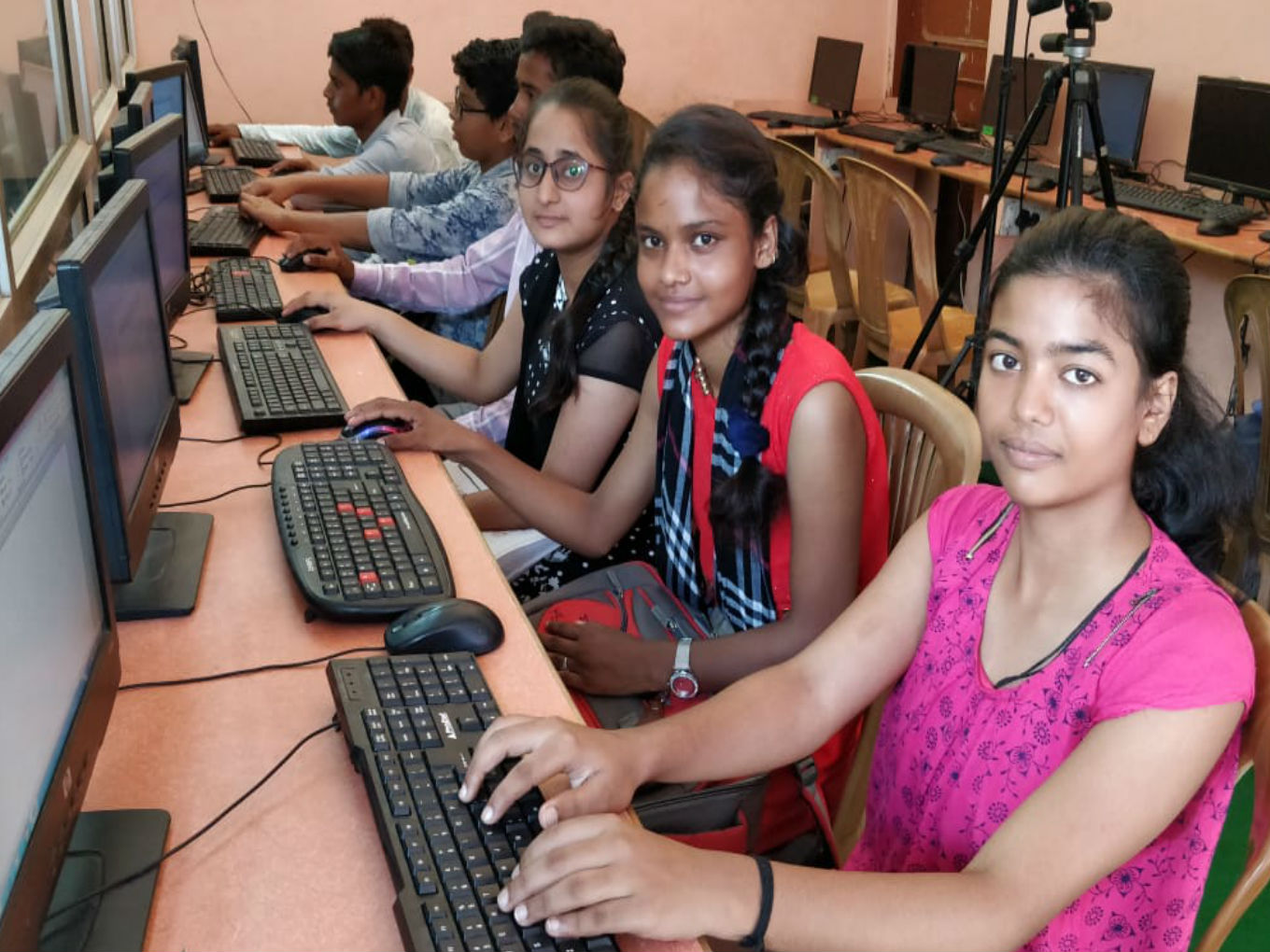
Share this – ![]() Share |
Share | ![]() Share |
Share | ![]() Share |
Share | ![]() Share
Share
How Krishi Vigyan Kendra Is Empowering Farmers With Tech And Digital Tools
After three hours on the road, we stepped into Bharatpur city. The first destination for us was the Krishi Vigyan Kendra, which are district-level institutions helping farmers with the latest agricultural technologies. It was here that we met Dr Amar Singh, a senior scientist who heads the Krishi Vigyan Kendra and is the dean of Krishi Maha Vidyalaya.
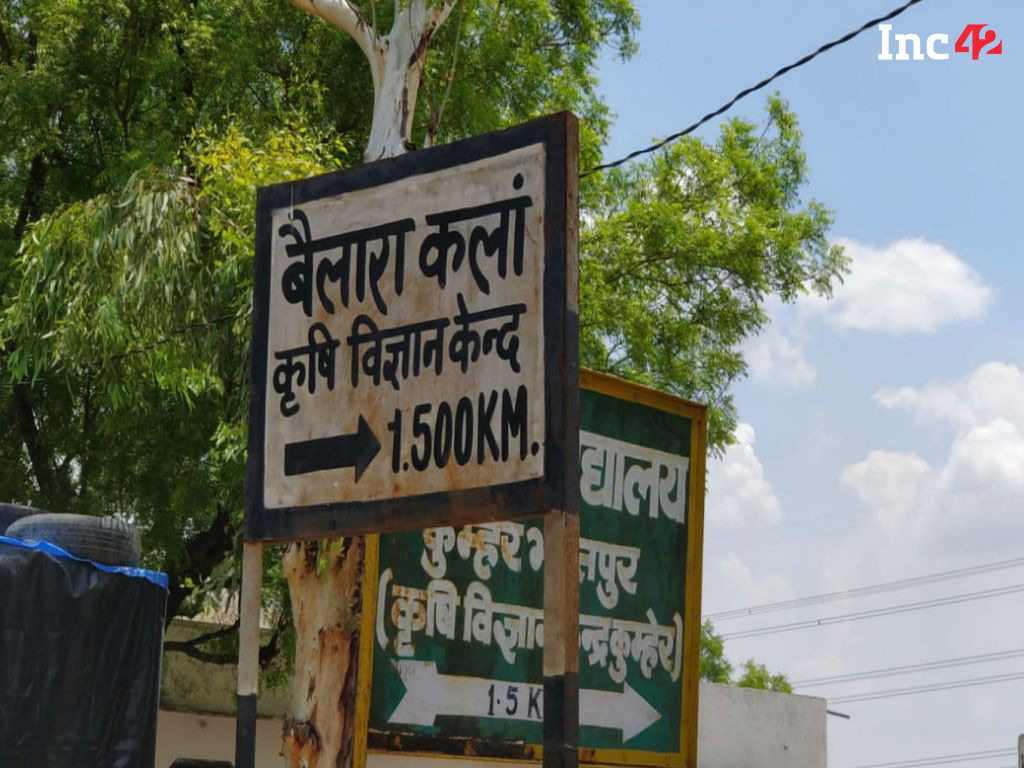
Singh, who joined Krishi Vigyan in 2005, told us how, over the years, technology has become critical for agriculture. Several digital initiatives are being undertaken at the centre to educate farmers in the use of technology enabled solutions.
Out of the 1,600 villages in and around Bharatpur, about 1,400 to 1,500 are in touch with the Krishi Vigyan Kendra. The centre aspires to familiarise at least 10-15 farmers from each block with the Digital India mission.
With a view to help farmers make the most of a farming season, the Krishi Vigyan Kendra sends voice and text messages regularly to farmers on best practices to grow crops, use of pesticides, climate information, etc.
Singh feels that digitalisation is a boon for even uneducated farmers who can’t read because they can watch videos to understand applications of technology in agriculture. To motivate farmers who come in for training at the centre to adopt new technology, the centre plays the success stories of other farmers.
Bharatpur is a flood-prone area and Krishi Vigyan Kendra is currently working on digital tools to help farmers deal with floods better with an aim to double their income by 2022. The centre even has an automated weather mechanisms in place to help disseminate information about rain to the farmers in different areas.
Previously, the centre used to see interest from farmers and their wives wanting to learn about technology, but these many unemployed youth also enrol in short-term training courses, ranging from 10 to 90 days. Apart from this, the centre conducts sewing classes for women, trains both women and youth in horticulture, facilitating not only learning but also improving their chances of making a livelihood.
We asked Singh why would the youth, who are aware of the importance of technology in today’s world, choose traditional agriculture, he said, “It’s important that we change our ways of traditional agriculture and adopt digitalisation to reduce the time between harvesting and the produce reaching the consumer. This would encourage the youth to join agriculture.’’
Singh said that the eNAM or the National Agriculture Market initiative — an online trading platform for agricultural commodities in India — has helped farmers immensely by eliminating middlemen. For decades, middlemen have been eating away the bulk of the farming profit, leaving nothing for farmers. Thanks to eNAM, farmers are getting fair prices. They have also become aware of the prevailing prices of different types of produce in various mandis because of eNAM. This information enables them to sell their produce at the best price.
He, however, believes that the government still needs to spread awareness about such initiatives and cast its net wider to ensure that more farmers come under the ambit of such initiatives, especially from lower-level mandis.
Overall, Singh is optimistic about the digital drive across India as it has enabled accountability of income, access to cross-border technology, etc. Although farmers are still wary about selling online to private companies as they are afraid of being cheated, he added that a government facilitator would make them more confident about selling produce online.
The Rajasthan government is striving to empower each block with small-scale technologies, both software and hardware, so that farmers are up to date new new farming techniques.
The dismal scenario of farmers in India did not seems so dismal after our chat with Amar Singh. And it was time to gear up again and move on to our next digital discussion in digital Rajasthan.
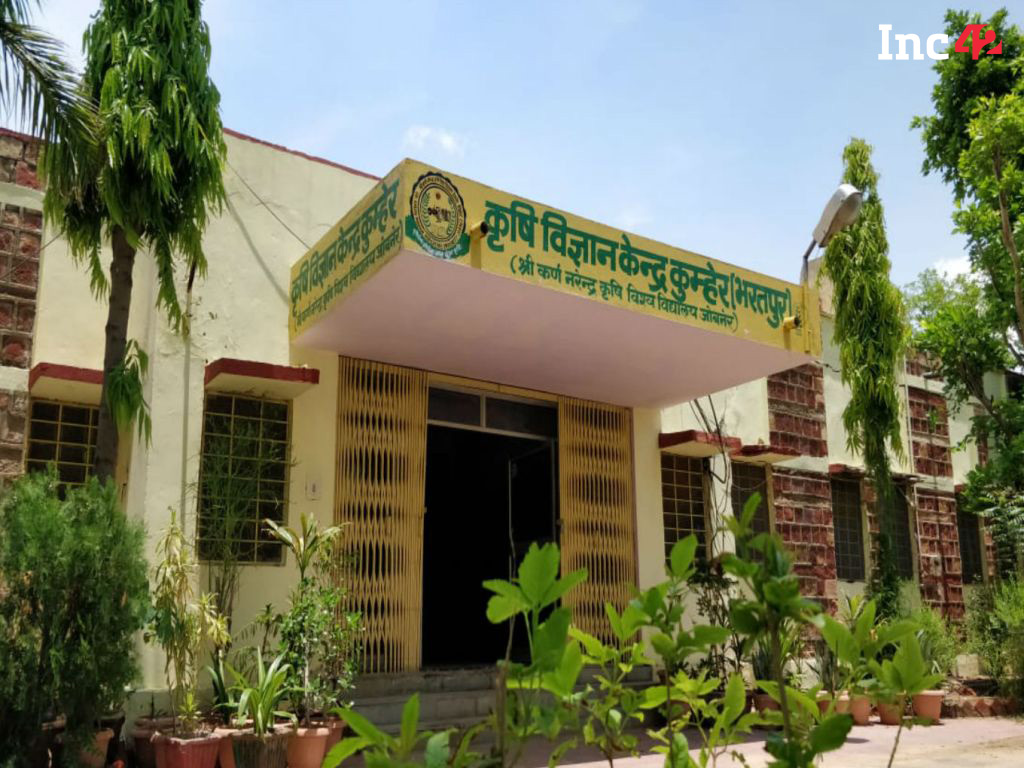
Share this – ![]() Share |
Share | ![]() Share |
Share | ![]() Share |
Share | ![]() Share
Share
Day 9: July 16, 9:30 AM
Team Inc42 Now Heading Towards Bharatpur
We have packed our bags and are on the road again. The destination today is Bharatpur. We have high hopes of getting to meet some more interesting people and bringing you some more interesting stories of how digitisation is changing the lives of the people in the city.
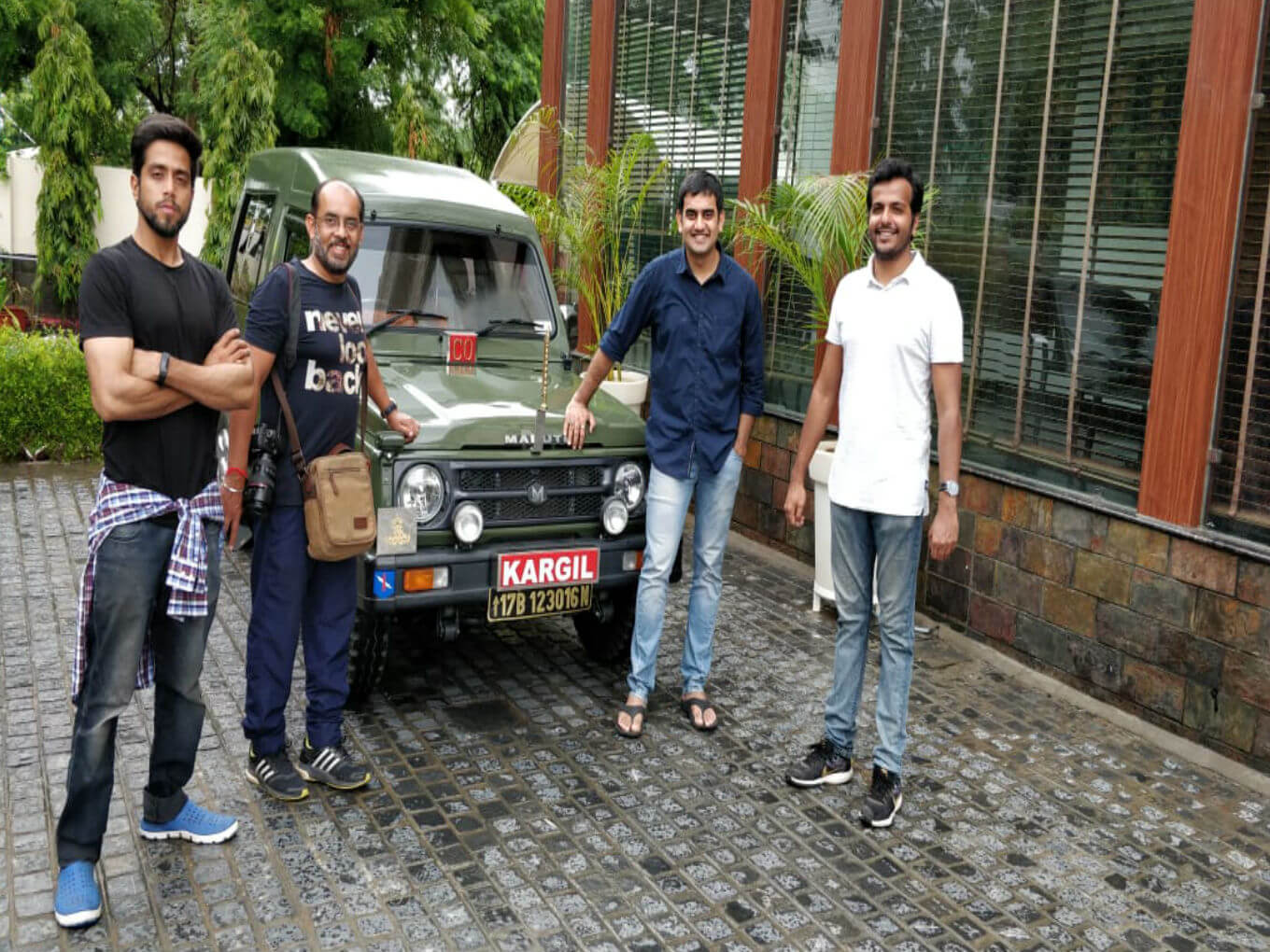
Share this – ![]() Share |
Share | ![]() Share |
Share | ![]() Share |
Share | ![]() Share
Share
How Digitisation Brought Alwar’s Famous Kalakand Online
If you are in Alwar, you simply have to taste the famous Alwar kalakand (an Indian milk cake made of solidified, sweetened milk and paneer). So, after finishing our meeting with auxiliary nurse midwives (ANMs), we headed towards Baba Thakur Das & Sons, one of the most famous and oldest sweet shops in the city.

We were pleasantly surprised to find that the owners of the shop, brothers Abhishek Taneja (36) and Ashish Taneja (33), are quite tech savvy. They even sell their mithai on an online platform and have tie-ups with the likes of Amazon, Flavours Of My City and Place Of Origin.
“We deliver sweets across India within three days. We have friends who encouraged us and informed us about the benefits of going online,” said Abhishek.
Abhishek shared with us the story of how their Grandfather, the late Baba Thakur Das, started his kalakand venture.
Thakur Das came to India in 1947 from Pakistan and opened a shop (the first one) in the old city. When he started selling kalakand, there was a rumour that the sweetmeat was is red in colour because he used non-vegetarian ingredients. So, he conducted a public demonstration of how the kalakand at his shop is made, after which the sweetmeat gained immense popularity among the residents of the city.
Today, the Tanejas have three outlets in and around Alwar (one in the old city, two in the main city, and one on the highway).
In their current business model, they don’t have to pay any fees to be a part of the online marketplaces they have tied up with. They receive emails from online platforms about the orders, which are processed by the shop and the orders are sent via couriers.
Many online marketplaces have their own logistics/courier companies while some others use FedEx because of the quality of service and on-time delivery. The online platforms provide their own packaging for shipment.
“The courier guy collects the shipment every day at 7:30 PM. They have a tie-up with FedEx, which delivers very fast, an important requirement since sweets are perishable. The GST has had a positive impact on our business. Tax on khoya (thickened milk), one of the major ingredients of kalakand, has reduced from 5.5% to 5%,” said Abhishek.
And the profit from the extra sales is certainly sweet. Daily online sales for the sweet shop is around 60–80 kg.
The over-the-counter price of the milk cake is INR 320 per kg and it is sold at INR 530 per kg on these online platforms. The Tanejas charge the counter rate for the online orders and the platform adds its fee and delivery charges to the bill amount.
“We register the maximum sales on Flavours of My City and Place of Origin. We don’t sell all that much on Amazon because it is a big platform offering various products. The other two are dedicated food platforms and hence sales is higher on them,” added Ashish.
The brothers are happy that digitisation has enabled them to boost the business and establish a pan-India presence. They claim that the online business has increased their total sales by 30% on an year-on-year basis.

Initially, they found the digital paperwork — e-returns, e-filing of business documents and monthly/quarterly sales and purchase — a hassle, but, with time, they have adopted an efficient process and are comfortable with it now. They feel going online is the need of the hour most any business these days.
Further, to their advantage, the demonetisation drive accelerated digital payment adoption in the country. Around 20% of their customers prefer e-payments over cash-on-delivery; they mostly order from the second and third outlets, which are not in the old city.
Typically, tourists and visitors prefer to make payments through card. They use online banking to check account statements, make bookings, etc, but have not taken to e-transactions in the business that well.
We thoroughly enjoyed our stay in Alwar. With a taste of the kalaland still in our mouths and excited about the impact digitisation is having on the lives of people in Rajasthan, we headed towards our hotel for some rest before we started on our next day’s journey to Bharatpur.

Share this – ![]() Share |
Share | ![]() Share |
Share | ![]() Share |
Share | ![]() Share
Share
Healthcare In Alwar: A Focal Point
Village: Nangal Saliya
Tehsil: Kot Kasim
District: Alwar
Participants: Anganwadi manager, along with village women (expecting & young mothers): Rajita Devi, Pooja, Ritu, Komal, Anju Devi; Kamlesh Devi (Asha Worker)
The Inc42 team interacted with these women to understand the quality and delivery of healthcare they receive in Alwar.
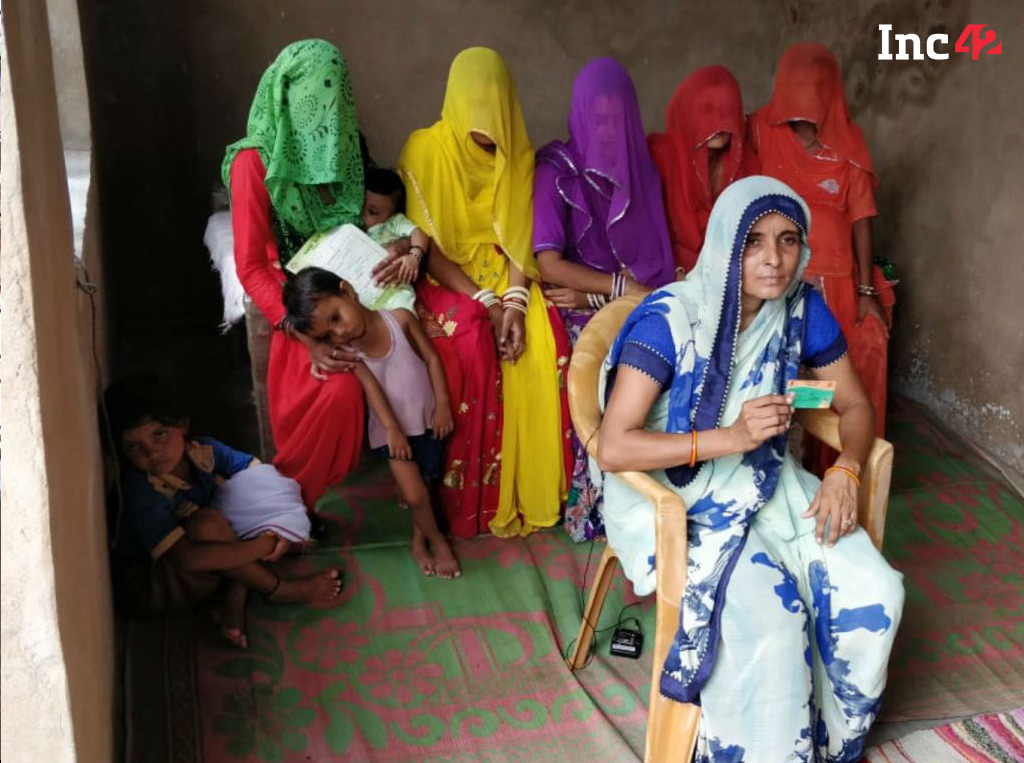
Share this – ![]() Share |
Share | ![]() Share |
Share | ![]() Share |
Share | ![]() Share
Share
How Students At BITS Pilani Are Digitally Empowering People At The Grassroots
During our visit to Jhunjhunu, Inc42 met Divyansh Saini, who has studied bio-sciences at Birla Institute of Technology and Science (BITS). At present, Divyansh is working for SocialCops, a data intelligence company based in New Delhi.
He talked to us about the activities of the Centre For Entrepreneurial Leadership (CEL) at BITS, which he was a part of. The CEL was founded in 2004 with the mandate of fostering entrepreneurship in each student.
The centre invites startup founders to give talks to enable the students to understand what goes into building a startup and imbibe learnings from successful startups. Divyansh said, “In Startup Sphere sessions, we have startup founders talks about their journeys.’’
Apart from this, CEL provides students links to inspirational talks on a monthly or weekly basis. After the second year, students undergo compulsory internships and it’s a trend in the college to start working early. The centre helps the students secure internships at startups. In the past, Zomato and Innerchef have hired interns from the institute.
Right after demonetisation, the students started an initiative called Digital Pilani. This was triggered by the realisation that the students didn’t have cash and, hence, could not pay the vendors on campus. They partnered with a digital payments company and sent out two representatives to spread awareness and help vendors understand how they could shift to online payments.
The students, Divyansh told us, went to a village called Rila, where most of the workers who worked on the campus lived. These people were facing major problems because of the cash crunch and the students explained to them how digital payments work.
They were a bit wary and the students had a tough time explaining to them that it wasn’t a scam. They also explained to them how digital payments would help them in future.
Divyansh shared with us how, in his four years at Pilani, he’s seen big and small vendors take steps towards digital payments. Owing to Jio, many people can now afford mobile Internet services, which enables them to get weather updates and do other activities online.
He said that the advantage of being in Pilani, Rajasthan, was that the students there connected with the problems people face at the grassroots and feel encouraged to come up with solutions for them, similar to the idea of Redbus, which was born out of founder’s personal experience of not finding a bus service when he needed one.
All big things start with an idea — isn’t it?
With that we ended our trip to Jhunjhunu and head off towards our next stop.
Share this – ![]() Share |
Share | ![]() Share |
Share | ![]() Share |
Share | ![]() Share
Share
PIED Is Giving Wings To Startups With A Focus On Technology And Social Impact
On Day 7, while visiting Jhunjhunu district, Team Inc42 met Kumaran Nathan, Asst. Manager (Technology Business Incubator – BITS Pilani)’who works at the Pilani Institute of Entrepreneurship and Development (PIED), started in 2004. Nathan told us how Pilani is focussing on incubating startups. PIED is keen on startups that have a technology focus and are looking to have a social impact. PIED has incubated 38 startups this far.
The institute invites proposals from startups looking for seed funding through an advertisement on the website of the institute and through root mails sent to all students.
Criteria For Pre-screening of Startup Proposals:
- Innovation in the idea
- Timeline for the conversion of the product/services
- Market potential of the product to be developed
- Potential for scaling up
- Market research done by the team
- Financial projections given by the team
- Break-even period
- Team strength (experience, skill set)
- IPR registration/application
- Potential of the team to induct funds
When a startup proposal is received, the selection committee assesses the proposal and accordingly makes recommendations, after which the seed funds are sanctioned and approved by the chairman.
Kumaran mentioned that the review process followed by PIED Society for selecting startup proposals for the seed funding is as follows:
- A two-round review process is followed for the proposals received for seed grant. In the first round, all proposals received for availing of the seed grant scheme are sent to the committee members for a review. Proposals are assessed on the basis of the innovation involved, market need, scalability, team strength, etc.
- In the second round, the shortlisted proposals are invited to present their proposal in front of an executive committee either physically or via a video conference. During the presentation, they may showcase their prototype. The teams are thoroughly questioned on innovation, market need, target customers, customers feedback, marketing strategy, competitive strategy, financials, etc.
After thorough discussions, committee members take a decision on which proposals should be supported and the quantum of funding to be approved.
Redbus is one of the most noteworthy companies to have been incubated at PIED. The incubation process is generally for 12 months with a six-month extension, if required.
After gaining these insights from Kumaran on PIED and what it is doing to nurture the seed of startups in the country, it was time for us to move on to our next destination in Digital Rajasthan Yatra 2!
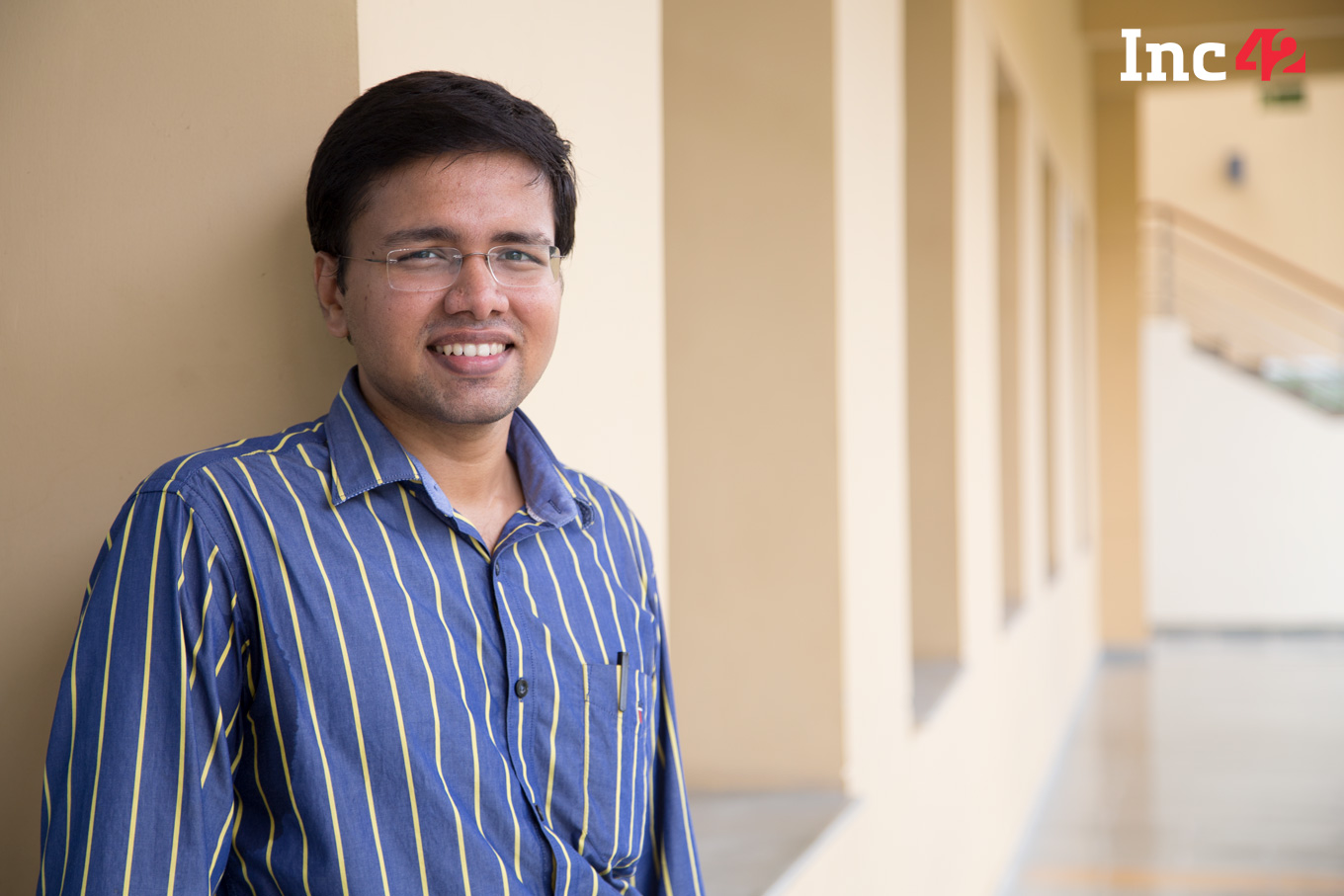
Share this – ![]() Share |
Share | ![]() Share |
Share | ![]() Share |
Share | ![]() Share
Share
Digitisation & Empowerment In The Deepest Corners Of Rajasthan
Place: Jhunjhunu & Sikar
Part 1 – 12:00 pm
Day 7 started with team Inc42 visiting Jhunjhunu district. It was here that we met Kumaran Nathan, who works as an assistant manager at the Pilani institute of entrepreneurship and development (PIED). Pilani is leveraging all aspects of digitisation to leapfrog its journey. Kumaran Nathan told us that PIED has an incubation programme under which it looks for ideas with a technology focus and those with an social impact. Since 2004, PIED has incubated 38 startups; at present, eight startups are being incubated under the programme.
Redbus is one of the most noteworthy companies to have been incubated here. The incubation process is 12 months, with a six month extension if required.
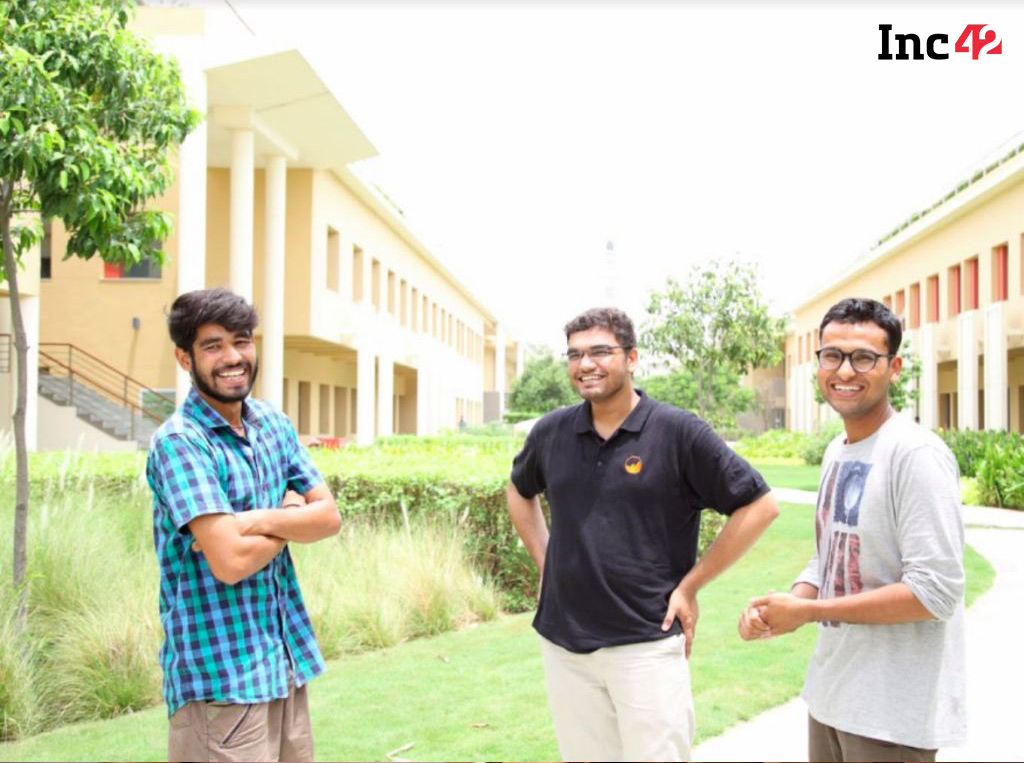
Part 2 – 4:00 PM
In the second half of Day 7, Team Inc42 went back to Sikar and we met auxiliary nurse midwives (ANM) Anju Kachwal (40) and Pinky 23 and Asha workers (Accredited Social Health Activists) Sumitra Mathur (50), Ranjita (35), and Babita Sharma (43).
All of them work with low-income families, where the monthly income of the families was between INR 3,000 – INR 5,000, providing ante- and post-natal healthcare to women. They help women get Aadhar and Bhamashah cards and bank accounts and then they link alll of these online to help them avail of healthcare benefits and information.
Insights on ante- and post-natal healthcare for women in Alwar:
- Overall, the women of Alwar were very satisfied with the healthcare benefits being provided to them
2. Institutional deliveries for babies have increased and there are lesser deliveries now overall
3. The women are open to the idea of delivery through surgery, because the expenses are covered.
4. There has been a decrease in infant mortality rate and maternal mortality rate
5. Online database management & monitoring, especially timely vaccinations, has helped the ANMs and ASHA workers deliver almost 95-98% success in their work
6. Healthcare penetration has significantly increased in low-income muslim pockets
However, ANM and ASHA workers feel that their incentives and salaries are very low. They make a mere INR 1,500-2,000 per month and feel that this is way too little for the work they do.
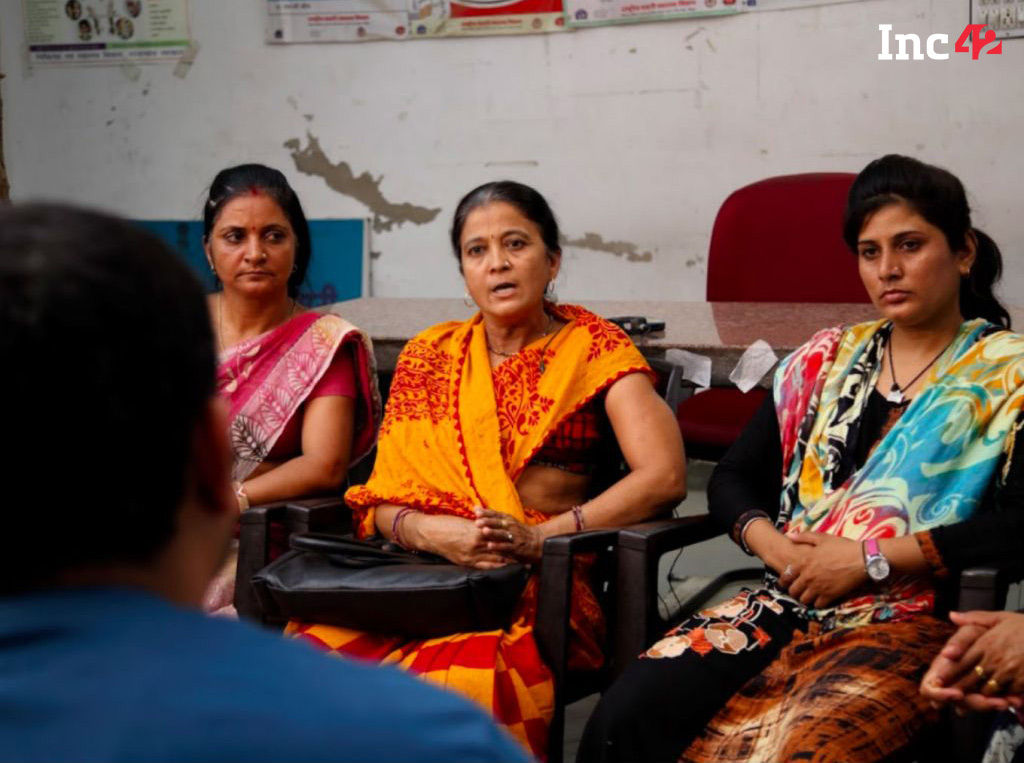
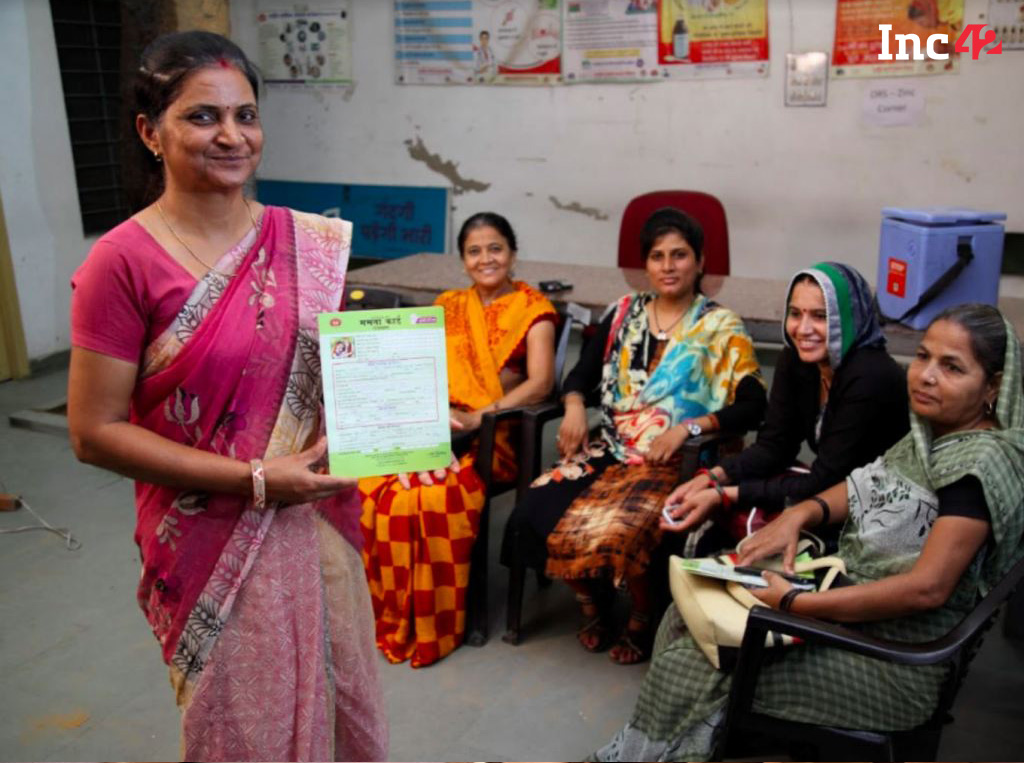
Further updates are awaited on Day 7 as Team Inc42 traverses through the villages and towns of Rajasthan.
Share this – ![]() Share |
Share | ![]() Share |
Share | ![]() Share |
Share | ![]() Share
Share
Sikar: Interactive Learning, Smart Classes & A Desire To Make A Difference!
Place: Sikar
Participants: Teachers: Archana Sharma & Swant Ram Yogi; Students: Anisha Sharma (Class XI), Manu Sharma (Class VIII), and Jyothi Sharma (Class XI)
After learning about the various initiatives taken by principal Vinod Sharma and others at Govt. Senior Secondary School Holiyakabas (Sikar), we interacted with a few teachers and students to understand their perspectives.
Archana Sharma is a Level II Hindi teacher who was transferred to this school from Jodhpur. She said, “This school, because of its various facilities and initiatives like reciting of devotional songs using loudspeakers, is very different from a normal government school. I feel a huge sense of fulfilment in working here.”
Teachers too are participating in the change here. Sawant Ram Yogi, for instance, rallied with the villagers to get crowdsourcing for the costs of the school. His children study in classes VIII and XI in the same school.
The students told us why they like studying at the school.
Anisha Sharma, a Class XI student, wants to work for the government when she grows up. She feels that studying in an environment like this, she will get a sense of real grassroots problems and how to solve them. She believes that studying in an expensive private school would not serve this purpose.
Another student, Manu Sharma, who studies in Class VIII, and recently shifted to Sikar from Delhi with his family, told us that although shifting from English to Hindi medium was intimidating at first, his teachers were encouraging and patient. The biggest incentive for him to study in this school is the smart classes.
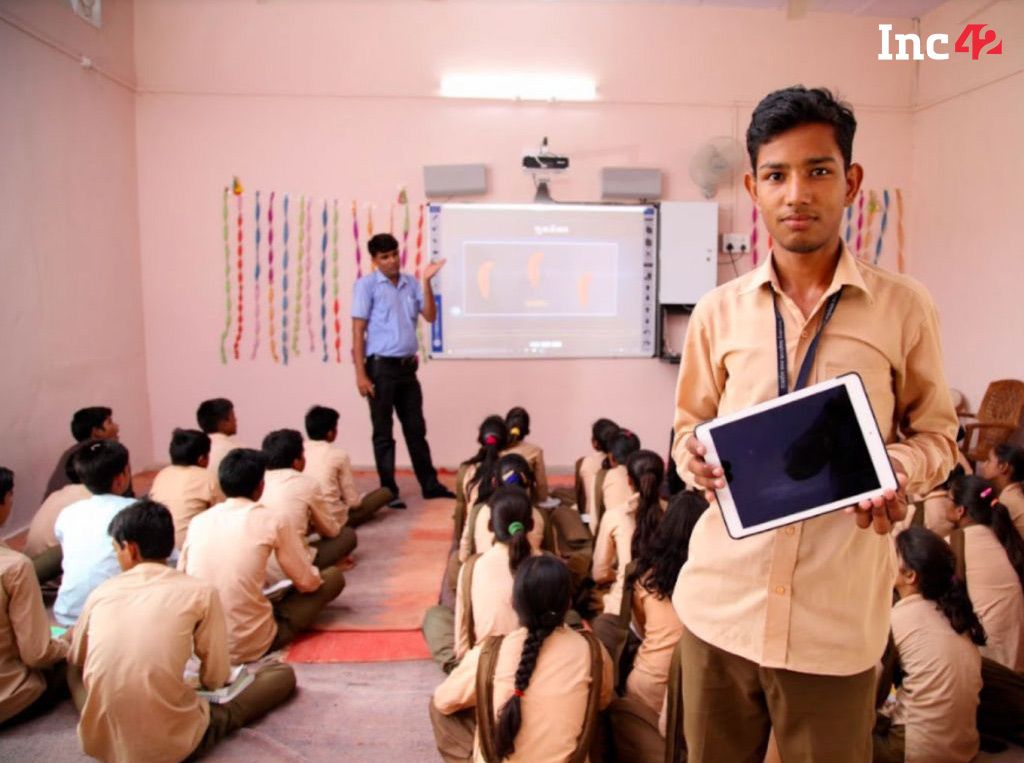
Jyothi Sharma has been studying at Govt. Senior Secondary School Holiyakabas (Sikar) since Class I. She highlighted the security aspect at her school, which has installed CCTV cameras to monitor the school premises. Girl students also get bicycles from the government from Class VIII onwards, which helps them commute to the school.
Studying in this small government school is not a shame but rather a privilege and a matter of pride.
One of the most interesting and common behavioural changes in the students is that after the introduction of smart classes, they can learn about topics and concepts that they couldn’t understand well from books, especially on subjects such as the human body, geography & English. The students told us that after attending the smart classes, they go back home and explain the concepts to their family members and friends.
The students said they look forward to the smart classes the most so much that they sometimes get into friendly quarrels with their teachers if other classes get to attend the smart classes before they do. The children were also happy that the school provides them milk three days a week, apart from the educational benefits.
Govt. Senior Secondary School Holiyakabas (Sikar) gave us a fresh perspective on government schools. Smart classes and the community outlook of students, teachers, and villagers are the primary reasons for the progress this school has seen. The initiatives taken by the school attract other students to join it.
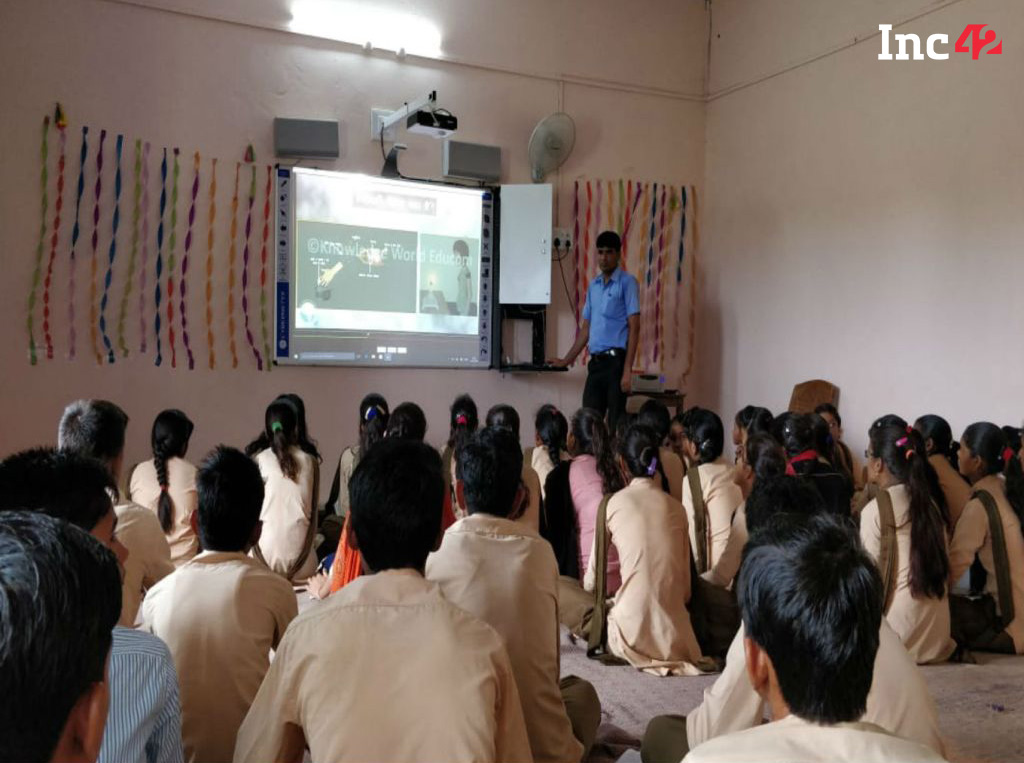
With this, the Inc42 team sped off to its next destination, smiles on our faces thanks to the wonderful interaction!
Share this – ![]() Share |
Share | ![]() Share |
Share | ![]() Share |
Share | ![]() Share
Share
How A Forward-Thinking Principal Is Redefining Education For Students In Sikar
Place: Sikar
Participant name: Vinod Sharma
On Day 6 of Digital Rajasthan Yatra II, Team Inc42 met Vinod Sharma, the principal of Rajkiya Uchch Madhyamik Vidyalaya, in Sikar. Sharma has been the principal of the school since May 8, 2013. The total strength of the school is around 450 students, studying in Classes I to XII.
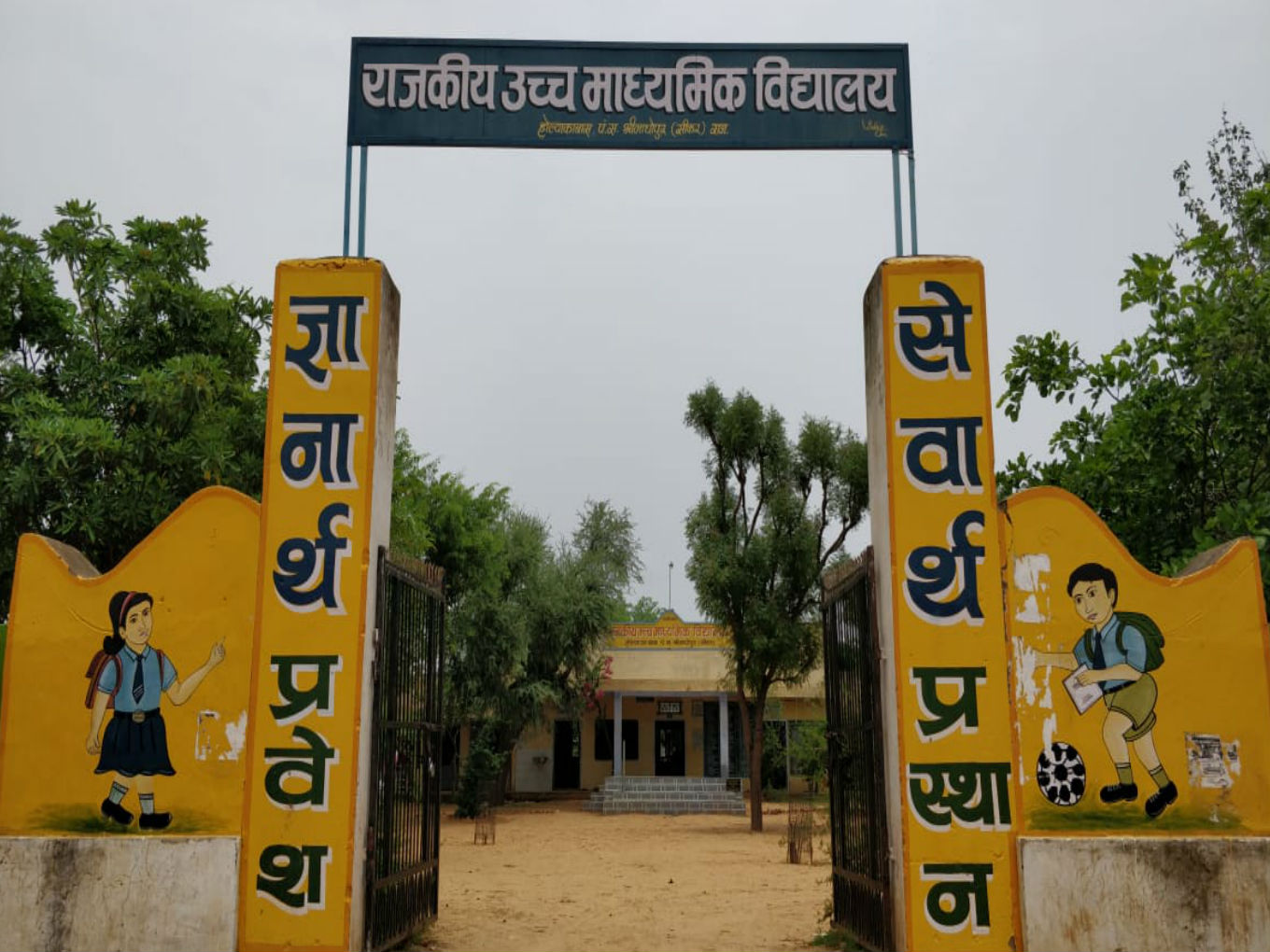
Digital Classrooms For Learning
A visit to a private school and a look at the amenities available there inspired Vinod Sharma to replicate the standards and practices at the government school where he was working.
“Curiosity is the seed for learning. The role of the teacher is not just to teach in classes, but generate curiosity in the minds of the children,” said Sharma.
He wanted to introduce smart classes and spoke to the village residents to crowdsource resources for the project. Initially, the villagers were wary of Sharma’s plans for the school which involved embracing new-age digital technologies to enhance learning & education. But, eventually, he managed to convince them and everything started falling in place.
One of the patrons of the school donated about INR 2.5 Lakh for the digital classroom infrastructure comprising a projector, a touchscreen, touchscreen pens, sound system, etc.
The e-content for the courses, worth about INR 35,000, was provided by a company in Jodhpur which specialises in Rajasthan State board subjects. The e-content is saved in password-protected pen drives and can not be copied and distributed. Every class has separate pen drives containing the study material, segregated according to the subjects.
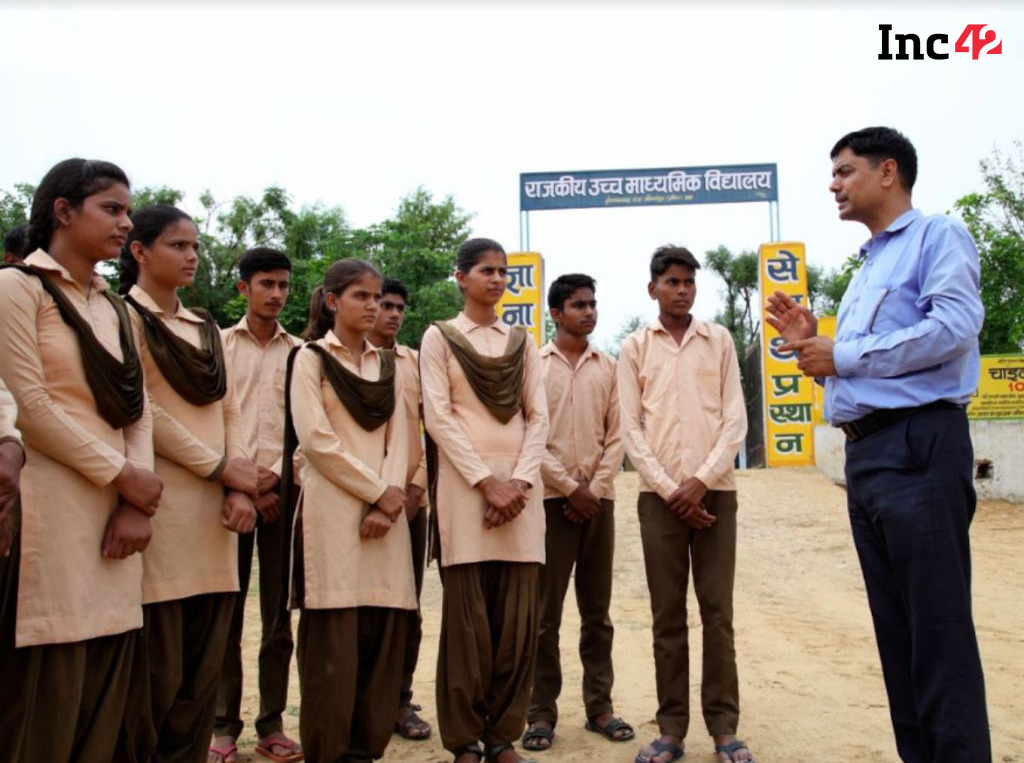
Salient Features Of The e-Content:
- The cost of the e-content is higher than that of CBSE content, which ranges between INR 10,000 – INR 12,000, because it has to be specially designed as per the state board’s syllabus
- Many teachers were not well versed with computers and e-learning techniques but they showed great enthusiasm for the smart classes
- The school uses a BSNL Internet connection to facilitate smart classes
- Currently, the smart class infrastructure is installed in only one classroom where teachers continuously teach classes I to XII
- Sometimes, they combine classes to enable enhanced learning and interaction between students of different age groups. They introduce basic concepts of science, grammar, geography and history through these combined classes. The principal also attends these classes sometimes to keep a check on their quality
- The visual learning method has had a good impact on the students. They’re now able to understand concepts better
- The children’s curiosity has also seen a rise. Seeing visuals of abstract math and science concepts piques their curiosity and they ask a lot more questions, resulting in better learning and improved exam results
- Currently, all the school teachers are trained to run smart classes on their own (their subjects)
A Holistic Approach to Learning
- The Rajasthan Knowledge Corporation Limited and the Rajasthan State Certificate Course in Information Technology (RSCIT) runs courses for government teachers with the purpose of acquainting them with computers and digital learning
- Under the ‘Click’ scheme of the Rajasthan government, many public schools have tied up with agencies to provide computer education to the students. Parents are expected to pay a nominal monthly fee of around INR 80 to INR 120 per month per child, around INR 1,000 to INR 1,500 per year, for all the subjects
- Initially, the villagers asked Sharma why did he want to crowdsource to implement smart classes when eventually the Click scheme would eventually come to their school
- The principal explained to them there were two reasons. One, in this digital age, every child should embraces technology as early as he/she can. Second, through the ‘Click’ scheme, parents would have to pay for the computer classes, which wouldn’t be required under e-learning. So, he equipped the school with e-learning facilities
Challenges And Achievements Along The Way
Govt. Senior Secondary School Holiyakabas (Sikar) had a lot of infrastructural problems when Vinod Sharma joined as the principal — there weren’t even fans in the classrooms. Sharma sought the help of the villagers to improve the infrastructure and received resounding supported in his vision to provide good education to the children.
The school collected a donation of INR 38 Lakh, of which INR 20 Lakh was given by the villagers in kind and INR 18 Lakh came from different government funds. It is the first government school in the district where the staff wear uniforms. Inspired by this school, the collector of Nagaur declared a dress code for government school teachers across the district.
Govt. Senior Secondary School Holiyakabas (Sikar) is adopting new and innovative ways of interaction, development, and learning for its students. In the morning assembly, school teachers play musical instruments, children read out news headlines, and discuss general knowledge topics. Every classroom in the school is named after a great personality depicting their achievements. Every Saturday, the students play a modified version of musical tables where they revise multiplication tables to the beats of musical instruments.
Apart from learning, the school lays a lot of stress on hygiene. Sanitary napkin dispensers are installed at the school. Clean drinking water and washrooms are also available. The villagers have such faith in the school’s teaching methods that even those who can afford private schools send their children to this school.
Crowdfunding: How community effort can make a school great
People and institutions generously donated to the school — school uniforms, playground slides, greenboards, furniture — so as to create a good learning environment for the children and equip it with amenities like those at private schools. Regular MTM (mother-teachers meet) and PTM (parents-teachers meet) are conducted at the school.
MTM is a very interesting concept. More than 250 mothers are invited along with their children to visit the school and see for themselves the facilities and education being provided to their children.
Every year, the school hosts grand ceremonies on August 15 and January 26, which are attended by almost 1,000 students and adults who donate to the school. These donations and funds received from the Mukhyamantri Jan Sahbhagita Yojana (MJSY) are used in the development and functioning of the school. Roughly, 40% of the amount comes from donors and 60% from the government.
The school is now planning to utilise this money to build more smart classes and also to buy learning aids that will enable the students to get more practical learning and experiences. The school staff also contributes to the development of the school by giving donations on the Gyaan Sankalp portal of the state government.
Just like any other corporate organisation, the school shares a detailed report of expenditure with the donors and villagers in the meetings. This helps in building trust among donors and urges them to donate more.
The school takes cognisance of good performers and takes necessary measures to encourage them and thus other students. One of its meritorious students attained 89% in her Class XII boards and is currently studying at Maharani College, Jaipur. She even got a scooty from the government as a token of appreciation. The school wants to make a name as a producer of top talent with the use of technology and digital classes.
The villagers also donated to make a temple of Goddess Saraswati on the school premises.
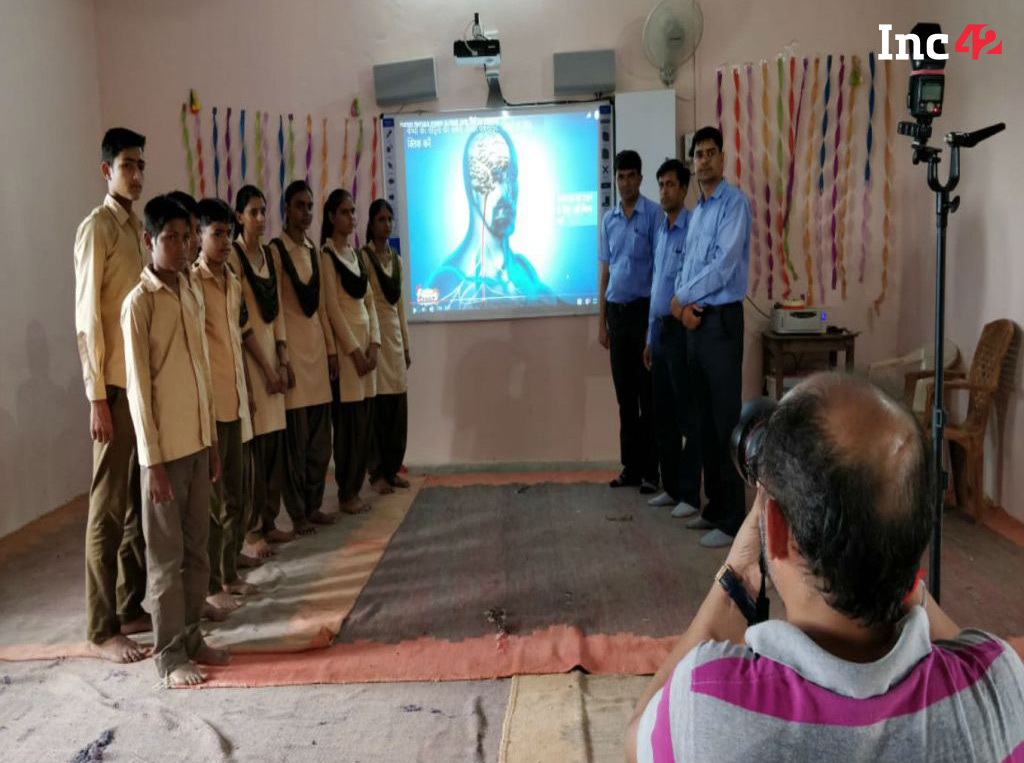
Future Opportunities & Challenges
Principal Vinod Sharma and the school management are selective about accepting donations in kind. They turn down donations for fans, water coolers or black boards as the school already has these. At present, it needs funds to build more smart classes, install computers, tablets, and audio-visual aids for children. The school is trying to build an additional digital classroom and a new computer lab is already under construction.
At present, there is no science faculty for classes XI and XII. Students have to travel all the way to Sri Madhopur if they want to specialise in science. Some others are compelled to go to private schools where the fees are high. The school has requested the state government to appoint science teachers in the school, but the application is still pending.
The students understand the importance of technology and are highly enthused about being able to learn it so early in life. Parents, meanwhile, have a lot of positive feedback for the school.
Govt. Senior Secondary School Holiyakabas (Sikar) was established in the pre-Independence period, said Sharma, adding that his father too studied in this school. It is a great honour for him to be the principal of the school and take it and its students towards a new era of digitalisation.
Share this – ![]() Share |
Share | ![]() Share |
Share | ![]() Share |
Share | ![]() Share
Share
Improving Mother And Child Care In Rajasthan Villages Through Digitisation
Place: Delwara, Rajsamand district
Participant: Dr Vikas Purushottam, Community Health Centre, Medical officer
We’ve been bringing to you ground reports of the digitalisation wave that’s touching every aspect of people’s lives in Rajasthan, in both rural and urban areas. The government is working to make sure that its technology enabled schemes reach the remotest corners of the state, helping citizens to derive the maximum benefits from them.
One such initiative is anganwadi — the primary centre for education as well as healthcare for the people of Rajasthan. Every village has an Asha worker (known as ASHA Sahyogini in Rajasthan), an auxiliary nurse midwife (ANM), and anganwadi workers, who act as three primary agents of healthcare facilities provided by the government.
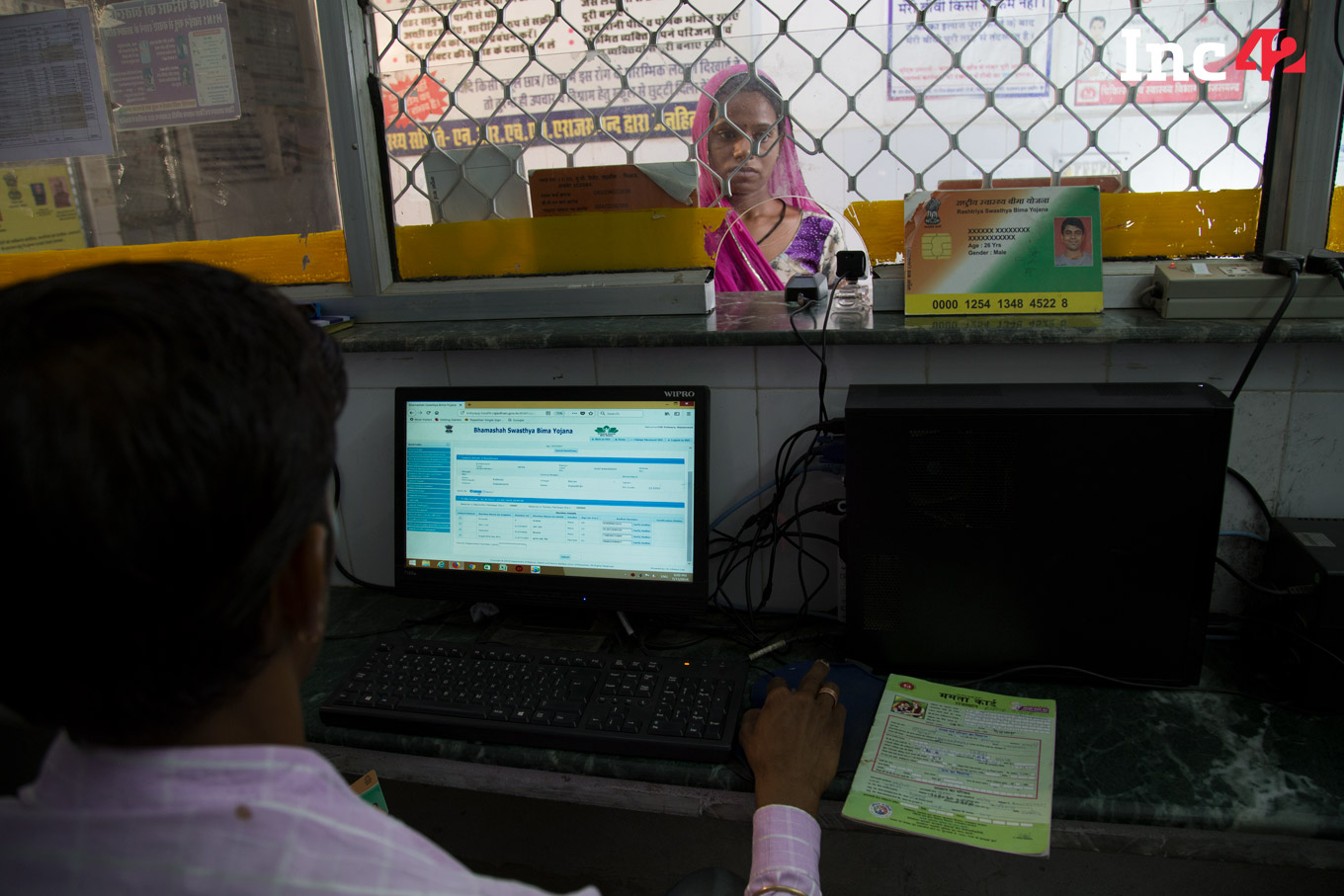
The Day 5 of Digital Rajasthan Yatra II, was majorly a travelling day for us. During our visit to Delwara near Udaipur, we met Dr Vikas Purushottam, a medical officer at a CHC, to understand how these three agents work on the ground.
“You can consider an Asha worker as one of the daughters-in-law of the village. She is close to the people, helps women step into the outside world, and teaches them the basics of education and healthcare. However, her major work spans around antenatal care, pregnancy care, and childbirth, among others,” said Purushottam.
With a view to centralise and smoothen healthcare delivery and monitoring of pregnant females, young mothers and their children, the government has introduced an online system called the Pregnancy and Child Tracking System (PCTS).
Apart from primary health centres (PHCs) and community health centres (CHCs), there are sub-centres in villages with three-four anganwadis reporting to each sub-centre. The Asha workers file reports on antenatal and post-natal cases at these sub-centres. ANMs, who work directly at the centres, record the cases and take them forward to primary health centre (PHC)/community health centre (CHC).
The ANMs update the details of pregnant females every month on the PCTS. This is the first entry and contains pregnant females information and details relating to the Bhamashah Card, Aadhaar, bank account details, etc.
Further, high-risk pregnancy females (HRPs) are categorised separately in the PCTS software. A unique ID is generated by the PCTS, which acts as an online record of all the health-related details, etc of the female in question. This ID is valid across Rajasthan and can be used for healthcare services anywhere in the state.
Then there is the Home Based Neonatal Care (HBNC) scheme, under which an Asha worker monitors and takes care of the new mother and child for 42 days after the delivery. Their health status is recorded at pre-fixed times, ranging from four-six times, during the 42-day period.
Purushottam said that earlier it was really difficult for the PHCs and these healthcare agents to monitor pregnant females and child immunisation centrally. The lead time was very high and a lot of time was wasted in communicating things over the phone. Now, the details are updated on a centralised system and everyone is on the same page. This has proved to be one of the biggest benefits of the online record-keeping system for all healthcare officials of the ecosystem.
“However, it is very important for the beneficiaries to keep their documents updated so as to get access of the benefits. The doctors and officials keep telling people to keep their records updated,” he added.
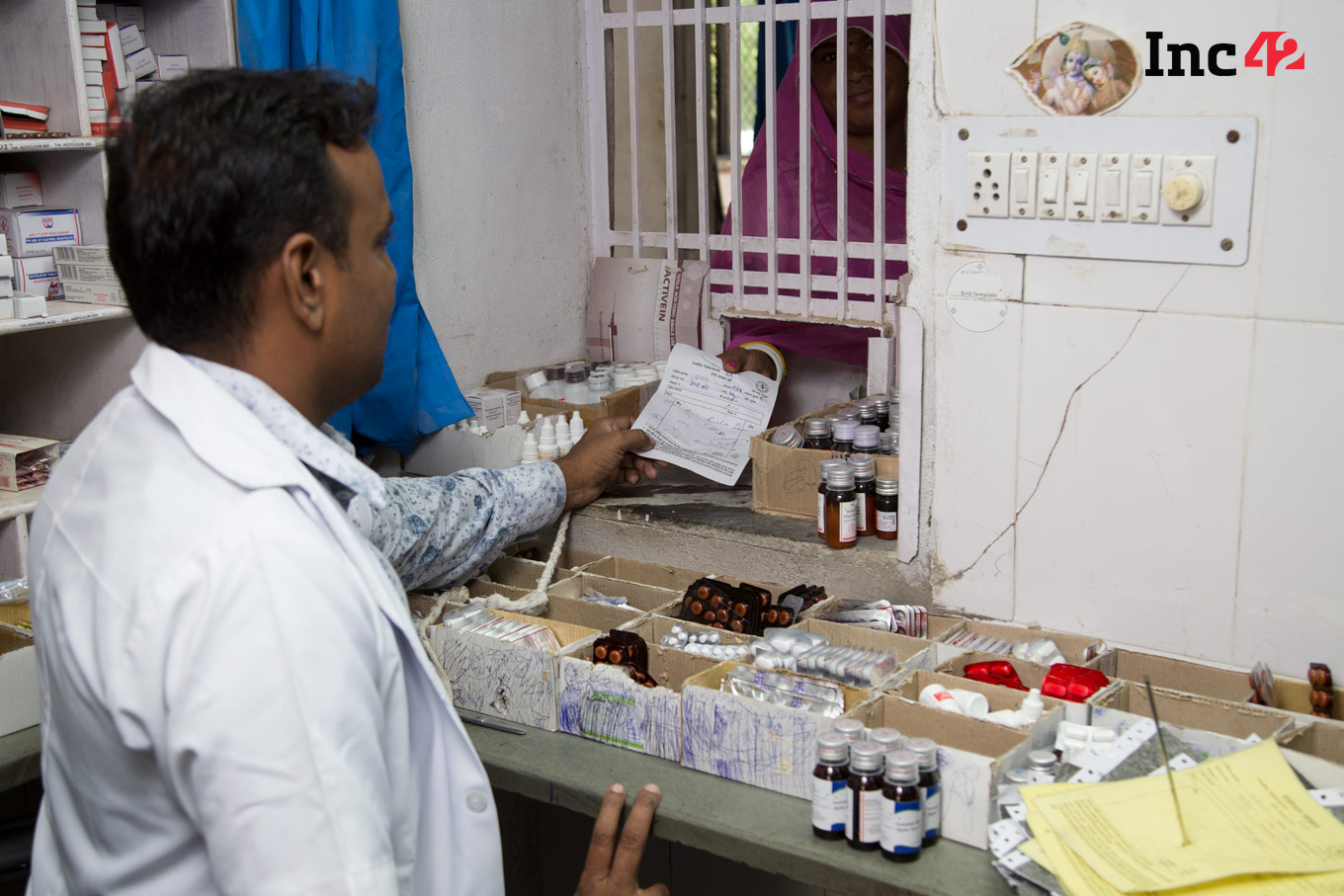
Purushottam shared with us the different schemes launched by the Centre and the Rajasthan government to benefit the village women. Here are a few of them:
- Under the Centre’s Janani Suraksha Yojana, INR 1,400 and INR 1,000 are given to women in rural and urban areas respectively.
- The Rajasthan government’s Rajshree Yojana is an incentive scheme that provides INR 50K to women on the birth of a girl child, in installments. The first installment of INR 2,500 given at the time of birth, then INR 2,500 on completion of one year of immunisation, and so on.
- The Bhamashah Swasthya Bima Yojana, launched in December 2015, provides health insurance to National Food Security Scheme beneficiaries. Only regular beneficiaries of the scheme with active Bhamashah Cards can avail of this benefit.
- The insurance covers about 1,100 ailment packages, divided into secondary and tertiary level care. CHC, sub-divisional hospitals, district hospitals, medical colleges, and government-affiliated private hospitals cover the treatment of these ailments as per the packages available at their centres.
- The maximum annual limit of the scheme is INR 30,000. In case of serious ailments, the healthcare centre requests the government for further assistance and the amount can be raised upto INR 3,00,000, depending upon the case. The request is usually approved in within 48 hours of the request being made.
- Under Kilkari Yojana, which is operational in very few places at present, immunisation and vaccination are provided for free. Women receive voice call reminders on their mobile phones for the due date.
We were also surprised to learn about the number of softwares being utilised at an anganwadi (rural mother and childcare centres) to ensure its hassle-free functioning and for maintaining all the data properly. Let us give you a glimpse of the same:
- There is a special software for Asha workers called Asha Soft, where Asha workers update the details of 42 post-delivery care days under the unique ID generated by the PCTS. The details are automatically updated on the PCTS software.
- Asha workers get their incentives on the basis of the work done by them, which is updated on Asha Soft. Their work is verified by the ANM immediately above them. The incentives are directly transferred into their bank account.
- All the monetary benefits under various government schemes are monitored by the Ojas, an accounting software. The benefits are transferred directly into beneficiaries’ bank accounts.
- OPD (outdoor patients department) receipts are generated via the CPHIS Raj or Arogya Online software. Free receipts are generated on provision of a government-approved ID.
- Records of free medicines are updated on the e-Aushadhi software. This software records the data of each beneficiary with reference to their unique ID. Also, it can be used by the healthcare centre to raise demands for more medicines.
- e-Saadhan is another software through which the healthcare centres communicate the requirement of various contraceptives to the government.
- Nikshay is a centralised software for tuberculosis patient records. This software maintains online records with unique IDs valid across the state and the person is entitled to receive free treatment kit, etc, from PHCs/CHCs anywhere in Rajasthan.
Despite all efforts, there are certain glitches that needs to be sorted, say the doctors. As they suggested, the local vernacular should be used for these voice calls and the voice message should be designed in a way that it catches the attention of the listener.
Digitisation has made it easy for healthcare workers to schedule and plan their work because now they can access all the records online, thus making it possible to foresee future needs. However, the road ahead is still long.
Surprised by the digitisation observed in the streets of Udaipur, the Inc42 team’s next stop is capital city Jaipur.
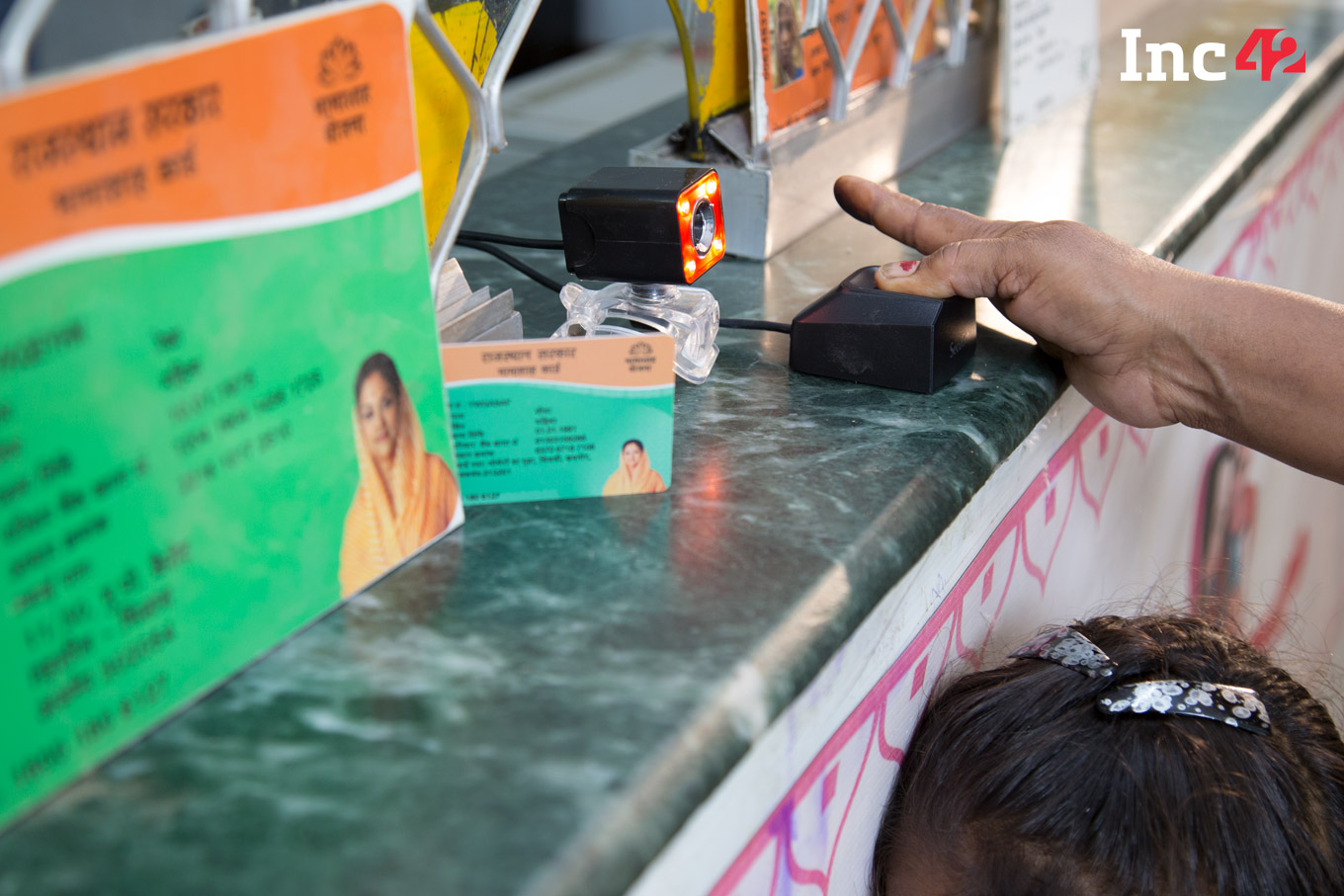
Share this – ![]() Share |
Share | ![]() Share |
Share | ![]() Share |
Share | ![]() Share
Share
Apkamart: This Website Is Improving The Lives Of Women And Artisans In Rajasthan
Place: Udaipur
Participants: Anshul & Sakshi Bansal
On our trip to Udaipur, the Inc42 team met Anshul Bansal and Sakshi Bansal, a married couple, both 34 years old, who founded apkamart.com, a website for selling handicraft products, in 2014.
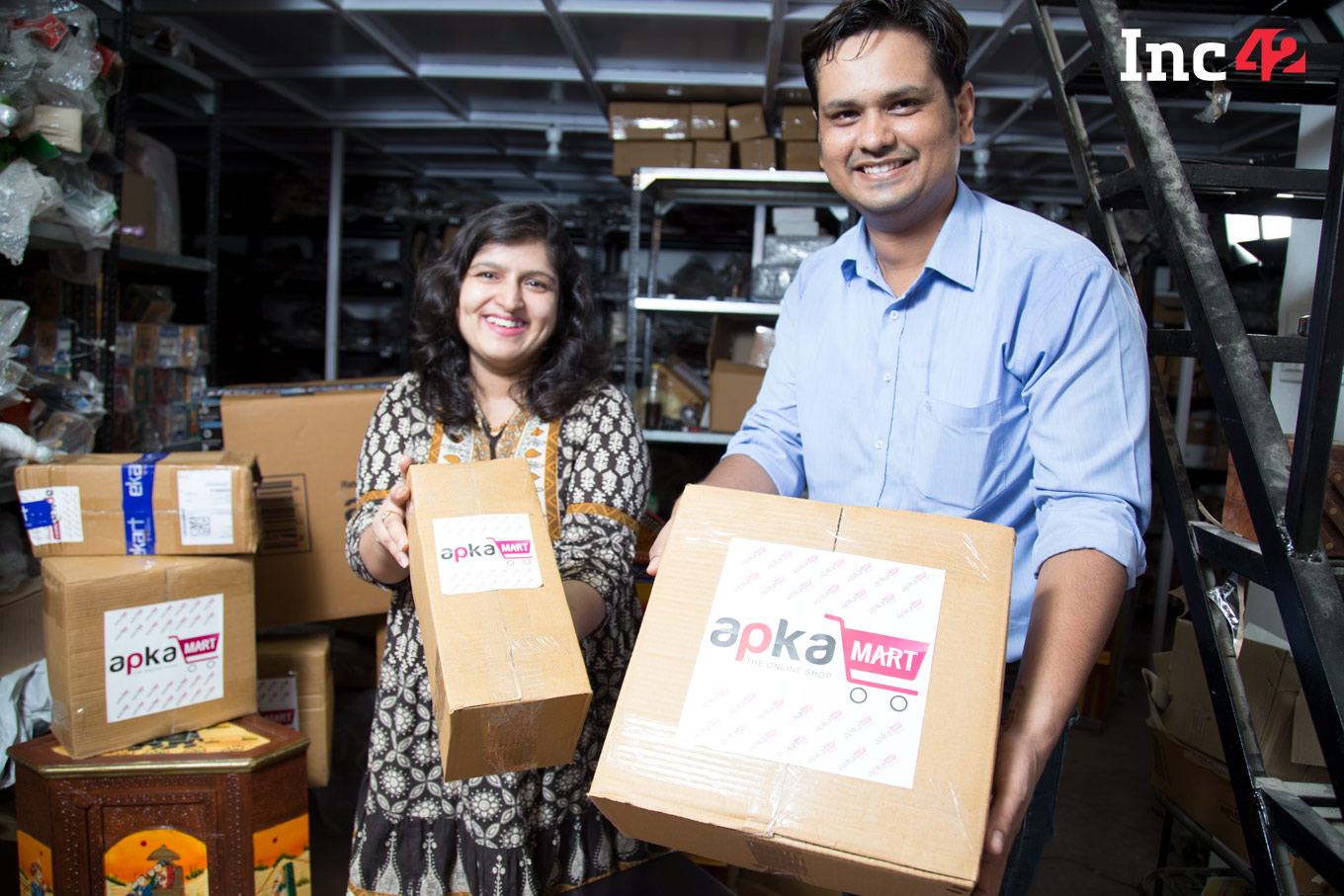
The idea was sparked from the realisation that handicrafts produced by small players/artisans are not priced properly because of the involvement of middlemen. “There are many takers for handcrafted home decor items, but they’re too expensive as middleman mark up prices a lot. As a result, the end users end up paying a lot but artisans don’t get the benefit. The objective was to bring buyers and sellers together via a digital platform,” said Anshul.
According to the Bansals, the home decor market in India is booming, so they wanted to use a digital platform to capitalise on this growing trend. Rajasthani Handicrafts are very popular, but customers are often wary of being overcharged. This is the gap Apkamart is looking to address.
“Apkamart started with a few wholesalers, but now we are sourcing products directly from artisans and also giving them customised requests. Almost 80% of our products come directly from artisans. As far as custom orders are concerned, we take them on for wedding requests,” said Anshul.
The Bansals want to ensure that the artisans get regular work and fair compensation thanks to Apkamart. They mostly source from small artisans who otherwise work for daily wages; with Apakamart, they get regular work. They also want to empower local women by providing employment to them and change the mindset that women shouldn’t work prevalent in the area.
Anshul said he had a dream of becoming an entrepreneur since he was in college; he met Sakshi in college as well. It was 2012-13, while Sakshi was on a maternity break and was mulling getting back to a full-time job, that they came up with the idea of Apkamart and they decided to act on it.
Anshul and Sakshi were working in ICICI Bank’s insurance department but in different divisions when they decided to launch Apkamart. The startup has been bootstrapped from the beginning, and was started with just over INR 1 Lakh. For the first six months, they spent a lot of time procuring products and setting up the website.
After they procured the first batch of products, the new entrepreneurs faced a challenge of optimising their website. As the website started to get more traction, the Bansals learnt along the way. Realising the potential of their business, Sakshi and Anshul were soon wanted to raise funds for expansion, but it wasn’t easy to get financing as they did not meet some of the traditional requirements of banks like three years of founding, IT returns of the business, etc.
The couple finally decided to sell their property in Ahmedabad, where they were based, move to Rajasthan, and go at it with full force. “Honestly when you start off, you always think that you need to have some security, but what we have learnt is that you can’t do a business part time. This is the one piece of advice we would give to all budding entrepreneurs,” said Anshul. Sakshi added, “You need to be focussed if you want your business to grow, that is the only way.”
While they were in Ahmedabad, the duo thought basing their business out of Ahmedabad would give them the edge of being in a big city. But, on introspection, they came to the conclusion that if they moved to Rajasthan, the cost of logistics, including real estate and sourcing of goods, would be low.
They made the first hire for Apkamart in February 2016 — an executive to handle the operations and the accounts. Currently, the total team size is 13 people, of which six are women. The company has a coordinator who manages the supply chain and ensures that the quality of products across batches sourced from these artisans is the same.
Ecommerce platform Snapdeal reached out to the Bansals in 2014 for a business tie-up, the same year Apkamart started. Later even Flipkart approached them, even before they started operations in Udaipur.
The startup used to receive only 10-15 orders a month until 2015 end. Now, the number has gone up to 1,500-2,000 orders a month, for around 2700 products.
“When we started up, people were not convinced about paying online and transacting digitally, which was our biggest change, but now people are getting comfortable with it. English is not a barrier anymore in the usage of smartphones and thus our market is getting bigger,” says Anshul. Making artisans truly understand the business model is another challenge, and an ongoing one.
Anshul said, “We’re trying to change the mindset that you need to be in a big city to make it big. Most of our staff are women, and this is intentional. We’re also trying to change the mindset that women should not work, which still persists here. In the last few years, we’ve seen that women, given the opportunity, can do much better than men.”
The women employees of Apkamart, mostly in the 20-23 age group, take care of aspects such as accounts, website, social media, and packaging. The Bansals added that Apkamart treats its employees with dignity, and ensures that they grow along with the company. They said their growth was evident from change in the way they dress to the face that now they can sign their names in English.
Today, Apkamart boasts a presence on all big ecommerce sites in India, including Amazon, Flipkart, and Snapdeal, and is looking at a future full of opportunities.

Share this – ![]() Share |
Share | ![]() Share |
Share | ![]() Share |
Share | ![]() Share
Share
Meet Daksh, A 16-Year-Old App Developer Looking To Solve India’s ‘Small’ Problems
The highlight of the Udaipur trip for Inc42 was meeting Daksh Agrawal, a Class X student who is the proud owner and developer of seven apps on Google Play Store that are used by more than 10,000 people.
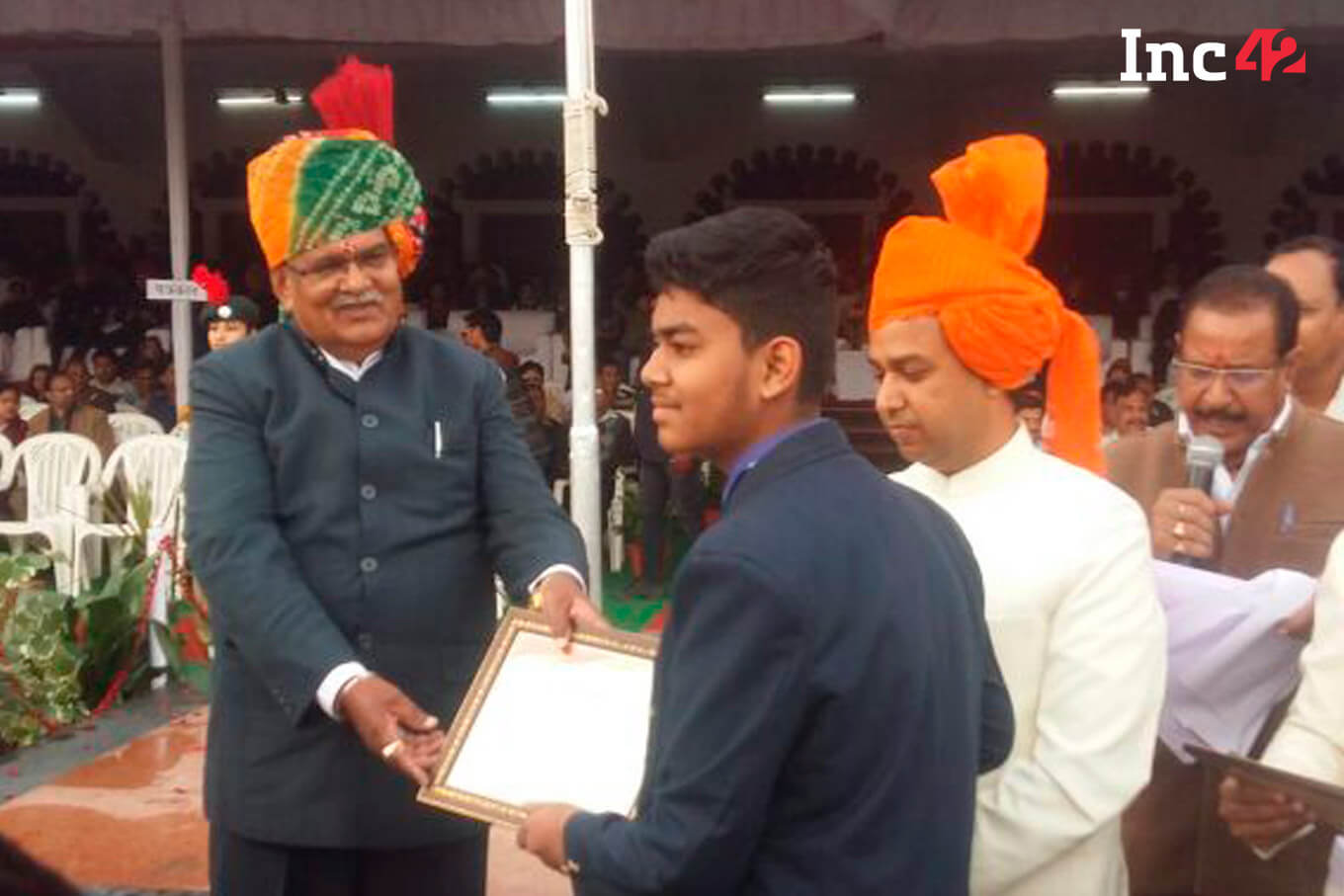
The idea of creating mobile apps came to Daksh when he was travelling in a group to Goa and expense sharing proved to be very cumbersome. They checked out various apps on the Play Store and found online ones, but nothing suited their purpose as they found them difficult to use in the Indian context.
The experience got Daksh thinking about developing offline apps specifically for India. Then a Class VI student, Daksh started educating himself on application development, programming, etc, on the Internet. Over the next one-and-a-half years, he learnt programming languages and Android-based app development by following various portals and forums such as Stack Overflow, Youtuber Siraj Rawal, etc. Daksh was so driven by the desire to build apps that he would skip school sometimes to work on his apps.
He failed three or four times to satisfy the standards of Google Play Store before finally making his big launch when he was in Class VIII. His first app, ‘My Share’, launched on Google Play Store, is an offline app that allows users to add members and split bills in a customisable manner.
The young man likes to brainstorm with his father about real-world problems. He tries to take perspectives on such problems from his father and then uses the inputs to work on his apps. “I try to solve day-to-day problems by identifying such problems and making applications to solve them,” said Daksh.
Another app that resulted from his passion to help people address their everyday basic needs is ‘Society’ — a housing society management app that helps residents access notices from their residential societies, maintenance bills, etc.
Other apps created by Daksh are ‘Party Time’, an online party venue booking platform and ‘EMI Calculator’, which generates complete repayment schedules and enables users to compare different loan rates.
However, despite the success of his apps, Daksh has faced a lot of social censure for not focusing on his studies and getting into app development instead. But, fortunately for him, his parents have supported him through all his failures and successes and allowed him to do what he loves best.
Daksh’s father wanted him to become a tennis player but he never showed any interest in sports. He later realised that it was wrong on his part to force his dreams on Daksh and relooked at his parenting approach. When he discovered that Daksh was fond of technology and wanted to solve the small problems faced by people in India, he encouraged the boy to pursue his passion.
“I believe that the current social and education system should evolve into one where failures are accepted with grace and pride. Only when students are provided with conducive environments to experiment and play with their passions, and fail as well, is when they will truly grow and succeed,’’ said Daksh’s father
Daksh dreams of working with Google one day. He finds it easy to manage his schoolwork along with his passion. He doesn’t want to join coaching classes to prepare for engineering entrances. He has his sights set on MIT (Massachusetts Institute of Technology), where the selection criteria is the interest and capability of the student, not the marks obtained.
After the end of his school session, Daksh was left with textbooks that were of no use to him. “These books could be of big help to the junior students and hence I created a book donation application, BookShare,” said Daksh.
Daksh believes that the government must promote IT in India by setting up unconventional and more productive environments to work in. He also feels developers must be provided support from the government and should be encouraged to experiment freely.
He believes that he can solve many problems faced by Indians in their day-to-day lives by learning from global trends and working in an international environment.
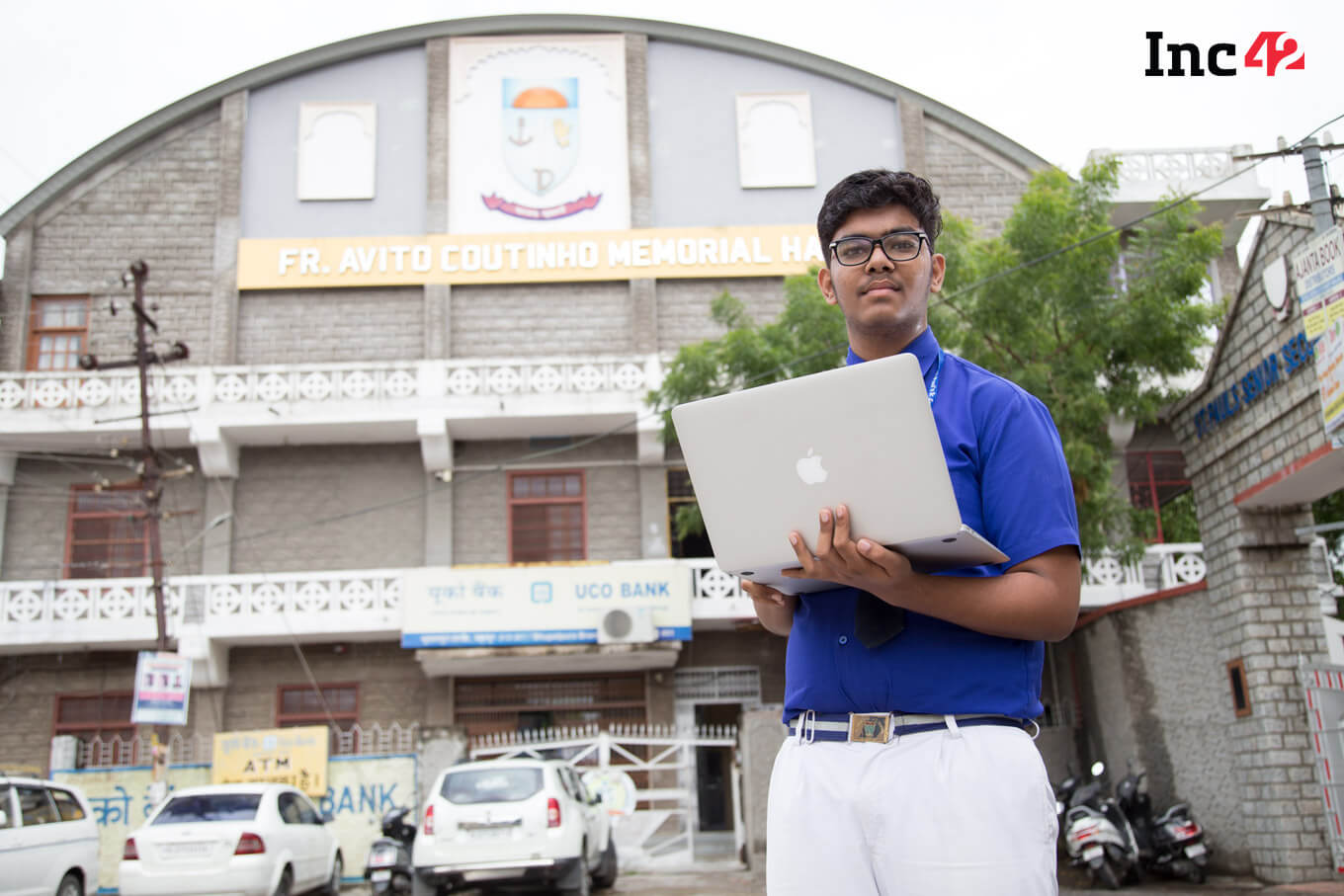
Share this – ![]() Share |
Share | ![]() Share |
Share | ![]() Share |
Share | ![]() Share
Share
How Amit Agrawal Is Helping Young People With His Mobile Repair Training Centre
Place: Udaipur (Bapu Bazar)
Participant: Amit Agrawal, 41 yrs
After interacting with the students of the Khatu Shyam Infotech Studies Private Ltd (KHITS) in Udaipur, Inc42 met the man behind the centre — Amit Agrawal. Amit, 41, started the course in 2003 with four students and has grown the training centre to its present size of more than 40 students.
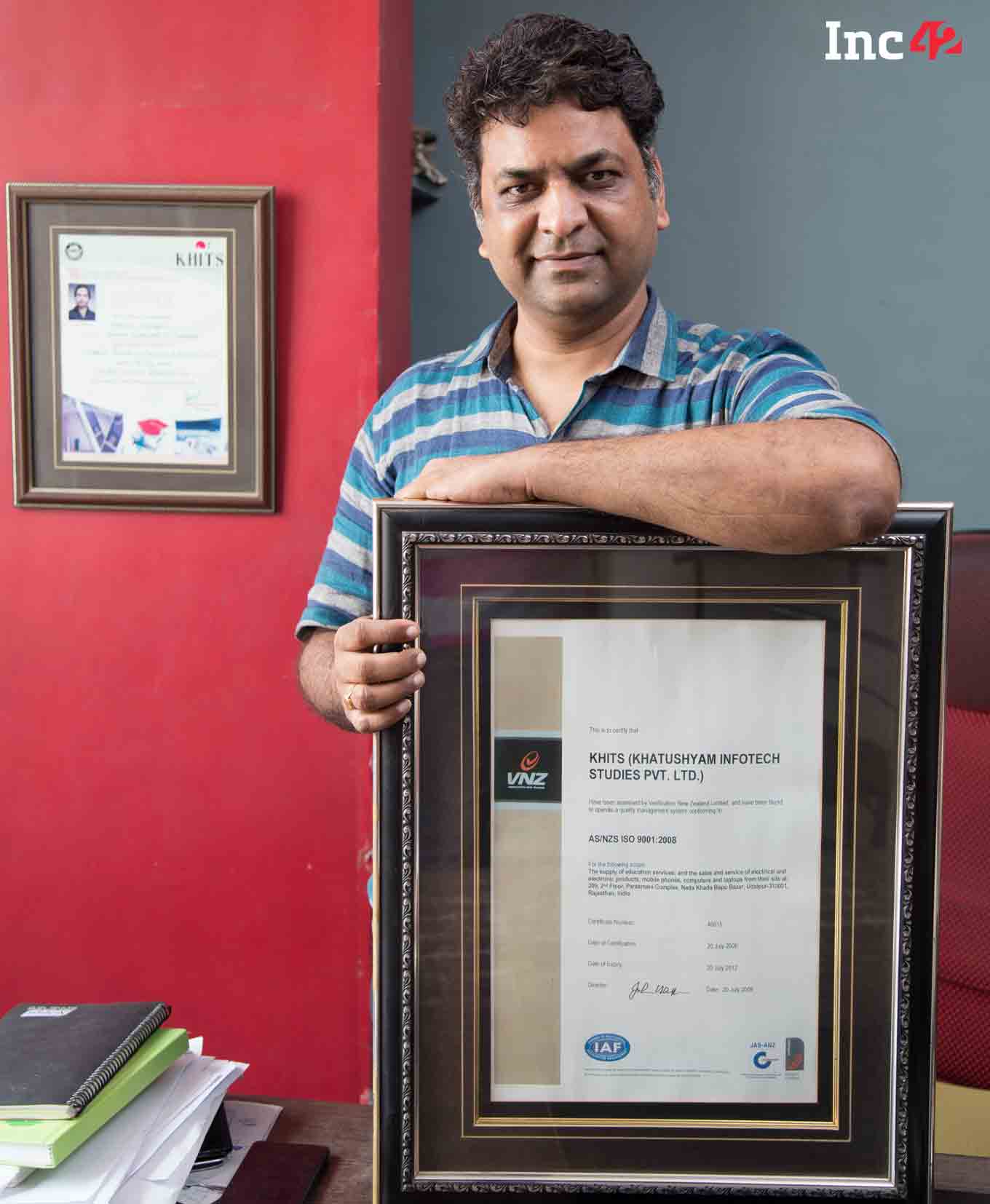
Agrawal had an interesting backstory to share about how he got into the mobile repairing training business. Prior to opening his centre, he was in the business of secondhand mobile phones. Such phones that came to him for sale were usually faulty, so he decided to learn mobile repairing on his own through resources such as books, mechanic friends of his, etc.
He translated the technical content of the books into easy-to-understand layman’s language and started working to repair circuits of these secondhand mobile phones. He then started conducting a course in mobile repair training.
Agarwal also updates the course content according to need. Over time, as touchscreens became popular, he realised that the major problems with mobile phones were usually related to the touchscreen or to charging. He decided to address these issues through the course and made the course module more practical in nature.
The course duration is anything from one-and-a-half to three months. Since the investment is low and mobile repairing is seen as a lucrative employment of business option these days, the demand for the course is very high. The course is priced at INR 5,900.
The typical age group seeking to enrol in the course is between 18-24 years and the minimum education requirement is Class VIII. It is mostly male-dominated even though mobile repairing could be a very good avenue for women as well. The gender ratio is very low — in fact no girl has ever enrolled at KHITS for mobile repairing course.
Mobile repair training centres such as KHITS are so popular than even mobile manufacturing giants such as Samsung and Micromax recruit candidates from them.
The major drawback of the free skill training schemes by the government, according to Amit, is that the students don’t value the courses because they don’t have to pay anything for them. Hence, it is important that the government charges a nominal fee for these courses.
Even though the number of enrolments has dipped a bit in the past couple of years, mobile repairing still offers a great employment and business opportunity to the youth of the country as the penetration of mobile phones is only increasing. Agarwal added that the students, most of whom come from financially weak backgrounds, manage to earn a decent living after the course.
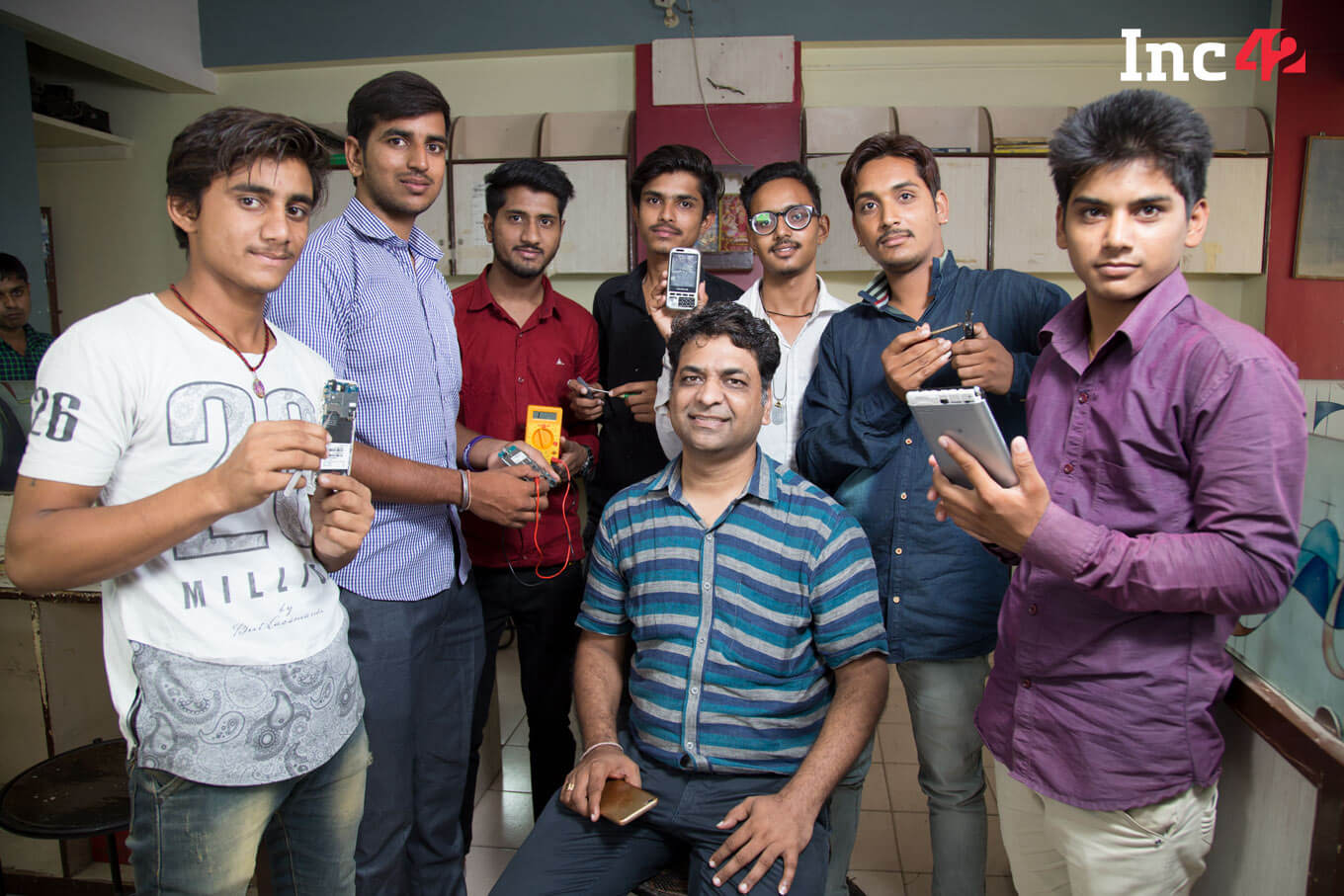
Share this – ![]() Share |
Share | ![]() Share |
Share | ![]() Share |
Share | ![]() Share
Share
Mobile Repairing For Jobs, Business Gains Popularity Among Rajasthan Youth
Date: 10 July
Place: Udaipur
Participants:
Ram Singh, 18; Education: BA
Kishan Lohar, 24; Education: B.Com
Gajendra Patel,17; Education: Class XII
Ayush Jain, 18; Education: B.Com
Dinesh Singh, 22; Education: BA
Mohammad Nadeem, 20; Education: BA
Bhadra Veer Singh, 20; Education: BA
That mobiles are part of our everyday lives is something all of us echo ever so often — at work, at social gatherings, and more. But on Day 4 of Digital Rajasthan Yatra II, we got some real insights from the ground level on how the mobile revolution has swept the country.
During our visit to Udaipur, Team Inc42 caught up with Ram Singh, Kishan Lohar, Gajendra Patel, Ayush Jain, Dinesh Singh, Mohammad Nadeem, and Bhadra Veer Singh, all of whom have more than basic education, ranging from Class XII to undergraduate courses.
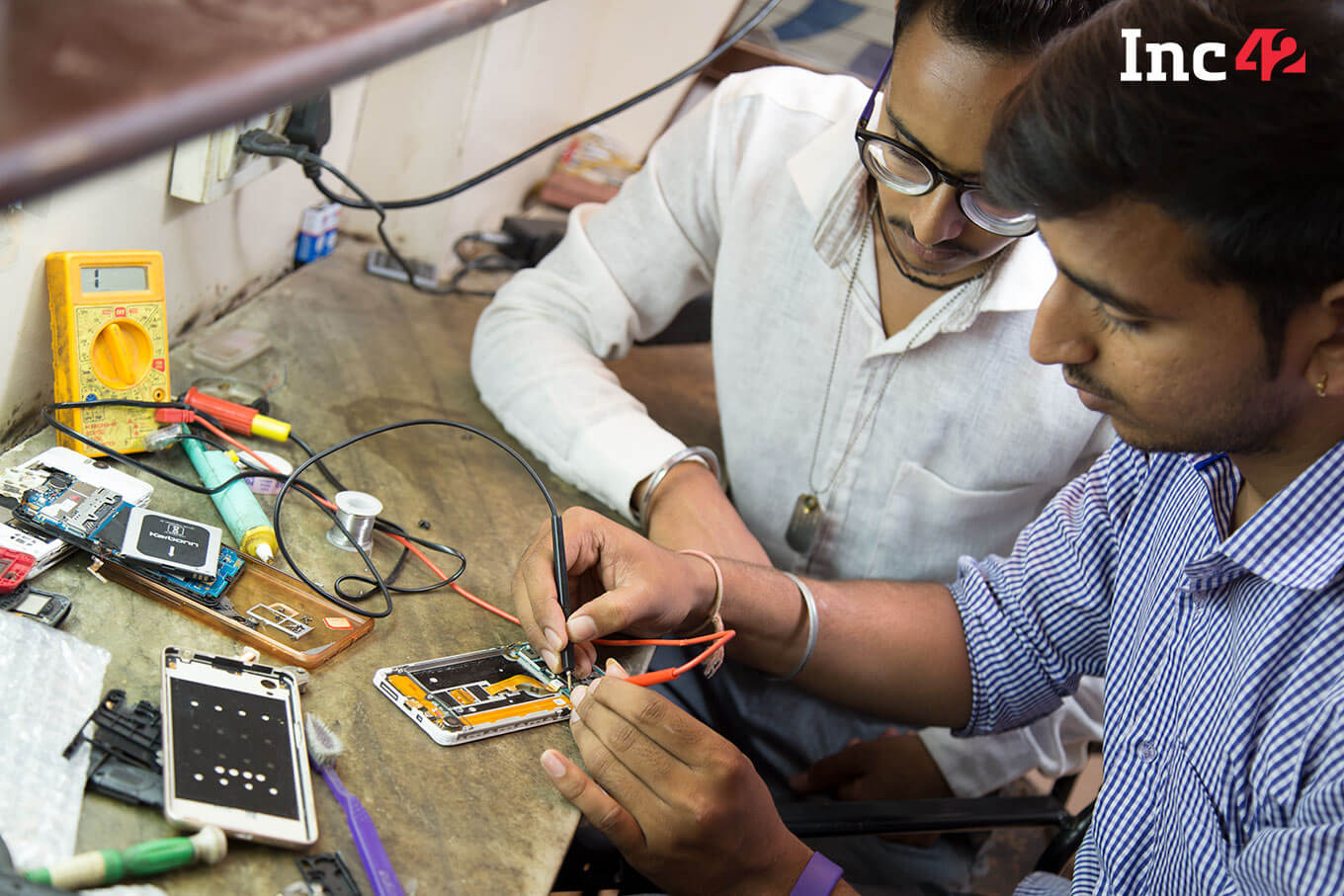
All of them are undergoing training in mobile repairing at Khatu Shyam Infotech Solutions Pvt Ltd (KHITS) in Udaipur. The mobile repairing business has great scope in the city as mobile phones are an essential part of everyone’s life today. The students travel 40-50 km every day from their villages to Udaipur for the classes.
The average fee of the course at the centre is about INR 5,900, for a period of two months. However, the students can continue with the course for a longer period and brush up their skills without paying any extra fee. In addition, the institute also provides direct placement for a minimum salary between INR 10,000 – INR 12,000.
The students we met want to gain some hands-on experience in a job and then aspire to open their own repairing centre. The expenditure in this business is INR 50,000 – INR 1 Lakh. These young aspiring entrepreneurs can avail of loans under the Pradhan Mantri Mudra Yojana, which offers loans at a nominal rate of 0.6% per annum.
The gender ratio typically is low in the field of mobile repairing as women don’t generally opt for this profession.
Mobile repairing courses have become hugely popular in the state since many claim that professional courses like the RS-CIT (Rajasthan State Certificate course in Information Technology), Tally, and accounting do not yield substantial benefits for the students.
Mobile Penetration Among The Youth of Rajasthan
Mobile usage and Internet penetration are high among the youth of Rajasthan — from online deliveries providing exciting cashbacks, to Internet frauds, they are on top of everything. They prefer to may in cash-on-delivery mode for online orders because there is still a slight fear of and apprehension about online payments. They use mobile and DTH recharge, PayTm, etc, regularly.
Like other places in India, WhatsApp is the most frequently used mobile application among the youth here as well. They are quite aware of and wary of the fake news circulated on WhatsApp. And, all of them have Jio sim cards with monthly packages of 3 GB per day, which they use to access Facebook, WhatsApp, YouTube, and to watch movies.
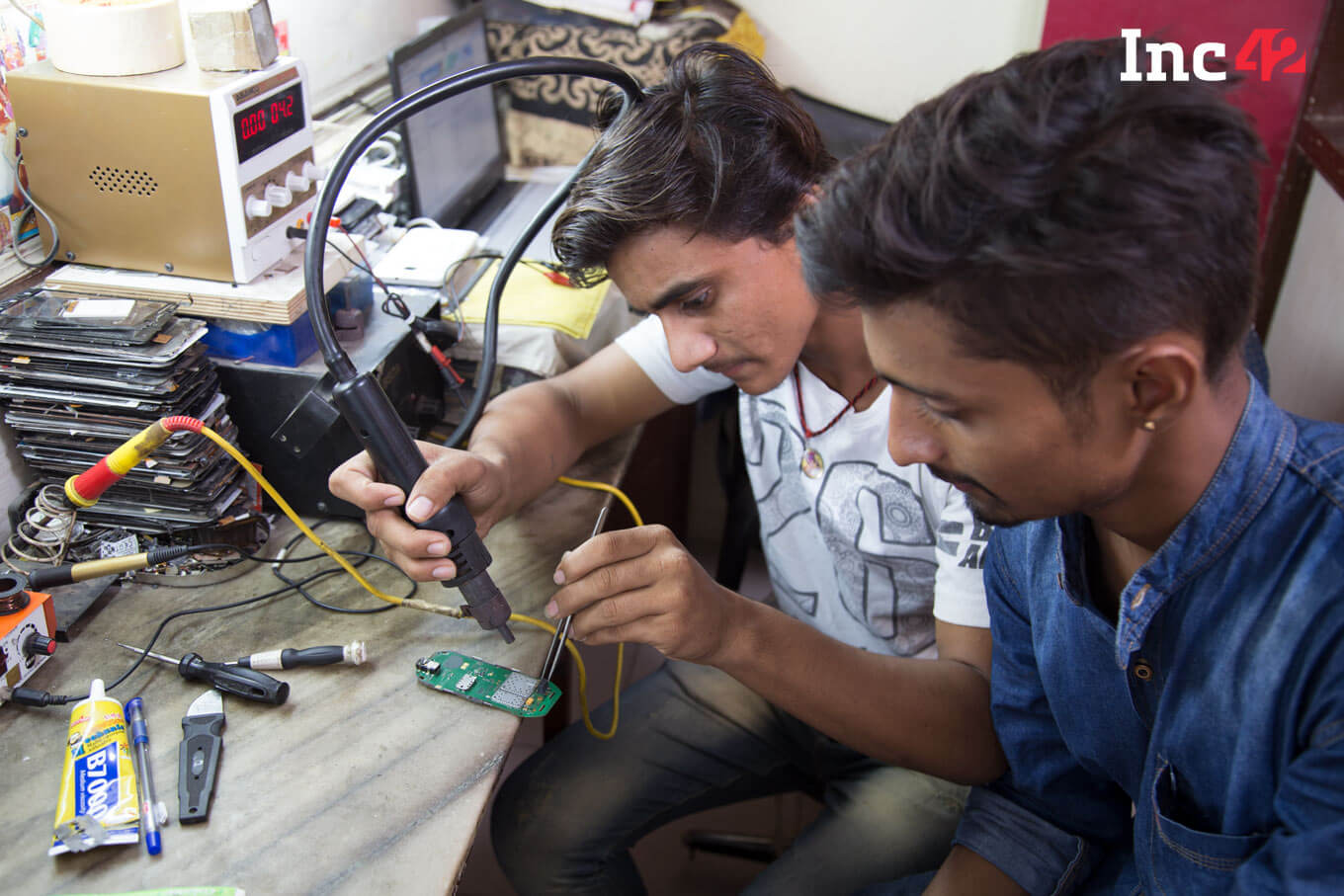
Share this – ![]() Share |
Share | ![]() Share |
Share | ![]() Share |
Share | ![]() Share
Share
SBI Joins Hands With Rajasthan Govt To Empower Youth
The State Bank Of India (SBI), which has been working relentlessly to empower the rural youth of Rajasthan, has joined hands with the state government to support Rural Self Employment Training Institutes (RSETIs).
The SBI bears all the costs of the RSETI in Pali, which is given in the form of a donation. After the training is over, the SBI helps the candidates avail of bank loans to start their own ventures and also conducts digital drives to educate people on using smartphones and applications to make life easier for them.
The RSETIs come under the ministry of rural development of the central government. There is one such training institute in every district and a total of 587 such centres across the state. RSETIs are managed by banks with active co-operation from the central and state governments.

In Pali, the Inc42 team met Anand Prakash (in pic), who works as a manager with the SBI. Currently, he is deputed at an SBI-sponsored RSETI in Pali for a period of three years.
The government reimburses the bank for the training of candidates falling in the Below Poverty Line (BPL), Socio-Economic Caste Census (SECC), and a few other categories; the cost comes to INR 100-150 per day. The trainees are also provided refreshments for free, the cost of which is borne by the donor bank, the SBI, and the government.
The candidates are not charged a registration fee to join courses at the RSETIs. They simply have to fill in registration forms and submit five photographs, copies of their Aadhaar and ration cards and a minimum education certificate (in a few cases). However, furnishing a Class XII marksheet is mandatory for candidates applying for accountancy, computer management, and some other courses.
RSETIs offer courses in computer accounting that cover the basics of computer education and progress towards the basics of bookkeeping softwares such as Tally.
For vocational courses, on the other hand, a Class V pass certificate is mandatory. These minimum education requirements are as per government mandates.
The courses overall are short-term, generally spanning 30 days. Every day, eight hours of training is provided, amounting to a total of 240 hours under each course. The courses are employment oriented, so the trainers deliver high-quality teaching in order to ensure that the students’ standards are true to the certification. The key focus is on people from the economically weaker sections of society, who can’t afford to pay the fee for such courses. The monthly family incomes of these students are between INR 8,000 to INR 10,000 on average.
A formal examination is conducted and based on the results, students are issued certificates by the central government that are valid all over the country.
The Positive Impact Of The Digitisation Drive Across India
Given the rising focus on digitisation, entrepreneurship, and online banking, Bharat QR and the Rajasthan Skill and Livelihoods Development Corporation (RSLDC) are making efforts to ensure that along with receiving skill development training, the youth are made digitally aware as well.
The people of Rajasthan have shown a positive attitude towards digitisation and the youth, in particular, are very curious to learn all of its nuances. Most of those who do these course opt for entrepreneurship. The donor bank also facilitates loans for students who are interested in starting their own ventures after the training.
The Centre and the Rajasthan government give a priority to certified students while sanctioning loans. The loan application needs to be approved and referred by the institute and the bank to take the case further. The loan amount depends on the nature and scale of the proposed business.
“The prospects of digital change are very high. It has the potential to bring about a revolution and change the way we live and see the world,” said Anand Prakash.
Currently, the settlement rate of students doing courses from the RSETI is 68%, of which 40% opt for entrepreneurship and 28% go for competitive exams or private jobs. A majority of the computer trainees opt for jobs and the institutes also provide placements with an average pay scale of INR 10,000 – INR 15,000 per month.
BharatQR is a mobile application created by the government, which facilitates integrated online payments such as NEFT/RTGS transfers without the need to actually go to the bank. This has made transactions easily accessible and convenient for everyone.
The RSLDC runs another skill development centre in Pali that is fully funded by the government. It conducts a short 45-minute session on digital education for all the students, irrespective of the course they are enrolled in. The session aims to impart basic knowledge of digital banking such as operating ATMs, using Internet banking, the BHIM payment app, etc.
The Empowered Women Of Rajasthan
The women’s enrollment ratio in the computer-oriented courses at the Pali RSETI is comparatively low. However, this is slowly changing. In the last batch, there were 10 girls in a class of 24 students. Female students who undergo vocational training in sewing, beauty courses, etc, often go on to open their own training centres.
Both married and unmarried young women enrol in the courses. The women enrolled in these courses feel that financial independence makes them feel empowered and, eventually, improves the living standard of their families as a whole.
There have been several success stories that have emerged from these training centres. For instance, Pushpa Banjara, a trainer at the Pali centre, overcame a major personal setback thanks to the course. She had a disturbed relationship with her husband, who left her alone with two children to look after. She joined the sewing course at the centre to become financially independent. After passing out from the course, she started teaching at the centre; she also runs her own training centre and takes on tailoring work as well. She is financially independent and is able to provide a good education for her children without any support from her husband.
In another instance, a trainee at the centre, Jhanvi, got a direct placement after completing her computer training course and is now earning around INR 10,000 – INR 15,000 per month.
NACER’s Role In Regulating Skill Training Centres Across India
The National Centre for Excellence of RSETIs (NACER), headquartered in Bengaluru, is the apex body authorised by the Centre to regulate and control the skill development institutes and the courses offered in them across India. To become a trainer at any of the RSETIs, one needs to undergo a formal trainer’s training programme in Bengaluru, conducted by the NACER. At the completion of the course, a certificate is issued to the candidate allowing him/her to conduct formal courses at RSETIs.
The minimum target set by the NACER for RSETIs is to enrol 750 students every year at each centre, of which approximately 100 must enrol for computer-oriented courses.
The aspirants are interviewed and scrutinised so as to assess their standard and capabilities, after which they get admitted to the course. There have been instances of young people who wanted to become engineers but couldn’t afford engineering course fees opting for hardware and computer-based courses at the RSETIs to keep their dream alive.
Awareness About RSETIs Still Low
The government does extensive promotion to create awareness about the free training programmes at RSETIs via newspapers, pamphlets, door-to-door marketing, etc. However, word-of-mouth publicity is one of the prime driving factors for the centres. Past students share their experiences with their peers, which, in turn, encourages others to join the centres. But still, there is a need to educate and spread awareness about RSETIs so that more people can benefit from them.
More than 50% of the enrolments are from the labour and daily wage-earning class, who are a bit sceptical about the benefits of the training. The trainers at these institutes play an important role in orienting them well with the courses and assuring them that the training will help provide employment to their children.
A Holistic Approach By The SBI
The SBI is also taking initiatives to increase awareness about online transactions. Bank officials visit different neighbourhoods and educate the people, especially women, about online transaction apps. They help them download such apps on their phones and explain the functioning to them. They also spread awareness among local vendors, grocers, etc, so as to ensure greater adoption of digital payments across cross-sections. People are enthused about using such apps at coffee shops, grocery stores, and even local vegetable vendors.
Share this – ![]() Share |
Share | ![]() Share |
Share | ![]() Share |
Share | ![]() Share
Share
Why The Youth Of Pali Are Arming Themselves With Digital Skills
At our next stop in Pali, we visited a coaching institute run by Deepak Teeji, who runs a course on the basics of repairing and servicing of computers and mobiles. Here, we met a group of six young students pursuing the three-month course, which emphasises on the practical aspects of the topic.
These students are looking to diversify their skills along with pursuing their undergraduate courses, which are about to commence soon.
Anil Mewada, an 18-year-old student, said, “B.com is not enough to guarantee decent employment and I am undertaking this course to gain some extra skills.’’
Most of the students are just about to begin college and are a commerce background. As we spoke to them, it became clear that although they may not know what career they want to pursue, they are aware of the importance of digital skills in increasing their employability.
The computer repairing course, in a way, is their safety net. “The idea is that even after after obtaining a (graduation) degree, if you’re not able to find a job opening, with this professional certification, you can do mobile and computer servicing and be self-employed. It is a more self-reliant option,” said Mohit Rajpurohit, 17, who wishes to become an Android programmer and work for a multinational in future.
The students said most of their friends were preparing for the entrance examinations of the Indian Army or Navy in Kota, Rajasthan.
They told us that computer and mobile repairing is a big business in Pali, which has many shops providing services such as mobile parts replacement, OS installation, and computer debugging.
Most of the students have either completed or were pursuing the RS-CIT (Rajasthan State Certificate Course in Information Technology), a basic computing course run by the state government to equip the state youth with essential skills to use computers with confidence and explore career opportunities. The students wanted the RSCIT centre to include more advanced courses.
Deepak, who is 25 years old and has worked as a service support engineer with the likes of HP, said the government should standardise the trainers who teach RSCIT courses and suggested it could be done by introducing a certification programme for them so that the coaching classes don’t just become a money-making machine.
Tête-à-Tête Over AI, Pokemon Go, And Avengers In Pali!
One may be quick to assume that the students in Pali, while learning basic computing skills, are not in line with technology as much as youths in bigger cities and metros. But we were pleasantly surprised during a conversation with some young people. Sitting in a small room in an apartment shared by other coaching classes, we caught them discussing artificial intelligence (AI,) voice assistants, Pokemon Go, and the Facebook-Cambridge Analytica scandal, among other things! So much for assumptions.
Anil said that he had deleted his Facebook account while Mohit said he has learnt how to ensure online security by using Sandbox, a security software for Windows.
These digitally forward youngsters get most of their technology-related news on Twitter, although they don’t tweet much themselves.
On being asked which tech personality they liked the most, they delved in the surreal world of comics and fantasy with Mohit saying he’s inspired by Tony Stark and Anil said his favourite was Batman.
Who knew cool gadgets shown in movies such as Avengers and Dark Knight could be inspiring these young kids in Pali to explore a future in technology!
May the force be with them, is all the Inc42 team could sign off with!
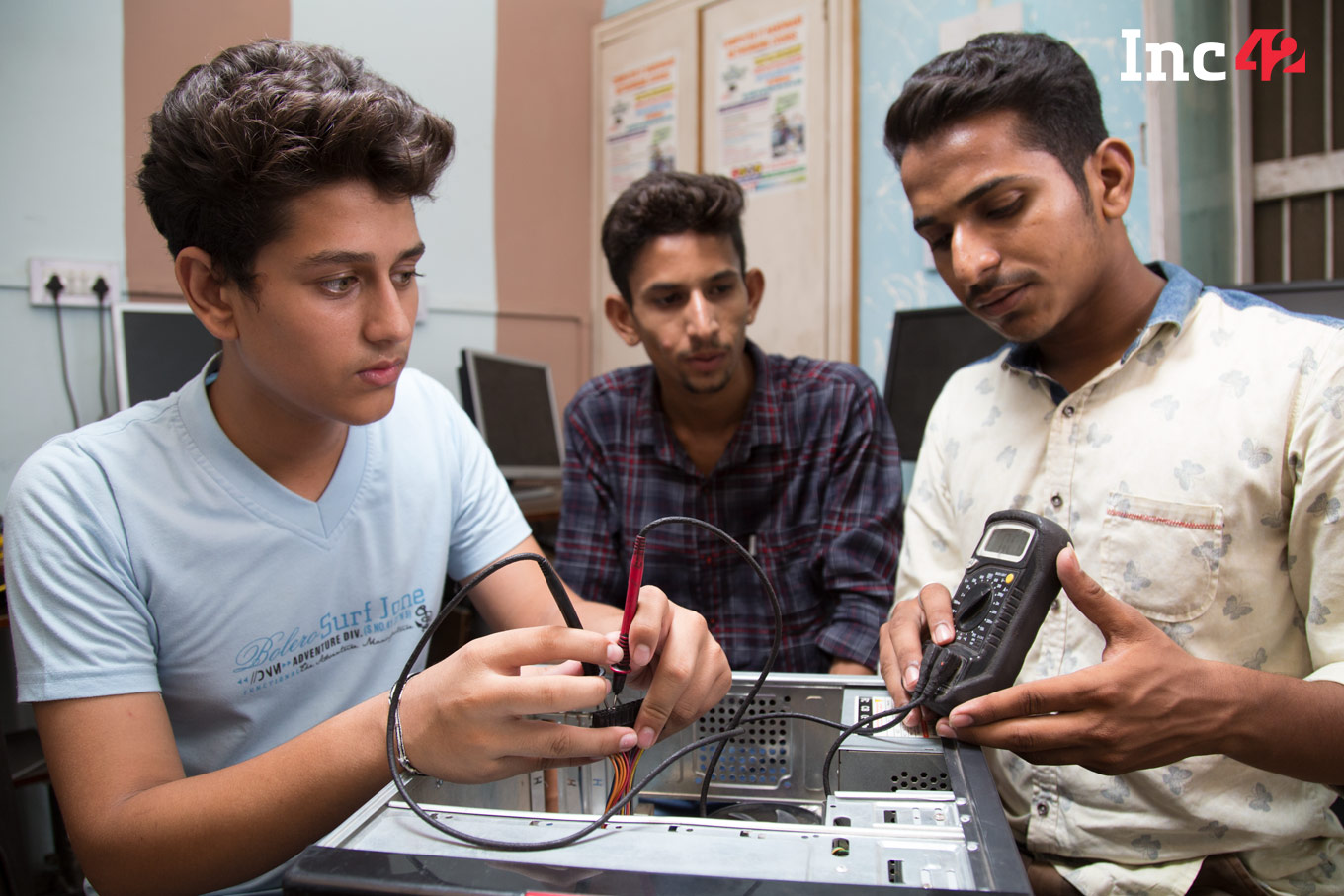
Share this – ![]() Share |
Share | ![]() Share |
Share | ![]() Share |
Share | ![]() Share
Share
Day 3: July 9, 5:00 PM
ASHA Sahyoginis Are Transforming Lives Of Women In Rajasthan
After having a few insightful discussions with the farmers of Krishi Mandi, we were making our way out to Pali in our cars, only to get held up by another fascinating story waiting for us a few blocks away.
Meet Firdosh Bano, a 32-year-old woman, working as an Asha Sehyogini.
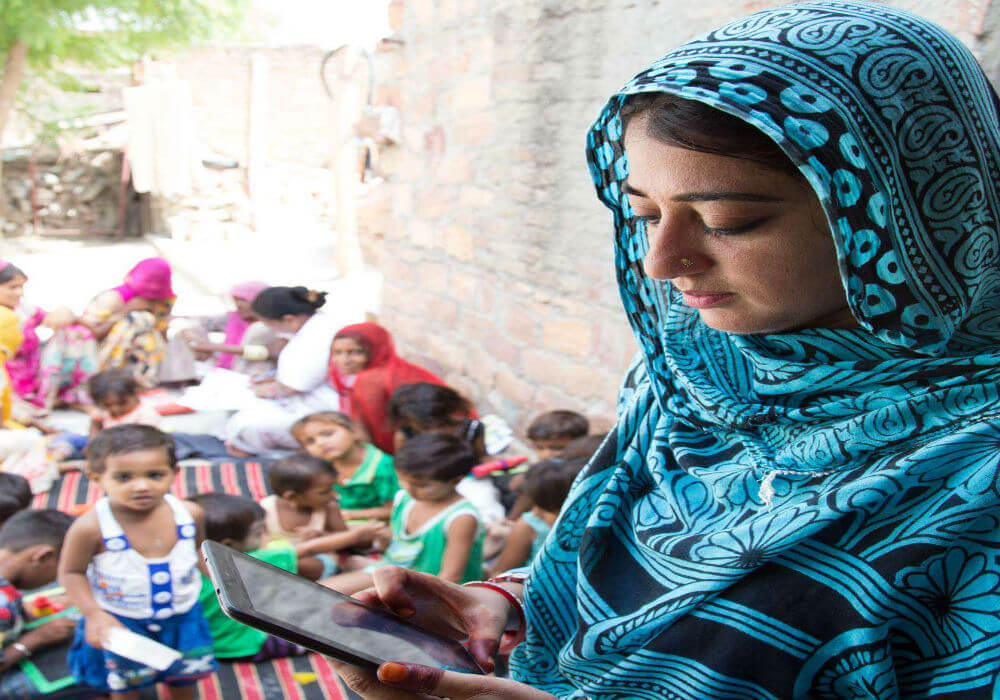
During a conversation with Firdosh, the Inc42 team learnt that the Class XII passout underwent an eight-day certified training programme under ASHA (known as ASHA Sahyogini in Rajasthan) in Pali in 2014.
ASHA is a community-level worker whose role is to function as a healthcare facilitator, a service provider, and someone who spreads awareness about health issues. Apart from delivering key services related to maternal health and family planning, ASHAs also render important services under the National Disease Control Programme. This programme has played an important and critical role in the implementation of health activities under the National Rural Health Mission (NRHM).
The women working in this programme are known as ASHAs or ASHA Sahyogini. ASHAs are supported by the latest technologies which include smartphones and tablets. “We use a smartphone for communicating the requirements of Anganwadis to the primary healthcare centre (PHC),” said Firdosh. Anganwadis are mother-and-child care centres in rural India. They were started by the central government in 1985 as part of the Integrated Child Development Services programme to combat child hunger and malnutrition.
Firdosh further told us that Anganwadi workers are given a tablet, which has improved their working efficiency and reduced costs incurred in activities such as travelling to PHCs just to make a request for materials. However, they still have to go from door to door to remind people about vaccinations and other health schemes in the state because not all women have mobile phones.
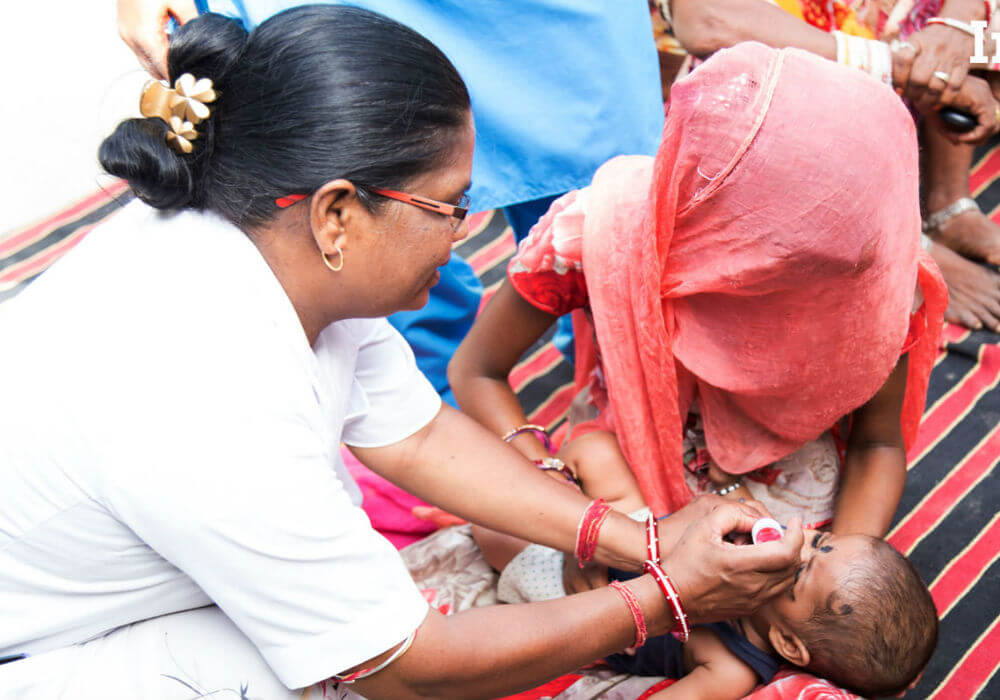
While talking to Firdosh, we were amazed to see how the Bhamashah Card is again at the forefront here.
The other such scheme transforming the lives of the women in Rajasthan is the Bhamashah Card initiative of the Honourable Chief Minister of Rajasthan, Vasundhara Raje.
Anganwadi workers also make efforts to educate people about the benefits of the Bhamashah Yojana. Access to mobile phones and the Internet has further increased awareness in this regard and people are now actively adopting the digital schemes of the government.
“Under the Bhamashah scheme, money from various subsidies is now directly deposited in the beneficiary’s bank account and they receive a message on their mobile phone regarding the same. This, in turn, has improved the living standard of women and has empowered them,” said Firdosh.
Firdosh is very happy with her job as an Anganwadi Sahyogini and feels empowered by it. She believes that she and a lot of other women can contribute a lot more, especially to rural healthcare. She adds that the presence of a strong digital infrastructure as in Rajasthan makes her want to do more and inspire more women to join the journey.
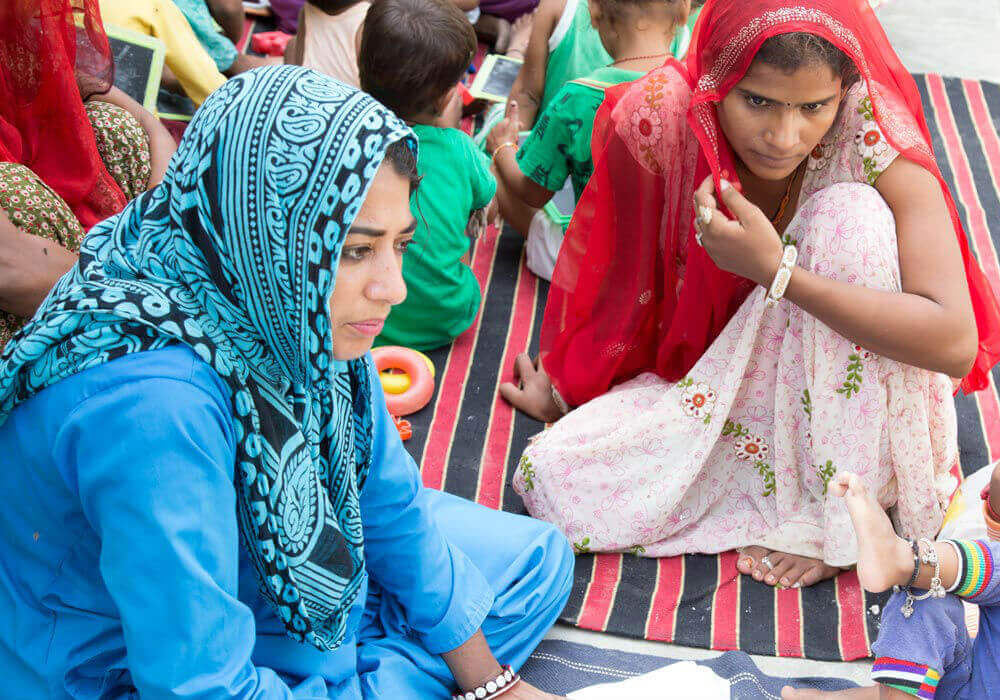 Share this –
Share this – ![]() Share |
Share | ![]() Share |
Share | ![]() Share |
Share | ![]() Share
Share
The Problems Rajasthan Farmers Face And How Digitisation Is Helping Solve Them
After taking a tour of the Jodhpur Krishi Mandi, we sat down with Mandi secretary Ram Singh Sisodia, who had joined the Krishi department in 1989 and has worked in places such as Devana, Nagaur, Jaisalmer, Jaitaran, Udaipur and Jodhpur, to understand farmers’s challenges and how they are benefiting from the mandi (market). The Krishi Mandi’s official name is Rajmata Vijaya Raje Scindhiya Krishi Upaj Mandi Samiti (Grain), Jodhpur.
Sisodia has been working as the secretary of the Jodhpur grain mandi since August 2012. He told the Inc42 team learnt about the different initiatives and schemes the government of Rajasthan has introduced for farmers in the state. We also interacted with a group of farmers and learnt about the challenges being faced by them.
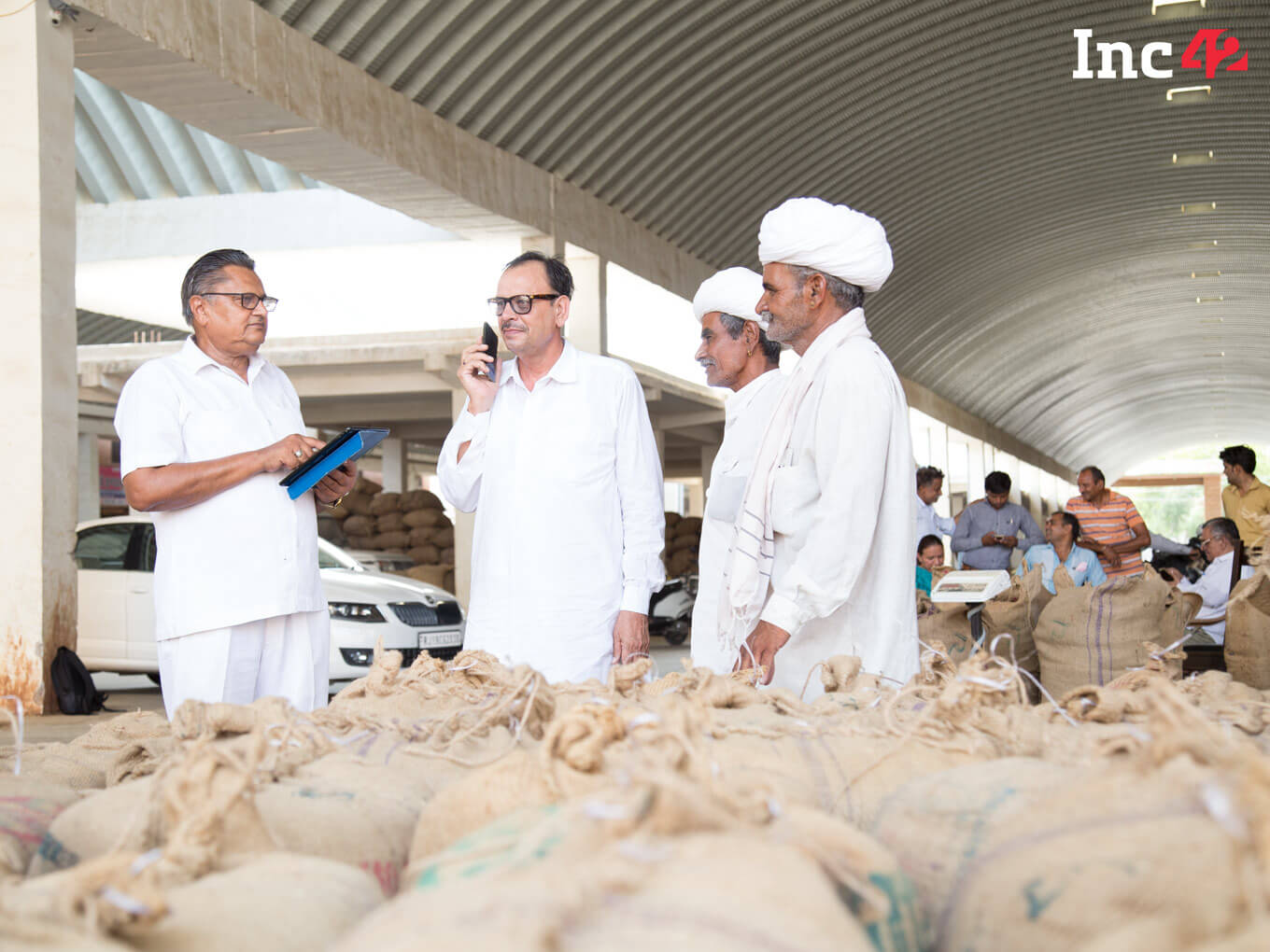
Challenges Faced By Rajasthan Farmers
Wary Of Online Payments
With his focus on digitisation, Prime Minister Narendra Modi has left no stone unturned to encourage people across India to adopt cashless payment modes. The government has introduced the National Agriculture Market or eNAM, an online trading platform for agricultural commodities in India for farmers, traders, and buyers.
However, the farmers in Jodhpur Krishi Mandi still prefer instant cash transactions. They are a bit apprehensive about such payments because most of them, being uneducated, lack the technical knowhow to carry out digital transactions.
Here are some other reasons for their preference for cash:
- They usually take small, unsecured loans from middlemen for weddings or other purposes. Aartya (middlemen) and farmers share a good bond and farmers rely on aartyas for small loans, which they cannot avail under eNAM
- The farmers, who come to the mandi from far off places to sell their crops, prefer to be paid in cash so that they can buy seeds, fertilisers, and other household things on their way back to the village
- Online transactions take time and there is often a lag in the payment as small cooperative banks don’t have adequate digital infrastructure. The payment is supposed to reflect within one to one-and-a-half hours in their bank accounts
- Farmers still find it challenging to operate bank accounts and ATMs. They’re wary of ATMs and online thefts so they prefer cash only
- The government’s BHIM app is used for such transactions, but the penetration is not high because less than 10% farmers have smartphones
However, with the state government’s efforts, farmers are slowly but surely shifting towards e-payments. Starting from April 2018, 137 e-payments were recorded at the mandi.
eNAM: Farmers, All Departments Must Work Together To Promote Scheme
The farmers the Inc42 team spoke to believe that the state agriculture and revenue departments, the sarpanch (village head), and land management officials all have to come together to make eNAM successful. Just announcement and promotion of schemes and policies by the DOITC won’t help, they feel. The farmers want to be a part of the policymaking process and also to help in promotion and development of the scheme.
Farmers Want More Crops Added To ‘Quality Assured’ Check
At present, the crop assessment laboratory tests mustard and wheat on the basis of their oil and moisture content and provides quality certificates, which is a big relief for the farmers as they get the best prices for the certified produce. But, they say there are certain crops — like jeera or cumin — where the quality cannot be tested on the basis of oil and moisture. The old-school way of inspecting and assessing such crops physically is still more reliable, they add. They want more crops added to the testing system.
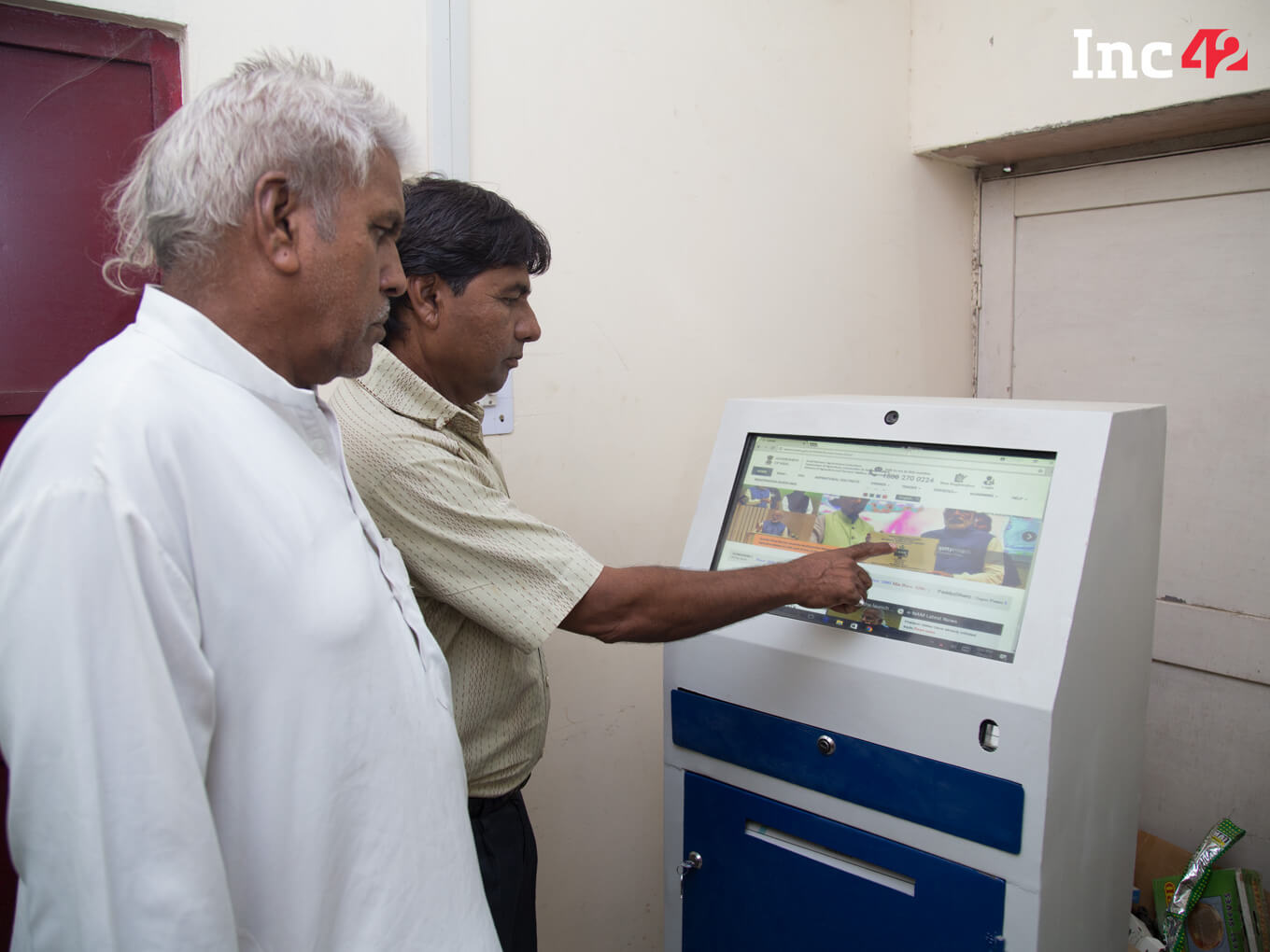
The History Of Krishi Mandi And Current Trade Volumes
Krishi Mandi secretary Ram Singh Sisodia is an interesting person. He not only told us about the history and working mechanism of the mandi, but also gave us insights into the digitisation happening there.
Sisodia told us that the Jeera Mandi was introduced in Jodhpur on April 1, 2017, under the Rashtriya Krishi Bazaar Yojana. The aim of this yojana is to have mandis (markets) in areas of major agricultural production. In 2008, the state government had launched some big mandis considering western Rajasthan had the high production of jeera in the region.
Earlier, the production of cumin in the area was about 1,000-1,500 boris (sacks) in a year. Farmers benefited immensely from the launch of the Jeera Mandi and were able to hike production up to more than 50,000 sacks of cumin in the very first year.
“The current produce is more than 3-3.5 lakhs boris of jeera; 50K-60K bori isabgol (psyllium husk); methi and yellow mustard are also grown here in massive quantities,” Sisodia said.
He also shared that during the peak season, the Jeera Mandi sees sales of up to 7K-8K boris in the peak season. “After May 15, sales touches about 4K-5K boris each day until the end of June. After that, it is around 1,500 boris everyday throughout the year,” he added.
Currently, the Rashtriya Krishi Bazar Yojana is applicable only at the mandi level but it will soon be expanded to the state and then to the national level.
Fast Facts From The Mandi
- Approximately 30-40 sacks of grain are brought in a single lot
- The auction time is currently two-four hours because there is a lot of physical intervention. But once the system is fully digitised the auction time will go upto 30 minutes or less.
- Right now, mustard and chana (gram) are selling below the minimum support price (MSP). MSP is the rate at which the government procures the yield, but in the mandi, forces of demand and supply decide the rate
Digitisation Of Krishi Mandi: The Urgent Need To Spread Awareness Among Farmers
One of the major aims behind digitisation of the mandis is to eradicate middlemen, thereby safeguarding the interests of the farmers. Online auctions will further integrate buyers and sellers from across the country and distance will no longer be a barrier in trading of agricultural produce.
Sisodia explained that the system is designed keeping in mind the interest of all — agents, buyers, and farmers.
All farmers receive e-gate passes of the Rashtriya Krishi Bazaar, which acts as a registration card of sorts, enabling them to sell their produce anywhere in India. Soon after the generation of the e-gate pass, the farmer unloads his produce in the mandi and the sample is tested by the workers there.
A physical tag containing a detailed report on the nutrients and qualities of the produce is provided so that buyers can check the quality of the crop at the time of auction. The yield is judged on the basis of the norms and grades set by the central government. The rates are decided as per the satisfaction of the these standards.
This report is also updated online on a mobile app, which makes it easy for buyers to assess and analyse different batches of produce. The farmers receive messages on their mobile phones about the test reports, highest bid price, final sale price, etc. They are at the liberty to refuse to sell their produce in case they are dissatisfied with the bid price. Also, the MSP is paid directly into farmers’ bank accounts.
“At present, due to the lack of awareness about crop grading, many buyers prefer to physically assess the crop. But digitisation is getting their attention significantly. The prospect of complete digitisation of agricultural trading is high but it will take a longer time,” said Sisodia.
He also said that less than 10% farmers are aware of eNAM. He added that those who are aware use the online trading platform, but there is a need to mobilise the scheme on a large scale. Gram panchayats are also making efforts to educate farmers about digital schemes, but its a slow process.
To fill the awareness gap, regular training programmes are conducted to educate farmers about the online trading and digital payment systems and the response has been positive.
The department of agriculture runs the Krishi Aapke Dwar programme, where officers from the department and mandi workers spread awareness about various government schemes. Regular radio and TV programmes are also aired for this purpose.
Other government schemes and facilities for farmers:
- The Rajiv Gandhi Krishak Sathi Yojana is a welfare scheme for members of the mandi. In the case of death of a farmer, a compensation of INR 2 Lakh is given to the family. Many other mishaps, ailments, and accidents are covered under this scheme.
- Nutritious food is provided to farmers at the mandi at a nominal price of INR 5 under the Kisan Kaleva Yojana. For many farmers, it works as a basic incentive to come to the mandi.
- The Jyotiba Phule Mahila Kalyan Yojana provides women farmers with an INR 800 cashback on online transactions of under INR 1 Lakh and INR 1,000 on those above INR 1 Lakh.
- Farmers are given a 25% discount on the mandi fee if they opt for online payment with a view to increase digital transactions.
- Mandi workers receive an incentive of INR 50K on the wedding of their daughters (upto two girls). Women workers get 45 days of paid maternity leave. Similarly, compensation of INR 20,000 is provided in the case of death of a worker. Education benefits and incentives are also offered for education of the children of mandi workers.
- The Kisan Credit Card enables farmers to avail of interest rates as 4% for loans of up to INR 3 Lakh (if they repay their loans on time); if they repay the loan after the stipulated deadline, then they are charged 7% interest. Loans from the unorganised sector usually charge interest rates as high as 18%-24%.
- The government aims to double the income of the farmers by 2022 with digital schemes and infrastructure.
- Rapid efforts are being made to improve the infrastructure of the mandis. The labs need to improved so as to ensure proper analysis of the crops.
A mandi samiti (committee) is elected by the members of the mandi. It comprises seven farmers, two traders, one transporters’ representative, one representative of the Nagar Nigam, one MLA, two cooperative sector representatives, and two mandi samiti workers. The chairman of samiti is one of the seven elected farmers. The purpose of the samiti is to ensure transparency in the functioning of the mandi and to include all stakeholders. The last election at the Jodhpur Krishi Mandi was held in June 2017.
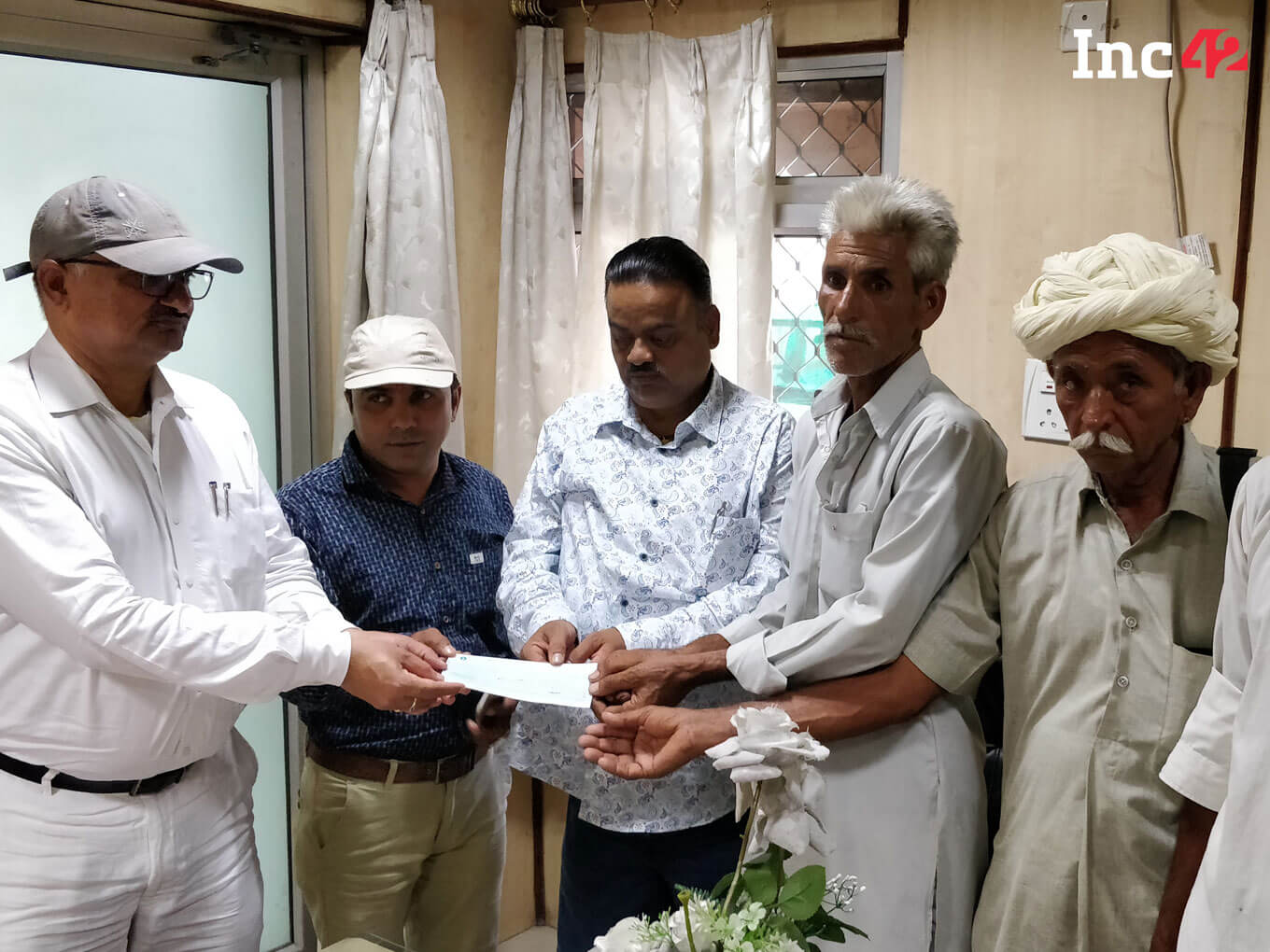
Share this – ![]() Share |
Share | ![]() Share |
Share | ![]() Share |
Share | ![]() Share
Share
How Krishi Mandi Is Bringing Jodhpur Farmers Online
Krishi Mandi not only provides Rajasthan’s farmers with a platform to sell their produce but is also an information hub for all agriculture-related schemes and activities.
In Jodhpur, we ran into a group of farmers discussing eNAM, or National Agriculture Market, an online trading platform started by the Centre. The market facilitates farmers, traders and buyers to do online trading in agricultural commodities across India. According to reports, eNAM transactions (mostly intra-market) stood at INR36,200 Cr by January 2018. More than 90 commodities, including staple foodgrains, vegetables, and fruits are currently listed on the list of commodities available for trade on eNAM.
In February 2018, eNAM introduced some features such as the MIS dashboard, farmers database, BHIM, and other mobile payment platforms, which is driving the adoption of eNAM even more. It also introduced enhanced features on its mobile app, including gate entry and payment through mobile phones.
We also found the farmers discussing the to Rajiv Gandhi Krishak Sathi Yojana 2009. This initiative was started in 1994 to provide financial assistance to farmers who get injured during agricultural activities.
The Inc42 team also had an interview with the Jodhpur Krishi Mandi Secretary, Ram Singh. While these stories are still developing, here are some pamphlets to read for our readers.
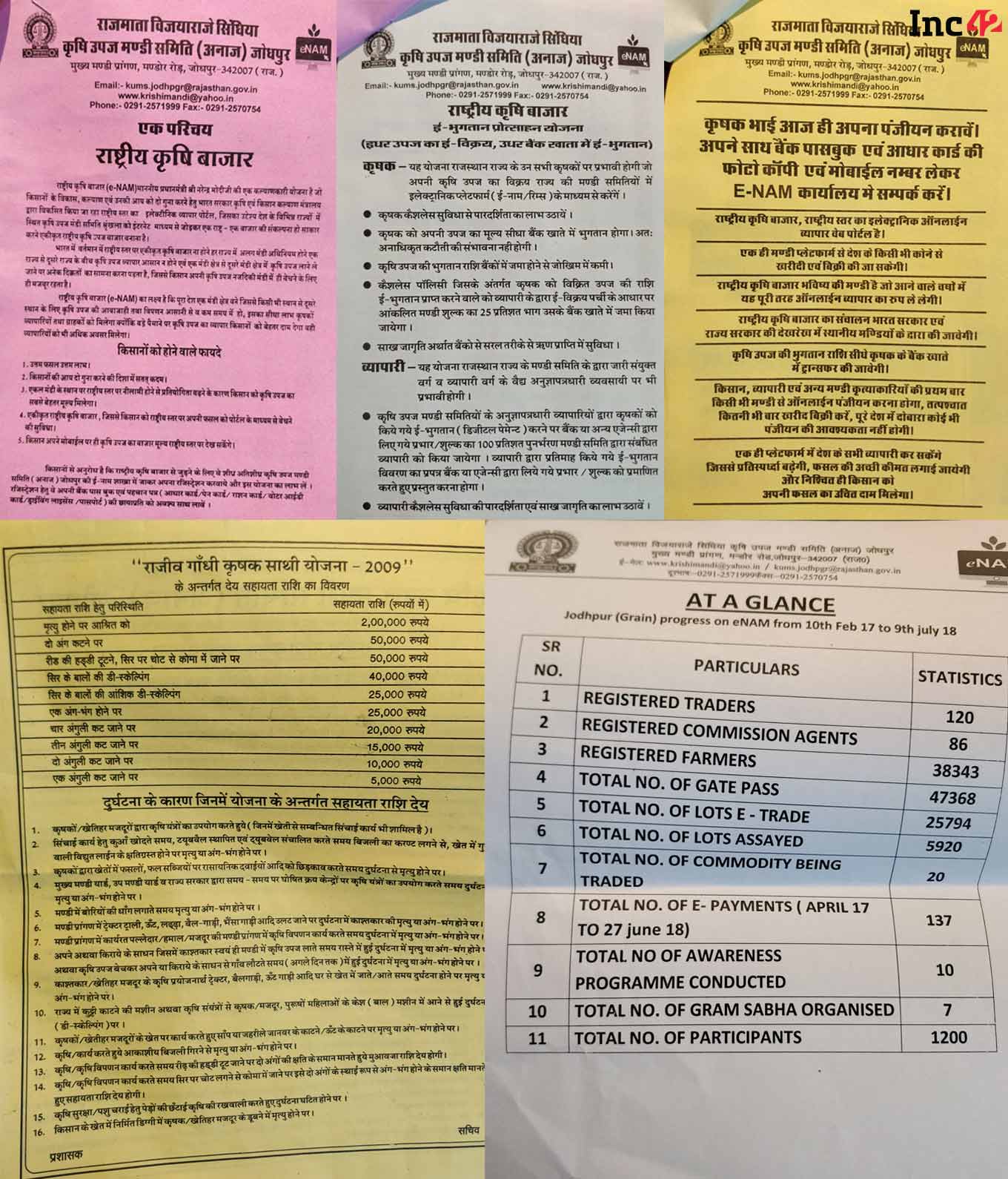
Share this – ![]() Share |
Share | ![]() Share |
Share | ![]() Share |
Share | ![]() Share
Share
Inside Jodhpur: Welcome To Krishi Mandi
Travelling on the roads of Jodhpur, we have now reached a place called The Krishi Mandi. While the Inc42 team is exploring their story for the day further, here are a few pictures to give you a glimpse of the place.
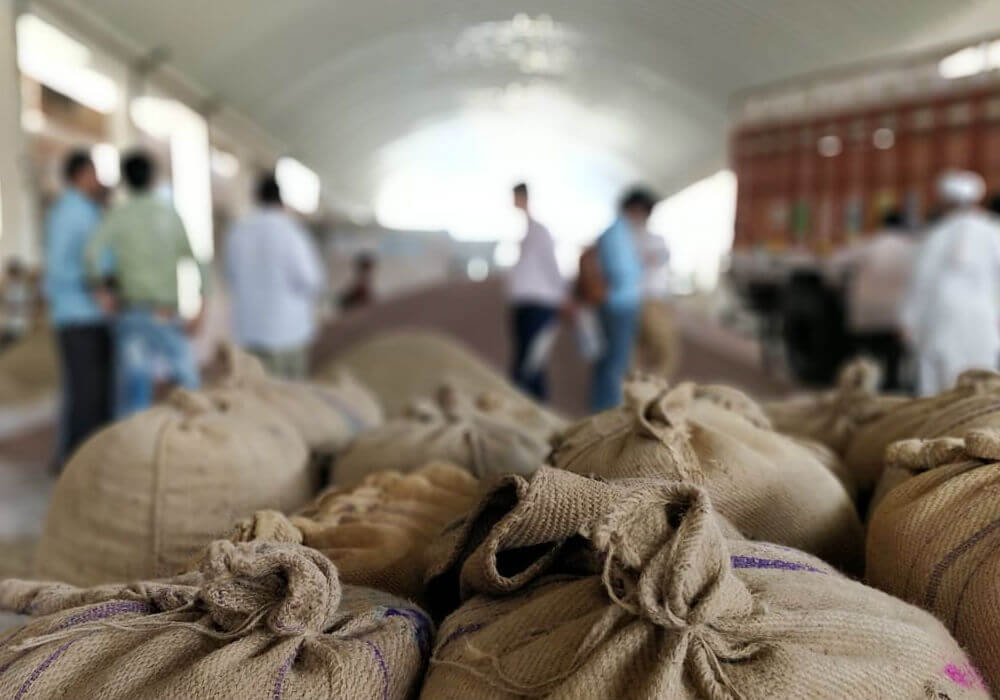
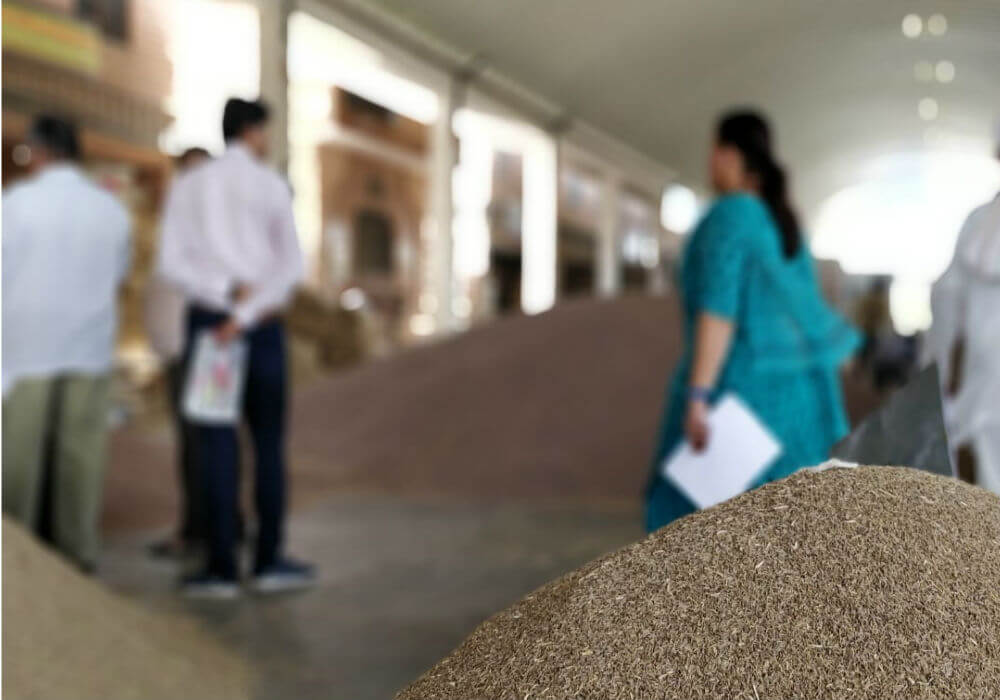
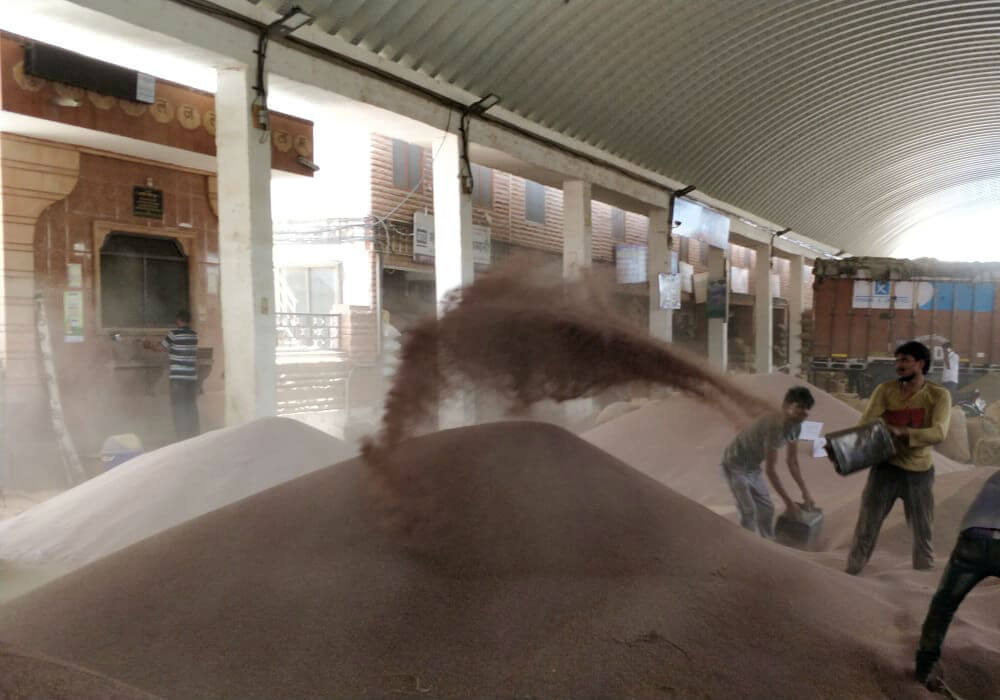
Share this – ![]() Share |
Share | ![]() Share |
Share | ![]() Share |
Share | ![]() Share
Share
How The Bhamashah Card Helped Jodhpur’s Devki Save Her Husband’s Life
According to the Socio-Economic and Caste Census (SECC) released in 2015, 92% of rural households in India have a monthly income of less than Rs 10,000, and 75% earn less than Rs 5,000. India also had the highest number of under-five deaths in the world in 2012, with 1.4 Mn children dying before reaching their fifth birthday.
Naturally, when people are struggling to make ends meet, they can’t have money to spare for healthcare. In such a scenario, government healthcare schemes and subsidies can go a long way in ensuring timely treatment and saving the lives of people in the country.
On our trip to Jodhpur as part of Digital Rajasthan Yatra 2, we met one such woman named Devki, who was able to save the life of her husband, Suraj, thanks to the Rajasthan government’s Bhamashah Card. Suraj recently underwent a life-saving surgery to remove a brain tumour by availing of the medical insurance benefits provided by the Bhamashah Card. Suraj and Devki live in Jodhpur with their three children — daughters Kirti and Jhanvi and son Krishna.
It all started two-three years ago when Suraj suffered from a headache that refused to go away. Initially, he was diagnosed with high blood pressure and doctors gave him some medicines. But the problem persisted. Recently, the family got further medical investigations done and in the first week of June, Suraj was diagnosed with a brain tumour.
The doctors recommended immediate surgery which would cost about INR 1-1.5 Lakh. Any delay in the operation could lead to paralysis or coma, the doctors said.
The family was in panic as they could not afford the surgery. Devki and her kids were in trauma at the thought of losing Suraj because of lack of funds for his treatment. The doctors told them to take him to another hospital.
At this fateful time, when Devki was preparing to shift him to another hospital, she remembered her Bhamashah Card. She asked the doctors at Goyal Hospital, a private hospital in Jodhpur where Suraj was being treated, whether she could avail of any healthcare benefits against her card. The doctors said they would check if she was entitled to any medical benefits. Just as she was preparing to shift Suraj to another hospital, the doctors called her saying that she could indeed use the Bhamashah Card for Suraj’s surgery — the card provides beneficiaries up to Rs 3 Lakh in medical insurance cover annually.
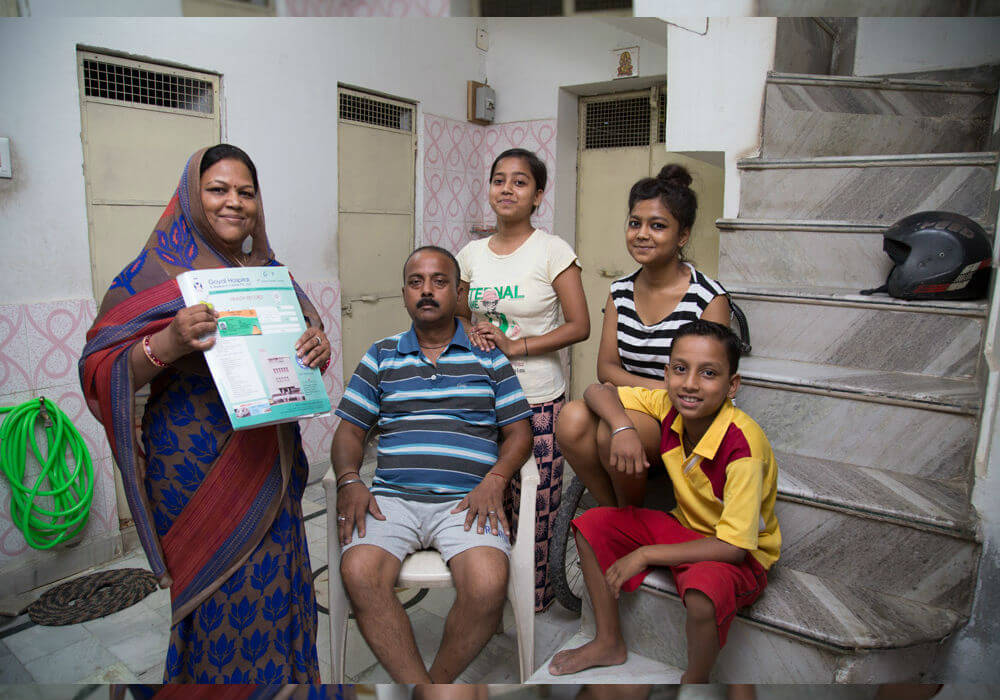
Her Bhamashah Card was active, but needed further activation from the central office in Jaipur. The hospital staff helped her with the activation and with other formalities for availing of the medical insurance. Within a few days, the surgery was performed and it went off well. Suraj’s life was saved. The insurance covered the cost of medicines and ICU care as long as her husband was in hospital.
Devki and her kids’ happiness knows no bounds. The Inc42 team met and spoke to an emotional Devki during our trip to Jodhpur.
“If I didn’t have the Bhamashah Card, my husband wouldn’t have been alive today. After his treatment for the last couple of years, I didn’t have any money or savings left for his surgery. It’s only because of the financial benefits offered by the Card that my three children still have a father,” Devki shared with the Inc42 team, tears of happiness and relief in her eyes.
Devki had to shell out a total expenses of INR 30,000 – INR 40,000 on Suraj’s treatment, but this money was spent on tests such as CT Scan, MRI, etc, before the activation of the Bhamashah Card. After the activation of the Card, no major expenses were incurred by Devki at the hospital.
Post-operative medical care will continue for the next two-three years, but such expenses are not covered under the card. Suraj and Devki will have to buy the medicines on their own. However, the major cost of the surgery has been covered by the card and the family can’t thank the state government enough.
‘The Bhamashah Card Should Provide Education Support As Well’
Suraj had to give up his job because of his illness. Devki now works for a private establishment to fend for the family. She told the Inc42 team that while she is thankful for the healthcare support provided by the state government, it is difficult for her to manage the education expenses of her kids. “I wish the government would provide us with support to meet our children’s education expenses as well,” said Devki.
She believes that it is crucial for her to educate her children well so they can slowly recover from the financial setback of Suraj’s illness and make a better life for themselves. And support from the government is essential for women like her. She is hopeful that Inc42 will be able to get her message across to the people who matter.
Devki and Suraj have gained some fame in their neighbourhood after the incident. In fact, Devki has taken it upon herself to spread awareness about the Bhamashah Card so that other women like her can use it to provide much-needed medical care to their family members.
It’s stories such as these that help us keep the faith in a better tomorrow, in fact a better today, for the underprivileged in our country.
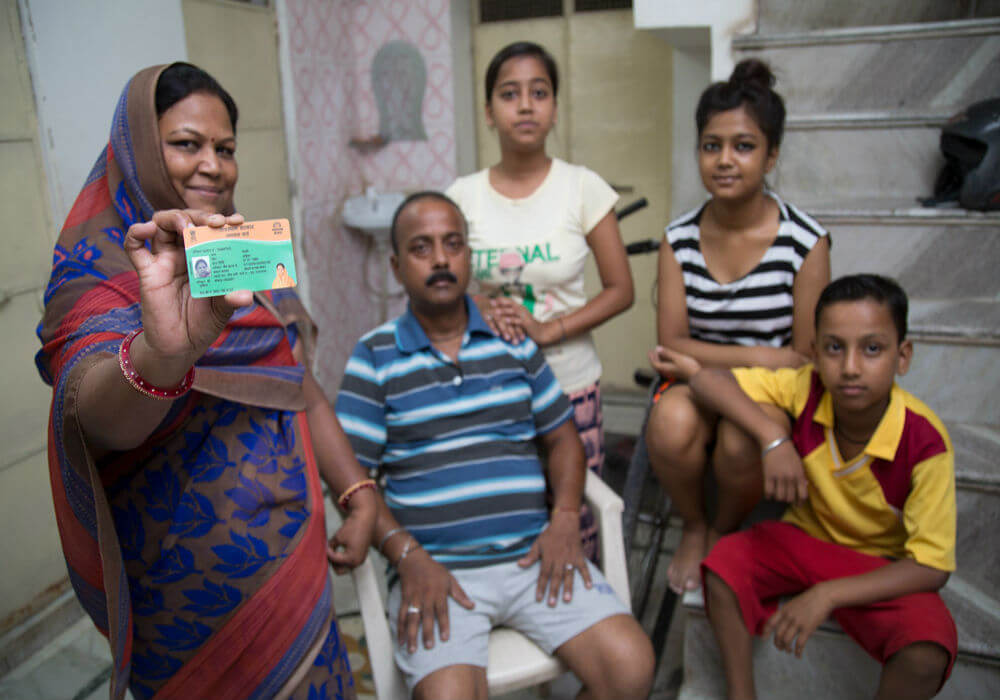
Share this – ![]() Share |
Share | ![]() Share |
Share | ![]() Share |
Share | ![]() Share
Share
Healthcare & Food Subsidies Making Bhamashah Card Popular Among Women In Rajasthan
The women in Jodhpur mostly use basic mobile phones, except younger women who have access to smartphones. The ones who have access to smartphones mostly use Whatsapp, Facebook, Instagram, and YouTube.
In a group discussion in Jodhpur, the Inc42 team heard stories of how women in the city are simplifying their lives by using mobile phones and by adopting government schemes such as the Bhamashah card.

So, how is the Bhamashah Card proving to be a boon for the women in Rajasthan?
The Bhamashah card is very popular among people of the state for the benefits it brings them. The bank accounts of women beneficiaries are linked to the card. Devki, a woman from Jodhpur, benefited from the Bhamashah Card immensely — she could get her husband’s brain tumour treated thanks to the card. The surgery, which would otherwise cost INR 1 Lakh to INR 1.5 Lakh ($1,456-$2,185), cost her just INR 30,000 – INR 40,000 ($437-$582). They could avail of ICU facilities and free medicines on furnishing the Bhamashah Card in the hospital.
Bhamashah Card holders are entitled to receive medical benefits up to INR 30,000 ($437) for common illnesses and minor ailments and INR up to 50,000 ($728) for critical ailments annually. Besides, the Janani Suraksha Yojna provides INR 50,000 ($728) to women beneficiaries on the birth of a child; the money is transferred in instalments directly to their Bhamashah-linked bank accounts. This is a big driver for women to undergo deliveries in hospitals, thus reducing instances of maternal child death in the state.
Apart from healthcare, the Bhamashah Card also takes care of people’s sustenance needs. Bhamashah cardholders can avail of ration at subsidised rates. Foodgrain of 5 kg is made available at the rate of INR 2 per kg. Women can avail of this subsidized ration for their families; they receive notifications on their phones about the ration rates and offers.
The Aadhar card too is helping women with LPG subsidies of INR 150 – INR 200 ($1.4-$2.2) per cylinder, which is transferred directly to their bank accounts.
On the other hand, initiatives such as e-mitra have made documentation, correction of personal details, form deposits, etc, very easy and almost every woman in the city, irrespective of age, uses e-mitra regularly.
The Pressing Need Of Digital Schemes For Women In Rajasthan
The government has launched another scheme — e-sakhi — but awareness about the scheme is a bit low because it is relatively new. The women of Jodhpur feel that there need to be more awareness drives on the government’s digital schemes and their benefits.
While the women are happy with the healthcare and food benefits the Bhamashah Card provides, they collectively voiced a demand for educational benefits such as fee waivers and scholarships for children, especially for the girl child. Currently, the card doesn’t provide any education benefits. The women want subsidies in school fees because education expenses are high.
The Digitally Empowered Women Of Rajasthan
The healthcare benefits and incentives provided through the Bhamashah Card are resulting in reduced death and mortality rates. Women feel more empowered because of the financial independence the card is according to them. They now have a say in family matters and decisions and shared with us how this has fueled a revolution of gender equality in the state.
‘’Women are now truly empowered; they are acting as heads of their families. We no longer depend on anyone in the family. In fact, our family members now depend on us,’’ said one of the participants of the discussion.
Mobile phones have become an integral part of the lives of women in Rajasthan. The receive various reminders and updates about schemes via messages. Connectivity us much better and they are now able to easily communicate with their relatives in remote areas of the state. While the elderly women believe that the Internet and smartphones have distanced people from each other, the younger women feel they have made it easier for them not only to connect with their friends and family but also to stay updated with what’s happening around them.
Share this – ![]() Share |
Share | ![]() Share |
Share | ![]() Share |
Share |![]() Share
Share
Meet Mahesh Singh, An Entrepreneur Building the ‘Google’ Of Pali
In the second half of the day, the Inc42 team met a young entrepreneur named Mahesh Singh Parihar. The 21-year-old, a Class XII passout, is building what you could call the Google of Pali — a digital advertising solution called Digital Pali.
Digital Pali is a listings website for local businesses in Pali under heads such as ‘Top Business’, ‘Public Sector’, ‘Jobs In Pali’, ‘Tourism’, and an option to ‘Explore Places by Categories’.
Intrigued by his venture, the Inc42 team asked Mahesh a lot of questions, which he answered patiently. Talking about his background, he told us that his father moved from Pali to Maharashtra at the age of 16 in search of employment. He got into the manufacturing and wholesale business of carry bags and then grass brooms. His grass broom business, Radhika Enterprises, did well in Maharashtra and then he expanded it to his hometown Pali.
Born and brought up in Maharashtra, Mahesh shifted back to his ancestral village Pali nine months ago where he manages the family business alongside his startup. One of his friends from school started Digital Rajsamand, a digital advertising company, which received a good response. This spurred the duo to expand the chain to other districts. They wish to cover all the major districts of Rajasthan.
Currently, Digital Rajsamand, Digital Bikaner, Digital Chittorgarh, and Digital Pali are functional.
The current investment in this venture is approximately INR 50,000 ($726) – INR 60,000 ($871). The founders plan to bring all four websites, along with that of another district, under a single parent company. They are investing their savings in the expansion.
Insight of the day: Digitisation has reduced rural migration as the rural youth is now experimenting and venturing into unconventional business opportunities created by digital platforms.
Coming back to Digital Pali, the platform provides online advertising solutions to local businesses at an affordable price. It provides the maps and contact details of local enterprises of Pali on the online platform, right from banks, educational institutions, ATMs to salons, restaurants, etc. The platform facilitates direct interaction between buyers and sellers.
They have managed to onboard a total of 81 customers in the last three months, out of which 28 have paid annual subscription fees to the startup. Digital Pali charges a yearly subscription fee of INR 1,000 whereas similar online listings platforms like JustDial go as high as INR 27, 000.
“Small businesses find it difficult to list on platforms such as Amazon, JustDial, IndiaMart, etc, because of the stringent procedure, documentation, and hefty charges. This is where our local platform comes in by furnishing an integrated business listing and advertising solution. We further plan to branch out in areas such as online selling, online job listings, event listings, etc,” said Mahesh.
Businesses create their profiles on the Digital Pali website to showcase pictures of their products online. They share the link of their profile with customers over WhatsApp as a showcase of their products instead of sharing multiple images.
There has been a major shift in the mindset of local business owners about digitisation. They are increasingly getting inclined towards going online due to the ease, low cost, and evident benefits this brings to their profits.
Digital Pali also acts as an employment portal by listing local vacancies, thereby connecting employers and job seekers.
Buyers, meanwhile, are actively using the platform to find out about nearby stores, products, and services. This is reflective of the widespread availability and use of Internet services in the district.
Digital Pali hosted an online contest on World Music Day on Facebook and Instagram to promote and increase youth engagement. Youth in Pali actively use social media platforms such as Facebook, Instagram, etc. Apps such as Musically, LIKE, etc are also popular here. They are using these platforms to showcase their talent and to be on par with global trends.
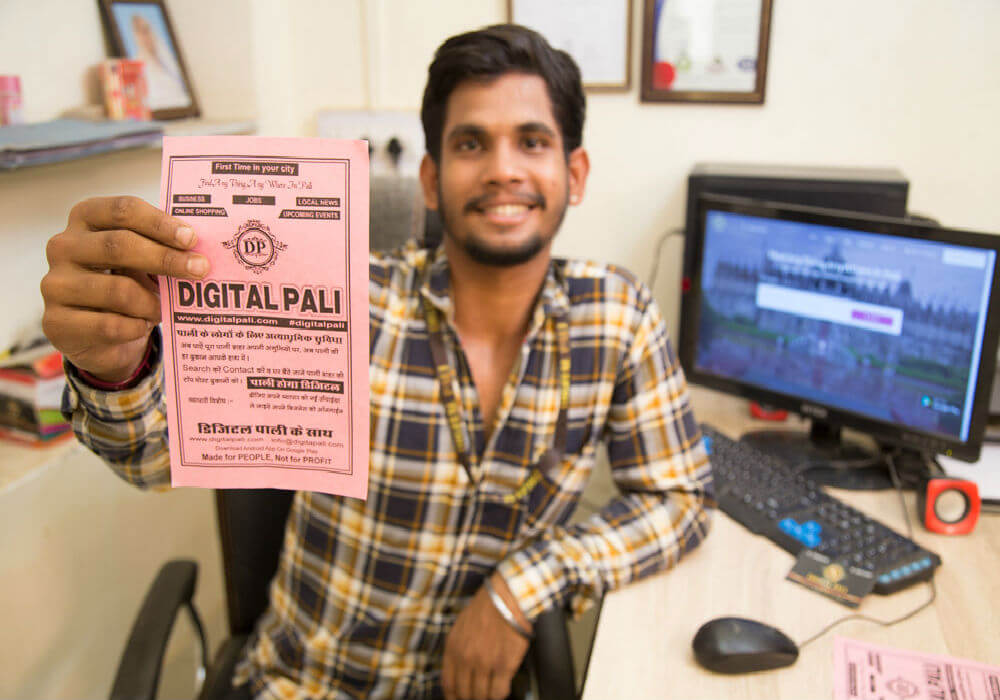
Share this – ![]() Share |
Share | ![]() Share |
Share | ![]() Share |
Share | ![]() Share
Share
It’s A Woman’s World Today, Say The Men In Rajasthan
Place: Bangur, Pali
DI Participant: Jai Mala Rathore (Auxiliary Nurse Midwife)
On Sunday (July 8), as the rest of you were doing your Sunday brunches and enjoying your siestas, the Inc42 team was braving the blistering 40°C heat in Pali to met Jai Mala Rathore (pic below)), who works as an auxiliary nurse midwife (ANM). She told the team that ANMs have been provided with tablets by the government to maintain records, etc. There is a software in place for the same, which has increased the speed of their work by three times.
Earlier, ANMs were wasting a lot of time and paper in maintaining records manually; this also increased the scope for error.
However, poor Internet connectivity is a major challenge in implementing the new system. In such a case, the ANMs data submit their tablets to primary healthcare centres (PHCs) every month and the data is updated on a monthly basis. The information is then collated and updated on a common platform/software. But, there is no online system for direct data transmission.
The digitisation of the process has reduced wastage of paper, time, and effort. Beneficiaries receive system-generated reminders on their phones via SMS about due vaccination dates, etc. Earlier the ANMs used to go from door to door to remind women of these things.
ANMs also record Bhamashah, Adhaar, bank account, and contact details on the online software. They also maintain details of every medical check-up, vaccination, symptoms, etc of mothers and children on the software.
Beneficiaries receive regular messages about the benefits available to them, such as free medicines, free medical checkup, monetary support, etc. Some monetary benefit schemes include INR 1,400 on laparoscopy (upon provision of evidence), INR 5,000 on the birth of the first child, and additional INR 2,500 on the birth of a girl child, among others. These monetary incentives are transferred directly to women beneficiaries’ bank accounts, which are linked to their Bhamashah Card, thereby avoiding any leakages. It was earlier a big challenge to ensure that the incentives are received by the correct beneficiaries.
Further, women can send messages to ANMs on their medicine and other healthcare needs. This enables the health workers to provide prompt support to the women.
It has now also become easy to reach out and avail of medical services such as ambulances, ANM support, etc, because of widespread mobile phone penetration among rural women. Women receive notifications on their mobile phones regarding services such as the Bhamashah Yojana etc and also get reminder notifications about medicines, vaccinations, and other check-ups.
All of this has spurred a paradigm shift in the rural/semi-urban area because women and children are at the centre of the benefits and services and technology is bridging the gender gap here. Jai Mala Rathore says men come and tell ANMs like her that “ab toh sirf aurato ka hi zamana hai’ it’s a woman’s world today).
Due to increased digitisation of such government services and benefits, the large number of health-related issues (of both mother and child), such as maternal and child deaths, anaemia, pregnancy-related issues, prenatal problems, etc are quite well addressed. This, in turn, has a far-reaching impact on the overall health of families in rural Rajasthan.
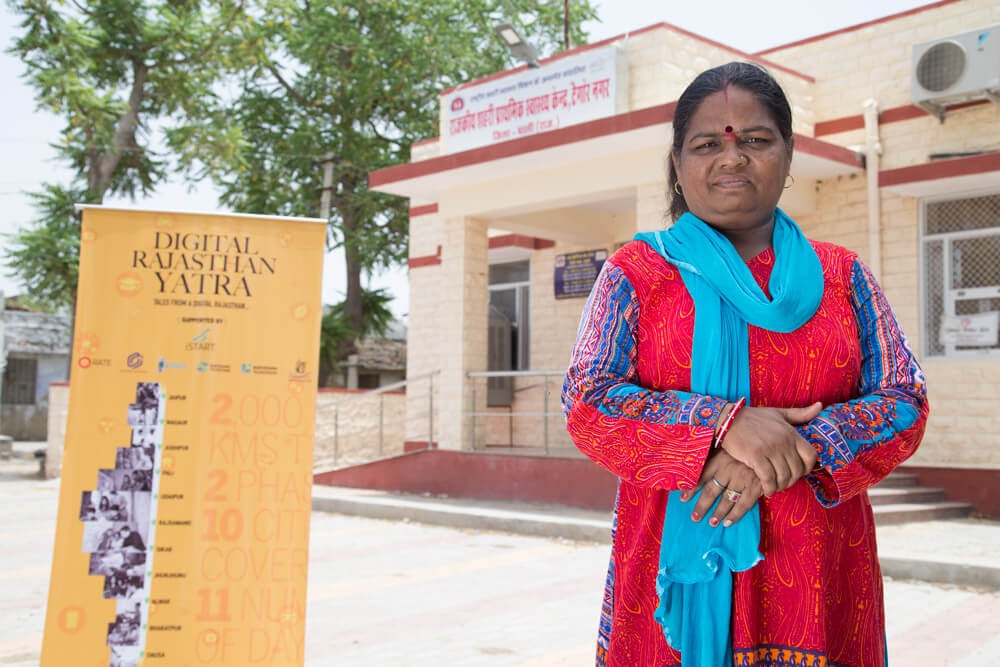
Share this – ![]() Share |
Share | ![]() Share |
Share | ![]() Share |
Share | ![]() Share
Share
The Unexpected Lead To Another Digital Rajasthan Story: ‘RSCIT’
The next stop, Merta in Nagaur district, initially didn’t turn out to be as expected for the Inc42 team as due to some confusion, the scheduled meeting got cancelled. We were left wandering in a little town where the roads were abuzz with activity.
While walking through the village, we observed a few small children going for classes to a coaching institute that predominantly displayed the word RSCIT (Rajasthan State Certificate Course in Information Technology). The team decided to follow the students as they walked up to the coaching class. At the centre, we saw people of all ages sitting at about 15 computers.
This is where the Inc42 team found our next story about digital Rajasthan waiting for us.
We met one Govind Singh, who’s been running Jai Shree Computers since 2004. He started with teaching villagers MS Office and accounting. He also earlier offered a professional course in computers including an introduction to C language, programming fundamentals, and HTML.
“There isn’t any demand here for advanced computer courses because we need to start teaching them from the point of how to hold a mouse,” said Singh.
Singh was quite friendly and got talking further with the Inc42 team about his journey.
“I am from a village which is 22km away from here and I came to Merta city to pursue my higher secondary, but I quit the course to learn computers from Aptech. I did a one-year diploma at Aptech in 2000 and then I finished my graduation privately in arts. After that, I worked at Aptech as a teacher. The idea to start this coaching centre came when Aptech closed down in 2003,” he said.
He took a loan of INR 50K ($726) from the Central Bank of India under the Pradhan Mantri Rozgar Yojana, set up two computers and started teaching computers to the villagers.
“I started RSCIT in 2009 with a batch of just 30 students, including some government employees and others who were preparing for government jobs,” said Singh.
He added that after doing the RSCIT course, students can get clerical-level jobs like registrars in courts and MS Office operators. Many government jobs are making RSCIT compulsory, thereby giving more job opportunities to the state’s youth.
The RSCIT recently made a change where topics related to e-transactions through mobile apps were included; the earlier version included only MS Word, MS Excel, MS Powerpoint, and Internet basics.
Over the years, there has been a steady increase in the number of students doing the course. Earlier, the average enrolment was 15-20 government employees. Now, it is 150-200 every year now, with a majority of the batch consisting of Class X students.
“In the summer, we get between 150-200 kids every year, on an average. There are no enrolment criteria in terms of age or qualifications, but most of them are Class X passouts,” he said.
Singh further disclosed that in a year, the institute earns between INR 3-3.5 Lakh ($4,358-$5,085). “Many of our students pass out and become RSCIT teachers, earning around INR 5K-6K ($72-$87) per month as starting salary (all of them are also preparing for entrance exams on the side),” he added.
The business is seasonal in nature and Singh says once the summer holidays are over, he waits for next April to arrive. To diversify the risk, he has set up a library which charges INR 300 a day. This may seem steep, but he says he has to compensate the running costs, which include a newly installed AC.
It was interesting to learn that the number of boys and girls who enrol for the course is about the same. Singh attributes this to the changing mindset of people, who are now willing to let their daughters pursue higher studies and look for job opportunities.
Singh also recently underwent a training for the Rajasthan government’s e-Sakhi program, where he will train girls aged between 18-33 who will, in turn, go on to educate other people about the nuances of digital transactions.
It was a long day yesterday (July 7) and the Inc42 team is back on the road heading to Pali.
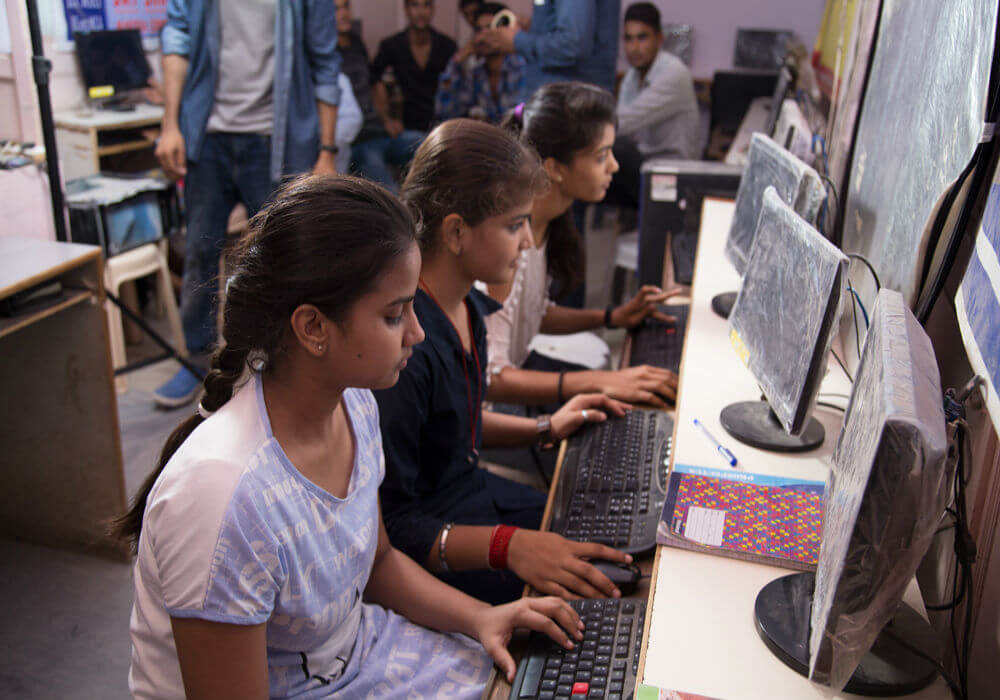
Share this – ![]() Share |
Share | ![]() Share |
Share | ![]() Share |
Share | ![]() Share
Share
E-Mitra, Soil Health Card, Kisan Card, And E-Mandi: Digital Services Are Now Part Of Farmers’ Daily Lives
Time: July 7, 12:00 noon
Place: Gugarwar Village (Nagaur District)
Group Discussion in Nagaur with farmers
Participants: Mangilal, Birlaram, Ramdev, Peparam, Rameshwar lal, Azi Ram
After the visit to Madan Lal’s home, the Inc42 team sat down with a group of farmers underneath a neem tree, with birds chirping, cattle lazing around, and a gentle breeze giving relief from the afternoon heat in the desert state of Rajasthan.
The discussion was aimed at understanding the experience of farmers on using digital services and also the benefits of various initiatives of the government — The Kisan Card, Soil Health Card — for them.
The discussion threw up the following experiences of the farmers:
E-mitra: The local authority of the village or the patwari, as he is commonly called, regularly assesses the farmlands of the village and their yield. As per the data collected by the patwari, the farmers are issued a token from the e-mitra kiosk that they can use at the kisan mandi for further transactions so that payments are made directly into their bank accounts.
The Kisan Card: The Kisan Card enables villagers to avail of loans worth up to INR 3 Lakh ($4.3K) at an interest rate of 7% and at just 4% in case of early payments. The interest amount charged by private moneylenders is a steep 24%.
The Kisan Card, however, has low penetration. Only the farmers associated with co-operative societies were using the Kisan Card. Further, there is no insurance for crops even though the insurance amount is deducted from the loan amount and no other noteworthy insurance benefits are provided.
The Soil Health Card: The Krishi Department regularly checks and furnishes a detailed report on the health of the soil and its components. This is very advantageous to the farmers as they get to know the contents of the soil and can use chemicals and pesticides accordingly for better-quality produce.
Subsidies: The state government offers subsidies of INR 85K ($1,235) to INR 90K ($1307) to build storage areas such as covered sheds or warehouses on their farmlands to store produce. Farmers have to apply for the subsidy when they make such structures, and the amount is transferred directly into their bank accounts.
E-Mandi: The e-mandi has benefited farmers in more ways than one by removing middleman, giving farmers a minimum support price (MSP) as digitising transactions. The challenge, however, is that the government buys part of the crop and not the entire yield. The farmers are then updated about the same via a message on their mobile phones.
The discussion brought forth a mixed bag of experiences on the part of the farmers. Soon it was time for the Inc42 team to drive on to our next stop.
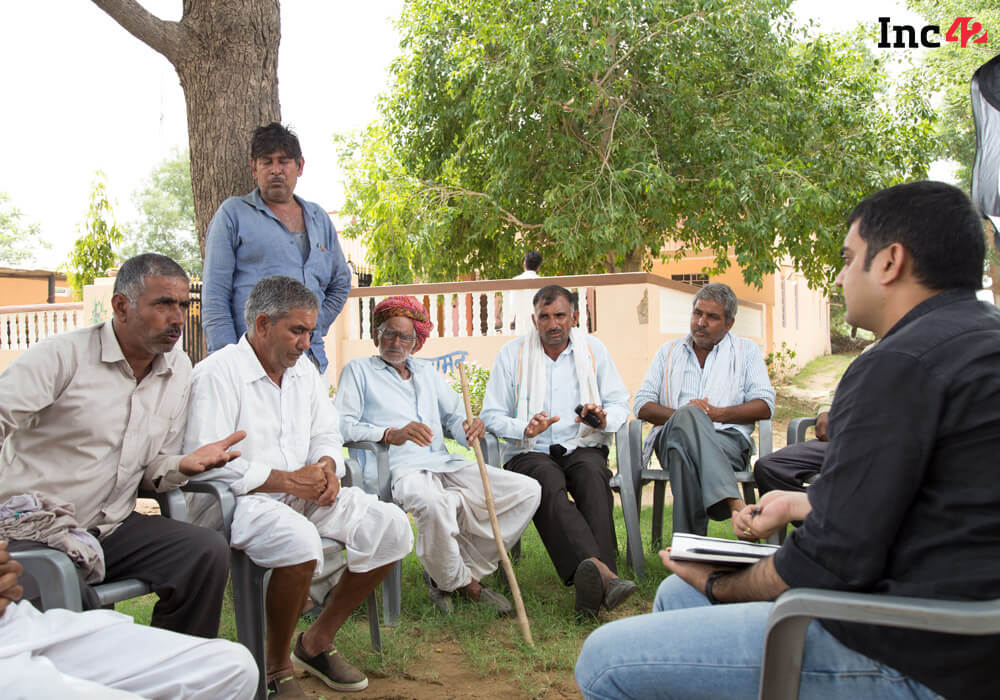
Share this – ![]() Share |
Share | ![]() Share |
Share | ![]() Share |
Share | ![]() Share
Share
E-NAM Mandi System A Boon For Farmers Of Gugarwar Village
The destination for the day was the house of Madan Lal, the father of Rajendra Lora, who has set up FreshoKartz Agri Products, an ecommerce marketplace for fruits and vegetables in Jaipur. Madan Lal and his fellow farmers assembled to meet, greet, and interact with the Inc42 team.
Visit any village in India and the warmth and simplicity of its people is sure to engulf the visitors and that was seen here as well. We were served tea and cold drinks by the hospitable villagers.
Curious about why the Inc42 team was there, the villagers had all sorts of questions about where we came from, the purpose behind our visit, and, most of all, if Inc42 was related to farming.
The villagers were slightly disappointed when they learned that Inc42 had nothing to do with farming but were still eager to tell us their stories. We first spoke with Madan Lal, who’s been a farmer for 25 years. He farmed crops like onion and peanuts in an area that hasn’t seen adequate rainfall for decades.
Selling the produce has been and is a major challenge for farmers like him.
Madan said, “The traditional mandi system does not work and we get below par prices and baffling scenarios where sometimes one set of produce gets two sets of prices in the market.’’
The farmers said that the E-NAM mandi system under which the government buys a part of the produce at the minimum support price has been a huge boon for them. For example, earlier the government used to purchase produce for INR 3,600 ($52.35) but now they do it for INR 4,600 ($66.89). The farmers want this initiative by the government to expand to the whole produce as the cost of farming is going up.
Further, Madan also expressed problems that need the government’s attention. For instance, although everyone in the village has mobile phones, many don’t fully comprehend the information or use of services such as the Internet, with newspapers not being widely circulated in the area. Madan also suggested that the government should run awareness campaigns for the people who are currently in farming so that the schemes created by the government benefit them.
With that, the Inc42 team wrapped up the first half of Day 1, swiftly driving to the next destination.
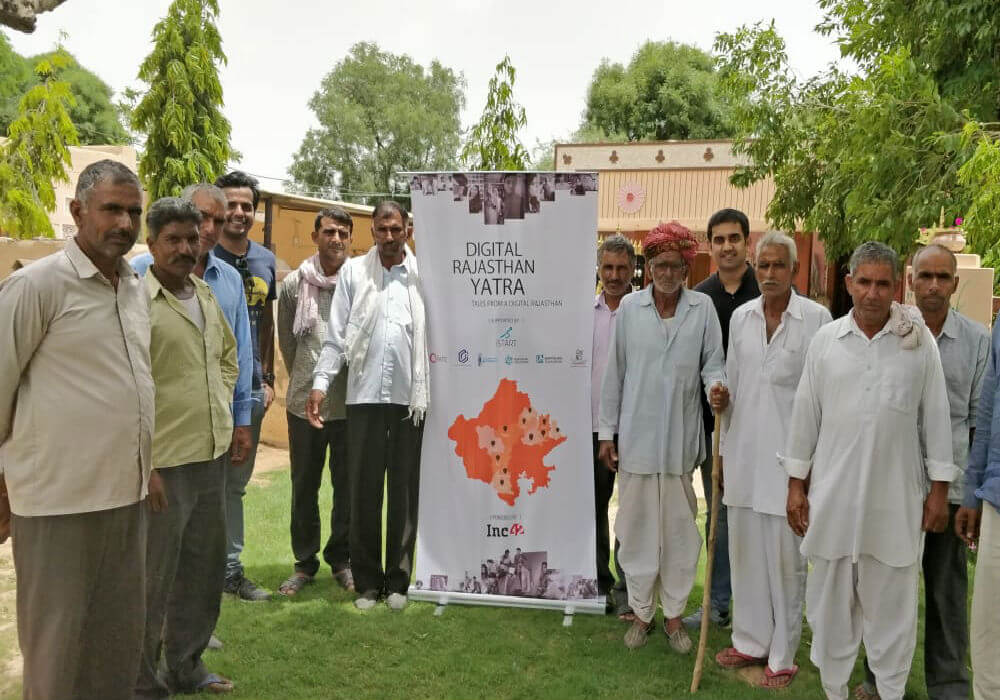
Share this – ![]() Share |
Share | ![]() Share |
Share | ![]() Share |
Share | ![]() Share
Share
Digital Rajasthan Yatra II Begins
The Inc42 team started the first leg of the second edition of its Digital Rajasthan Yatra at 7 am on July 7 by taking the Jaipur Ajmer Expressway to Gugarwar village, a tiny village in Nagaur District of the state. The journey was smooth for the most part — about two hours — owing to the well-made expressway, after which a stretch of 45km till the Gugarwar village was comprised not so smooth, rural roads.
Here, we are, taking a photo-op break by the highway — Shivam Shrivastav, features writer and Mumbai correspondent at Inc42 (left) and Ajith Sharma, project lead for the Digital Rajasthan Yatra.
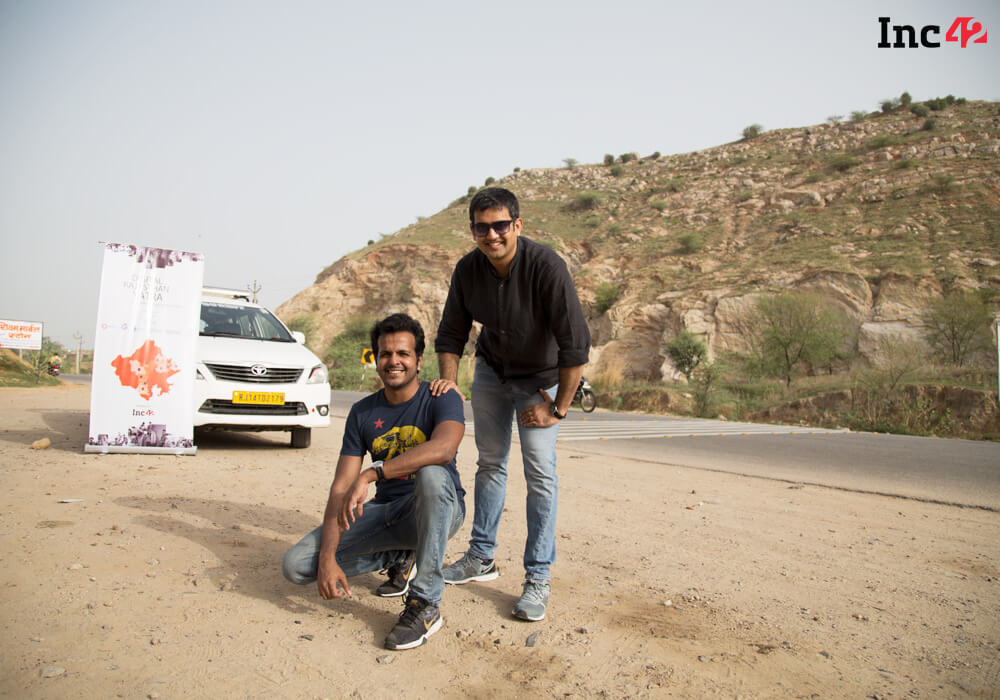
Share this – ![]() Share |
Share | ![]() Share |
Share | ![]() Share |
Share | ![]() Share
Share







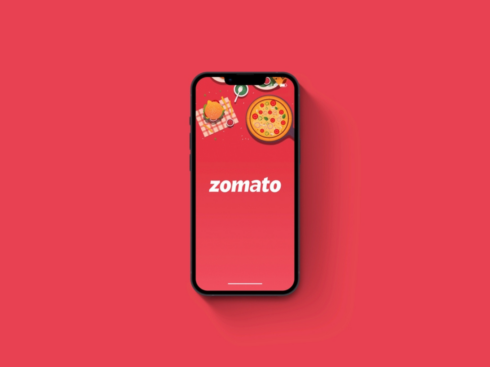

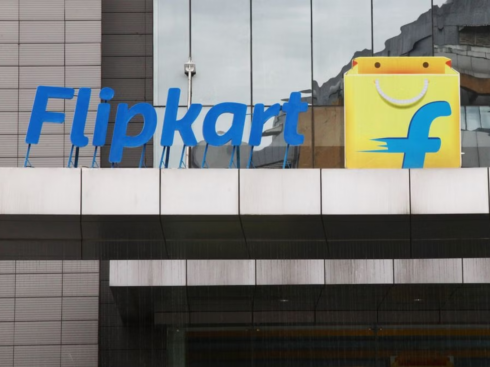
![[Live Blog] Digital Rajasthan Yatra II: Tracking Rajasthan’s Tech Revolution Plan For The Next 10 Years In 10 days-Inc42 Media](https://cdn.inc42.com/wp-content/uploads/2023/09/featured.png)
![[Live Blog] Digital Rajasthan Yatra II: Tracking Rajasthan’s Tech Revolution Plan For The Next 10 Years In 10 days-Inc42 Media](https://cdn.inc42.com/wp-content/uploads/2023/09/academy.png)
![[Live Blog] Digital Rajasthan Yatra II: Tracking Rajasthan’s Tech Revolution Plan For The Next 10 Years In 10 days-Inc42 Media](https://cdn.inc42.com/wp-content/uploads/2023/09/reports.png)
![[Live Blog] Digital Rajasthan Yatra II: Tracking Rajasthan’s Tech Revolution Plan For The Next 10 Years In 10 days-Inc42 Media](https://cdn.inc42.com/wp-content/uploads/2023/09/perks5.png)
![[Live Blog] Digital Rajasthan Yatra II: Tracking Rajasthan’s Tech Revolution Plan For The Next 10 Years In 10 days-Inc42 Media](https://cdn.inc42.com/wp-content/uploads/2023/09/perks6.png)
![[Live Blog] Digital Rajasthan Yatra II: Tracking Rajasthan’s Tech Revolution Plan For The Next 10 Years In 10 days-Inc42 Media](https://cdn.inc42.com/wp-content/uploads/2023/09/perks4.png)
![[Live Blog] Digital Rajasthan Yatra II: Tracking Rajasthan’s Tech Revolution Plan For The Next 10 Years In 10 days-Inc42 Media](https://cdn.inc42.com/wp-content/uploads/2023/09/perks3.png)
![[Live Blog] Digital Rajasthan Yatra II: Tracking Rajasthan’s Tech Revolution Plan For The Next 10 Years In 10 days-Inc42 Media](https://cdn.inc42.com/wp-content/uploads/2023/09/perks2.png)
![[Live Blog] Digital Rajasthan Yatra II: Tracking Rajasthan’s Tech Revolution Plan For The Next 10 Years In 10 days-Inc42 Media](https://cdn.inc42.com/wp-content/uploads/2023/09/perks1.png)
![[Live Blog] Digital Rajasthan Yatra II: Tracking Rajasthan’s Tech Revolution Plan For The Next 10 Years In 10 days-Inc42 Media](https://cdn.inc42.com/wp-content/uploads/2023/09/readers-svg.svg)

![[Live Blog] Digital Rajasthan Yatra II: Tracking Rajasthan’s Tech Revolution Plan For The Next 10 Years In 10 days-Inc42 Media](https://cdn.inc42.com/wp-content/uploads/2023/09/twitter5.png)
![[Live Blog] Digital Rajasthan Yatra II: Tracking Rajasthan’s Tech Revolution Plan For The Next 10 Years In 10 days-Inc42 Media](https://cdn.inc42.com/wp-content/uploads/2023/09/twitter4.png)
![[Live Blog] Digital Rajasthan Yatra II: Tracking Rajasthan’s Tech Revolution Plan For The Next 10 Years In 10 days-Inc42 Media](https://cdn.inc42.com/wp-content/uploads/2023/09/twitter3.png)
![[Live Blog] Digital Rajasthan Yatra II: Tracking Rajasthan’s Tech Revolution Plan For The Next 10 Years In 10 days-Inc42 Media](https://cdn.inc42.com/wp-content/uploads/2023/09/twitter2.png)
![[Live Blog] Digital Rajasthan Yatra II: Tracking Rajasthan’s Tech Revolution Plan For The Next 10 Years In 10 days-Inc42 Media](https://cdn.inc42.com/wp-content/uploads/2023/09/twitter1.png)
